Australian
and international
exploratory
performance and
media arts
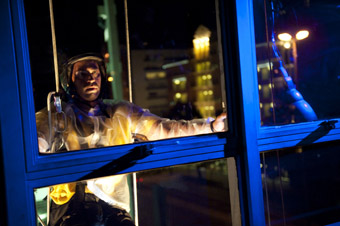
Marcel Costa Kastelo, Vertigem
photo Nelson Kao
Marcel Costa Kastelo, Vertigem
A TYPICAL DAY IN SAO PAULO, BRAZIL’S LARGEST CITY. THE CITY IS IN CONSTANT MOTION; CARS CRAWLING THROUGH GRID-LOCKED CITY STREETS, TRAINS WHIRRING THOUGH UNDERGROUND TUNNELS AND HELICOPTERS BUZZING OVERHEAD. THE RAIN IS POURING DOWN.
It is the Copenhagen week of negotiations on global warming and I am stuck for three hours in traffic because the Tiete River is flooding the motorways that enter the city. My mission in Sao Paulo is to find out about the new generation of contemporary theatre and performance-makers to see what kind of work is emerging from this mega-metropolis.
It’s a long time since I left this town. The contemporary theatre scene is growing and evolving. Sao Paulo has a long history of theatre/performance, strongly rooted in European theatre traditions. The Jesuit priestsa, from the colonial period, created performances for indigenous Brazilian Indians with the aim of converting them to Christianity. These days the contemporary art of Sao Paulo is also influenced by indigenous and African heritage (as a result of many years of slavery), popular US trends and the more recent waves of Japanese, Middle Eastern and European migration to the city. The city’s art scene is a jungle overgrown with dense layers of eclectic, proliferating cultures.
I have arranged a meeting with Silvana Garcia, a researcher, author and expert on the contemporary theatre scene in Sao Paulo. We have planned to meet at a cafe on the Avenida Paulista, one of the most important financial strips in Latin America. International banking edifices tower above the wide pavements of the avenue. Due to certain tax arrangements in Brazil, many of the banks have established their own cultural centres that house theatres and galleries. Itau Cultural, for example, is a gallery space established by a bank (Itau) that also hosts an online archive that documents significant contemporary performance, and curates events such as the series Videobrasil and Ocupacoes. I wander through Itau Cultural’s large installation that explores the life and work of Ze Celso, an important theatre director/writer who continues to exert a strong influence on the new generations of artists in Brazil.
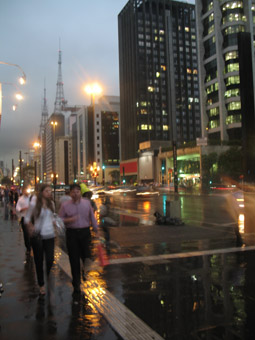
Av Paulista, Sao Paulo
photo Carlos Gomes
Av Paulista, Sao Paulo
ze celso
Silvana Garcia is a lecturer and writer from EAD (Escola de Arte Dramatica), a drama school linked with the University of Sao Paulo (USP). She talked firstly about the importance of Ze Celso, the iconic, militant, anarchic director who has worked continuously in theatre since the 1960s. His Teatro Oficina is a building with a 30-metre-long, narrow-corridor performance space, above which are suspended three levels of scaffolding. From these vantage points audiences witness his anthropophagic, durational performances. Ze Celso’s work dives into social taboos, challenging the puritanical aspects of Brazilian society. For example, what appears to be a religious procession (common throughout predominantly Catholic Brazil) is subverted, and transformed into an assemblage of Dionysian profanities. Sex acts and nudity are emblematic of his shows. His performances launch from the theatre into the streets, stopping the traffic. Prostitutes, homosexuals and black Brazilians (still fringe-dwellers of Brazilian society) are Ze’s heroes. Ze Celso invites his audience not only to observe, but also to participate in his celebrations of the social taboos that can oppress and shame.
Anthropophagy is a fundamental concept in Ze Celso’s work. He borrows this term from the Brazilian modernist writer Oswald de Andrade. It refers to the act of humans devouring their own flesh, as witnessed by the Portuguese colonisers amongst Brazilian Indian tribes. In cultural terms anthropophagy refers to the digestion of the Other in the phenomenology of cultural encounters. If de Andrade sees anthropophagy as the ultimate taboo, the work of Ze Celso employs this “taboo of taboos” as a departure point for his work, transforming taboo into totem. Itau Cultural’s exhibition explores some of the artistic voyages and manifestos of Ze Celso’s extensive career. The online exhibition captures aspects of Ze Celso’s vision and philosophy. Its English version will allow you a glimpse into the life and times of the artist (www.itaucultural.org.br/ocupacao/).
sesc
Silvana then spoke about how this city hosts the most diverse range of artists. From the mid-1990s, changes in the Brazilian government’s cultural policies allowed for greater financial incentives to support cultural activities. Existing organisations such as SESC (Serviço Social do Comercio) also support cultural activities and development. SESC, for example, is a non-government cultural network established in 1946 by the industrial sector of the state of Sao Paulo and other states in Brazil that is supported through tax incentives and employee contributions. SESC is committed to providing services in the areas of health, leisure, culture and social support to populations throughout Brazil. SESC has established a number of cultural sites in Sao Paulo (housing theatres, music venues, libraries, artist studios, galleries etc) that run an extensive program of events every day of the week. These are open to the public and provide discounted tickets for employees of the industrial sector (www.sescsp.org.br).
Danilo Miranda has been the head of the performance department for SESC for the past decade and strongly supports young, emerging groups researching and creating works that interface with the wider Brazilian cultural landscape. SESC also has sufficient resources to invite and host international companies and works. It will buy new work from concept stage and support its development, or will invite an existing work to be presented for an extended seasons, touring through its network of cultural centres in Sao Paulo and throughout Brazil. For many companies SESC provides critical support in both creating and touring work, opening new possibilities for artistic development that would not otherwise be available to them.
Silvana gave me a few names and contacts for companies and venues that would assist my investigations, including Teatro da Vertigem, Grupo XIX, Grupo dos Fofos, writer Mario Bortolotto, Galeria Vermelho, Satyros, Newton Moreno and numerous others. As my time was limited in Sao Paulo, I’ve selected just a few of these companies to introduce to you.
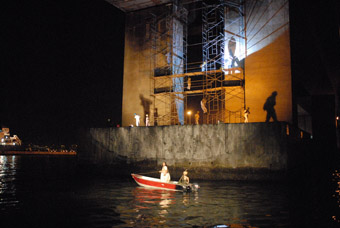
Marilia De Santis, Sergio Pardal, BR3, Vertigen
photo Nelson Kao
Marilia De Santis, Sergio Pardal, BR3, Vertigen
teatro da vertigem: making the city their stage
Teatro da Vertigem is a collective of performer-creators established in 1991 and led by Antonio de Araujo, who also lectures at ECA (Escola de Comunicacoes e Arts) at the University of Sao Paulo. Initially self-funded, the company now receives some financial support from Petrobras, a Brazilian oil company.
I met with members of company in the eighth floor of SESC Paulista, where they were bumping in a new work, Kastelo. From what I can see of the new show, the audience will sit on office chairs around the inner space of the building and the performance will take place on a platform rigged outside the glass walls of the building. What a logistical nightmare! I met with performer Roberto Audio and director Eliana Monteiro to talk about the group. Their work involves an extensive process of research and is mostly presented in non-conventional theatre sites around Sao Paulo. Vertigem’s work exists on the frontier between performance and contemporary theatre.
The group’s most important work, known as the Biblical Trilogy, is a criticism of the social and political degradation of the country. Paraiso Perdido (1992) was performed in a Catholic church, O Livro de Jo (1995) in a hospital and Apocalipse 1.11 (1999) in gaols (referencing Carandiru prison where 111 prisoners were killed by police in a prison rebellion). This trilogy has been presented at national and international festivals.
Talking about logistical nightmares, Vertigem’s latest work BR-3 was performed along five kilometres of the Tiete River that runs through the middle of Sao Paulo. The audience was taken by bus from the Monument to Latin America Complex (a concrete modernist design) to a dark bend in the Tiete River. From this we are invited to board a boat, a kind of floating evangelical church with a neon sign proclaiming, “Jesus is whiter than snow.” On board, the audience is promised salvation by the recorded voice of a dead evangelical minister, the proceedings being conducted by a devoted disciple. The sounds of recorded gunshots mix with the buzz of traffic on the highway beside the river. The dark river and the glittering cityscape beyond its banks are the backdrop for the show. The Tiete is one the most polluted rivers in Brazil—the smell is overwhelming, the pollution a sad reality, the result of rapid, unplanned urbanisation. But there is no way out, and the church boat is our only salvation!
The performance is located in three cities of Brazil, in three different periods: Brasileia, a lost city in Acre near the Amazon River; Brasilandia, a poor suburban area of Sao Paulo where drug trafficking is rife; and Brasilia, the planned, ordered and monumental Brazilian capital. Along the margins of the river, for example, we witness a woman searching for her lost husband, whose cheap labour has been used to build monumental cities like Brasilia.
Vertigem’s BR-3 is created using performers on the principal boat, projections onto passing bridges, small fast boats that circle the main craft and performers with microphones working on the margins of the river. It is a quite confronting, apocalyptic experience witnessing such human desperation. One of the great things about Vertigem is their ability to merge the world of fiction with the real world, leaving us wondering which is which.
After nearly 20 years, Teatro da Vertigem now have their own rehearsal space where they continue to research new works and conduct workshops for each new production. Vertigem also work with local communities, inviting members to participate in their performances. (www.teatrodavertigem.com.br)
artist occupation: transforming the city
Praça Roosevelt (Roosevelt Square), in the centre of Sao Paulo, was in former times a glamorous part of the city, but is now a dark and sometimes dangerous part of town. It was also once the home and workplace of socially neglected individuals, prostitutes, transvestites and rent boys but is now undergoing a process of reformation.
Through necessity (cheap real estate), independent theatre companies have recently moved into Praca Roosevelt, establishing small, versatile theatre spaces that allow artists great freedom in terms of experimentation and artistic risk-taking. The larger established theatres are too expensive for smaller and emerging theatre companies.
Satyros is one such company, and was among the first to establish a theatre space in Praca Roosevelt approximately 10 years ago. Led by dramaturg Rodolfo Garcia and actor Ivam Cabral, the group has become one of the most controversial in Brazil. In many instances their work, like that of Ze Celso, reflects the universe of sexual and social minorities, and the marginal world of the site in which they are based. Their works have included Sappho de Lesbos (by Ivam Cabral and Patricia Aguille), Filosofia de Ancova (devised from the works of the Marquis de Sade) and Transex, performed by Phedra D Cordoba (a transsexual who formerly lived at Praca Roosevelt and who has become an important artistic collaborator with the company).
In 2005 the company presented German writer Dea Loher’s A Vida na Praca Roosevelt (based on the inhabitants of the square). It was awarded the prestigious Beckett prize in Germany. The company has shown its work in major festivals in Brazil, and throughout Latin America and Europe.
Now the Square has eight new venues (theatre spaces complete with bars and cafes) that present many diverse styles of performances, becoming a vibrant part of the cultural landscape of Sao Paulo.
There is currently a redevelopment project underway, supported by the government of Sao Paulo, to renovate the square and to build a school of performing arts on the site for about 1000 students a year.
Historically Praca Roosevelt has received very little support from the politicians, other artists and the media (some journalists refused to attend the performances). A decade later, the artists who ‘occupied’ Praca Roosevelt and who believed in their artistic utopia feel that they have conquered both the Praca itself, and won the respect of their peers, politicians, the media and society at large. The persistence, creativity and hard work of these artists have inspired other small companies to initiate their own ‘occupations’ in other parts of the city.
Cracolandia (so called for the prevalence of the drug crack) in the old historical part of Sao Paulo is also undergoing an arts-led transformation. Work will shortly commence on the construction of a centre that will become the home of the contemporary dance scene in Sao Paulo. Swiss architects Jacques Herzog and Pierre de Meuron, known for their bird nest Olympic Stadium in Beijing and the Tate Modern in London, will design the building.
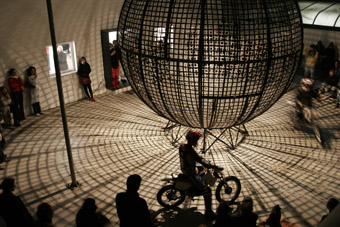
Christiana Moraes, Andre Nunes, Globo da Morte, VERBO
courtesy Galeria Vermelho
Christiana Moraes, Andre Nunes, Globo da Morte, VERBO
verbo international performance festival
At the end of Avenida Paulista is Galeria Vermelho, a commercial gallery that represents a number of important Brazilian contemporary artists. The building itself has grown into a series of rooms, corridors and courtyards that, for a week in June, hosts a number of live performance works from local and international artists in a festival called VERBO, is one of the most important performance events in Brazil’s arts calendar.
VERBO is now in its sixth year. One of its curators, Marcos Gallon, explained that it sprang from the need of young and emerging artists to have a space where their work and concepts could meet the public. The director of the gallery, Eduardo Brandao, together with a number of curators selects the works. Marcos described how, during the early days of VERBO, they tried to accommodate the demands of all the performing artists wanting to be part of the festival so that hundreds of “action” performances would take place during the festival. Now the director and curators select just 50 events for gallery space and in public spaces in the city.
VERBO takes place in June and is open to any artist who submits an artistic proposition. There are also a number of seminars, workshops and publication launches presented with the support of FUNARTE (Fundaçao Nacional das Artes) and Centro Cultural Sao Paulo, two major arts organisations in Brazil. Applications to the festival are made via www.galeriavermelho.com.br. An English version of the application process can also be found on the website as Galeria Vermelho is very interested in Australian performance. The versatility of the space can host a diverse range of work.
Performance in Brazil originates largely from the 1970s and has been influenced to a large extent by European ideas and concepts. The body is the main performance subject as are ideas around it such as informatics, bioethics, the body as a weapon etc. A new generation of performance artists in Sao Paulo is creating work that explores the quotidian body, the socio-political realm and urban street culture in response to their city. PUC (Pontifical Catholic University) and Faculdade de Belas Artes have specific courses on Performance and the Art of the Body. The major universities and the visual arts department are creating generations of artists who are expanding the ideas of performance art by fusing new media, dance and voice.
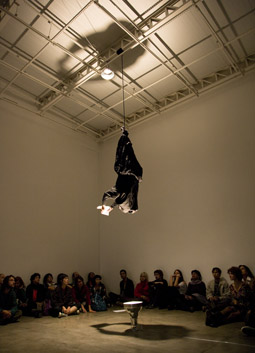
Nezaket Ekici, VERBO 2009
courtesy Galeria Vermelho
Nezaket Ekici, VERBO 2009
Marcos described some of the performances that have been part of VERBO, to give an idea of how Galeria Vermelho comes to life in a week of contemporary performance. Turkish artist Nezaket Ekici dressed in a burka is rigged upside-down from the ceiling, reading, then dropping to the floor, newspaper articles about the injustices and violence suffered by Islamic women. Outside in the courtyard a truck arrives, full of concrete bricks. Artists Caroline Mendonca and Bruno Freire construct, deconstruct and re-construct a 20 metre wall, transforming and redefining and reconfiguring the public space of the gallery. Los Torreznos, a collective from Spain, have a more direct interaction with the public, creating political and social discussions, improvising vocally on the themes of El Cultura and El Dinero, making a humorous critique of this territorium.
In a white gallery Marco Paulo Rolla (an important Brazilian performer) creates Suando e Resistindo (Sweating and Resisting), a compelling and risky performance where three performers create a choir of voices interspersed with the sound of breaking house objects. Nancy Mauro-Flude (Australia/Holland) performs Paraphernalia, a karaoke cabaret performance with break beats, noisy guitars, pop, punk rock influences with a trash aesthetic.
Les Gens D’Uterpan (France) is a dance collective that constructs its choreographies in different parts of the space, contrasting harsh and violent acts where their bodies are in intense collisions with serene dances where the dancers dribble saliva over each other as they move smoothly through the space. A big metal sphere is built to the sounds of two revving motorbikes in Globo da Morte (Death Globe), creating great expectation. The sphere is completed,but the act remains unconsummated. The sphere is dismounted, frustrating an audience that asks, ‘Where is the spectacle?’
* * * *
Sydney and Sao Paulo share similarities but there are also vast differences in their respective cultural practices. What can they learn from each other? I am excited by the idea that maybe one day they will establish a dialogue that explores their respective artistic natures. For example, Verbo’s presentation of hybrid arts practices and its focus the performative body make it a relevant point of contact for Sydney artists who share similar preoccupations. What cultural specificity can be discerned in Verbo’s representation of the body? Perhaps a Sydney institution will one day host a Verbo festival. Links between venues in Australia and SESC could create a network of cultural exchange allowing for the introduction of Australian artists to Brazil, and vice versa. I see great possibilities in small independent performance companies in Sydney and Sao Paulo leading the exchange.
RealTime issue #95 Feb-March 2010 pg. 42-43
© Carlos Gomes; for permission to reproduce apply to realtime@realtimearts.net
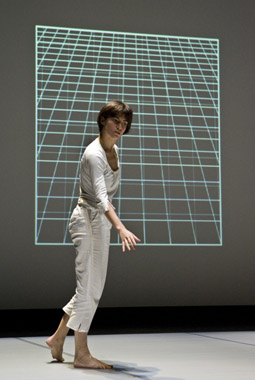
Elena Gianotti in Episodes of Flight, 2008 by Rosemary Butcher and Cathy Lane
courtesy the artists
Elena Gianotti in Episodes of Flight, 2008 by Rosemary Butcher and Cathy Lane
LATE LAST YEAR, CRITICAL PATH HOSTED TWO WORKSHOPS BY CHOREOGRAPHERS WHO MAKE VERY DIFFERENT WORK, BUT WHO ARE LINKED THROUGH A COMMON EXPERIENCE OF EPIPHANY WHEN MEETING THE WORK OF JUDSON CHURCH CHOREOGRAPHER, YVONNE RAINER.
French choreographer Xavier Le Roy, in his piece, Product of Circumstance, cites performing in a company which recreated Rainer’s works as a major shift in his understanding as a dance maker (and was introduced to audiences in Sydney by Amanda Card with a lecture that began with Rainer’s famous No Manifesto). UK choreographer Rosemary Butcher, who uncannily describes her meeting with Rainer as not so much luck but circumstance, is upfront about how her time in New York in the late 60s and early 70s profoundly changed the work she made on her return to the UK.
Butcher was in Sydney with her collaborative partner, composer Cathy Lane, to lead a month-long research project through Critical Path and Campbelltown Arts Centre (CAC) called the Composers and Choreographers Lab, in which I participated and the results of which were screened as part of CAC’s What I Think About When I Think About Dancing exhibition. Despite having made work over the last 30 years and being one of the leading proponents of new dance in the UK, Butcher’s choreography is not well known in Australia. This is possibly because she has constantly challenged conventional forms of dance, which makes her work appear somewhat difficult (a recent review in London admits that her audience is small but dedicated), and because she has only been touring outside of the UK since 2000, after making her first piece in collaboration with Cathy Lane, Scan.
The effect of working with Rainer in New York for Butcher was the total shift in understanding as to what sort of movement could constitute dance, and the performance of this dance outside of the conventions of the theatre. Butcher says, “I do not know, in my background, why I should have been so suddenly so disconnected with the formal and the theatrical, but I responded to another way of thinking, and I think, felt as if I could create with that in mind in a much freer way than if I’d stayed within a wider construct.” The first work Butcher made in the UK after this period was performed at The Serpentine Gallery at a time when, she says, “everybody seemed to be working for free and there was sort of an idea that things just happened at that time and then they disappeared. They weren’t recorded very well. There was no sense of continuity but there were a lot of people putting things on.”
This initiated her long interest in researching “how to transfer the ideology and methods of making visual art into the dance world and into the choreographic world”, which has led her work to a focus not only on the visual but also on notions of space and duration.
“[F]or a long time the formal time-based way you come to a show and you’re presented with something and you clap and you go away [has] always slightly worried me, though I’m a performer at heart and a director and love the theatre…[But] I’m less interested in it and would like the work to be far more along the traditions of how visual art is viewed, where you spend as long or as little time as you want within your experience, but it’s entirely up to you as to how, when, where etc that you experience it. You’re not brought in and curtailed and asked to see something at a particular time.”
Butcher’s movement palette consists of a dancerly version of pedestrian or everyday movement, but requires a precise and detailed virtuosity from her performers through her choreographic treatment of this material, which is expanded and amplified through repetitions and changes of speed. “There is a consideration of duration. There’s a consideration of how a particular framework will allow something to be seen very particularly or, if you increase the number of times that you see it, the volume of the experience is bigger. Instead of changing and developing an idea, to me it’s very interesting if it recurs. The scale is bigger though in fact the movement is still the same.”
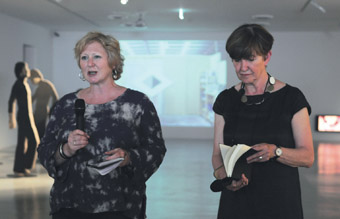
Rosemary Butcher and Cathy Lane, What I Think About When I Think About Dancing Artist Talks
photo Heidrun Löhr, courtesy Campbelltown Arts Centre
Rosemary Butcher and Cathy Lane, What I Think About When I Think About Dancing Artist Talks
However, for Butcher the choreographic material is only one part of her work, and she contends that it is set up to be watched with other layers and frameworks. She has consistently collaborated with artists from other fields, including contemporary art, architecture and music, and has worked with composer Cathy Lane for the last 10 years. Their collaboration is particular in that they begin discussing concepts and ideas together, swap books and research material throughout the creative process but make their work in parallel, only bringing it together in the last weeks. This allows an autonomy of form, and the audience is able to watch the dance in relation to the music and visual elements, rather than seeing them as a whole. Butcher says she wants her audience “to view the work as a non time-based medium, that they’re experiencing sensation and feeling, and that all the ideas within the making are shown through the way the performance is executed. Of course I want people to understand it, but I also don’t expect it not to be difficult. And people do get lost within it. There’s a lot going on but it doesn’t register with everyone; but then I wouldn’t want to lead people directly to it, so I have to take the consequences.”
Rosemary Butcher and Cathy Lane Residency: Composers and Choreographers Lab, Critical Path, Campbelltown Arts Centre, What I Think About When I Think About Dancing, Campbelltown, Sydney, Nov 16-27
RealTime issue #95 Feb-March 2010 pg. 32
© Jane Mckernan; for permission to reproduce apply to realtime@realtimearts.net
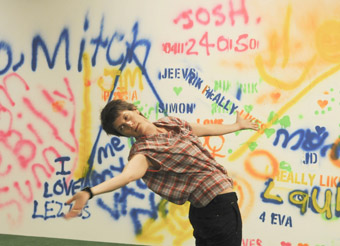
Rosie Dennis, Loving You In Public, Artist Talks, What I Think About When I Think About Dancing
photo Heidrun Löhr
Rosie Dennis, Loving You In Public, Artist Talks, What I Think About When I Think About Dancing
WHAT I THINK ABOUT WHEN I THINK ABOUT DANCING IS A CAMPBELLTOWN ARTS CENTRE PROJECT THAT SEEKS TO INVESTIGATE THE “INTERSECTIONS OF CONTEMPORARY DANCE AND VISUAL ART.” ON A STEAMY FRIDAY NIGHT, IN THIS ART GALLERY FAR AWAY FROM THE CITY, THE OFFICIAL LAUNCH IS FULL OF ACTIVITY: STATIC ART, VIDEO ART, DURATIONAL PERFORMANCE, MASHING SOUNDTRACKS AND A CHIRPING CROWD. BY THE TIME THE PERFORMANCES BEGIN SENSORY OVERLOAD IS ALREADY APPROACHING.
In this fulsome atmosphere, dance is cast as a visual art aesthetic event. White walls replace the theatrical black box, and this bright and partitioned shininess throws the dancing body into sharp relief. Colour radiates and frames the performer as artefact.
Rosie Dennis creates a poignant pastiche of poetry, music, movement and instantaneous art. She speaks quietly, making me lean into her words, words I cannot quite grasp. The pull of these almost inaudible whisperings lies in a poetics of repetition and rhythm. She begins to dance a Rosie Dennis dance: odd, detailed and slightly tortured. Her body twitches and stretches, it stops and starts, swaying through syncopated and mellifluous states. As always with Dennis it is a dance not danced before, a dance with potent individuality. But it is all too short and will be rendered almost lost amidst message and aesthetic.
Thus begins what Dennis call the “soapbox section.” It is a political monologue; tightly written and delivered with an understated intensity that actually deepens its heartfelt subjectivity. Almost apologetic, Dennis’ quiet voice escapes and wanders in an almost-anti-projection that steers her Equal Rights monologue away from rant.
She silences herself by dancing a solo waltz: pitifully lonely with its empty outstretched arms. It is the dance of lack, of the human left bereft. But all is well. Her arms are soon filled with the lover who makes her smile. Other couples join them. These couples, dancing out real life love, perform publicly what is usually private. Audience becomes voyeur at a romantic dinner, an intruder in foreplay. It is both uncomfortable and touching.
This is a poignant piece which lingers but never drowns in saccharin, saved from a too, too sweetness by the poetry of repetition and rhythm, by Dennis’ unique movement style, by performative simplicity and by the sparse but stark palette of colours. In the bright white light of the art gallery, the ‘turf’ beneath the performer’s feet is green green, a music stand is blue blue and the various anonymous performers stencil their love names in bright spray paint, leaving traces of their real life romance like hearts carved in a tree.
Almost immediately we all turn around to watch a performance by Brown Council. The familiar strains of “Black Betty” create an ‘oh yeah, here we go’ ripple and after all that lovin’ and sweetness ‘let’s see some sex’ and nothing says sex like the rock strains of Ram Jam’s 70s hit. With the performer sharply lit and luridly dressed in pink tasselled cowboy gear and insanely high heels, the opening sequence is restrained and tottering, foregoing both the wild unabashed revelation of flesh and the titillating promise of tease. This is more Ralph magazine than transgressive burlesque. After the shoes are discarded the dance becomes softer, slower, deeper and definitely sexier. The performer brings out the oil and drenches her arched and prone body, over and over again. But where is the tease, the delicacy, the subtlety?
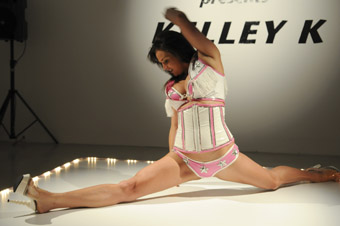
Brown Council presents Kelley K; What I Think About When I Think About Dancing
photo Heidrun Löhr
Brown Council presents Kelley K; What I Think About When I Think About Dancing
Is this irony? A statement on the nature of dance, gender, politics? Is it the arty setting, with the arty crowd watching a puff pastry debauch that constitutes the titillation? Does the dislocation of context create a new set of meanings?
Brown Council is a Sydney-based performance group who play with the rearranged and reclaimed image, especially the fetishised female form of popular culture. Here, the four members—Kate Blackmore, Fran Barrett, Kelly Doley and Diana Smith—are strangely absent, even though the performance bears their name. The dancer is in fact Kelley Kae, a professional stripper hired by Brown Council for the project. While it is clear they want to say something about dance, the body, gender, politics and the artistic economy, Kae’s performance does not make these statements clear. Her name is missing from the printed program and this anonymity objectifies and ‘castrates’ her, casting her as stripper rather than artist. Sadly, there is no full monty or happy ending, just the lingering question: why?
The spray painted epitaphs from Rosie Dennis’ romance dance leave traces, letting love linger in this sharply coloured setting. Her bodies entered and changed the space, then left, transforming performance into artefact. Here was an ‘intersection’ between dance and visual art, a comment on fleeting yet resilient temporality.
What I Think About When I Think About Dancing, Campbelltown Arts, Centre, Campbelltown, Sydney, project launch Nov 27, Nov 16, 2009-Jan 2, 2010
RealTime issue #95 Feb-March 2010 pg. 33
© Pauline Manley; for permission to reproduce apply to realtime@realtimearts.net
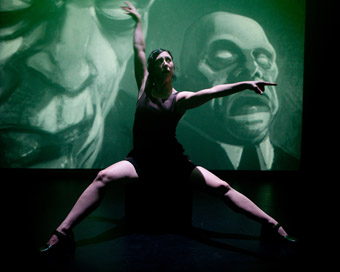
Lisa O’Neill, The Pipe Manager
photo Sean Young
Lisa O’Neill, The Pipe Manager
2009 WAS A PRODUCTIVE YEAR FOR FREELANCE DANCE, THEATRE, CONTEMPORARY PERFORMANCE AND NEW MEDIA PRACTITIONER LISA O’NEILL. TWO WORKS THAT HAVE BEEN, WELL, A LONG TIME IN THE PIPELINE, ACHIEVED A FINAL APOTHEOSIS.
Apotheosis seems the appropriate word in this context. Rave reviews for her performance in The Pineapple Queen which premiered at La Boite Theatre earlier in the year were an indication of O’Neill discovering new depths of dramatic prowess [RT93]. An apotheosis of a metaphorical kind served as the expression of artistic freedom in O’Neill’s off-beat take on the creative process itself, The Pipe Manager, where she is back on familiar territory as a leading exponent of dance theatre.
This solo show is sold as “a dark and quirkily comic journey through bureaucratic insanity.” O’Neill’s character superficially resembles the hardboiled investigator in conflict with greedy corporations. With a nod to Dorothy, she puts on her green shoes, ready to go for it. The storyline is radically out there. She is hired by the menacing Peers Pipe company as a pipe innovator. With her own reputation as a peerless innovator, O’Neill’s pursuit of this hopeless task is lovely self-satire. She also has endearingly long obsessions. The menacing Board of Directors are caricatured as an alien species, as Yetis—self-referential to an early signature dance work, Sweet Yeti.
Two projection screens with a gap in between for exits and entrances. A cube and a pipe. The story is uniquely told by switches between O’Neill performing live on stage and the story book adventures of her onscreen double. This oppressive fantasy world is rendered adult comic book style by master illustrator XTN and given cohesion by Guy Webster’s understated but menacing and dramatically effective sound design. The live O’Neill is playful, seductive and forceful in turns. All her movements, whether tentative, minimal, balletic or frenzied mechanical repetitions, are riveting. Even in taking on an absurd commission, there is warmth here as well as precision, a real curiosity that is at the heart of play: a desire for interaction wherever it may lead that is in contrast to product-obssessed, profit-orientated Yetis. O’Neill’s escape from Yetiland was a coup for lighting designer David Walters whose laser lighting produced the breathtaking effect of O’Neill walking through a drawing of herself, caught in a world where dimensions slipped and slid. She disappears into a fierce light backstage.
In his program note, writer Peter Berkahn says that his story “homed in on the human need for endless rejuvenation, which was suggestive of a quest for humans wanting to be a ‘God Head’.” The journey thus undertaken may have provided no ultimate answers nor, indeed, lead to any real life outcomes. O’Neill wrily remarks that “the irony behind making the work is that in one way The Pipe Manager became about making The Pipe Manager…” O’Neill’s triumph over Yetiland, however, lay in the apprehension that she so effortlessly and sensuously realised in performance but which seemed left up for discussion in this otherwise pertinent gem of a piece. She embodied the notion that—beyond God Head, beyond creation ex nihilo—the artistic imagination may require both the ecstasy of abandonment to what is other, and the self-possession of mastery. O’Neill didn’t disappear into an absorbing God. She remains, to our joy, a dancer on the edge of infinity.
The Pipe Manager, creator, performer Lisa O’Neill, writer Peter Berkahn, illustrator XTN, sound composer & designer Guy Webster, dramaturg Kathryn Kelly, lighting designer David Walters, graphic design Jaxzyn, costume design, Glen Brown, artistic consultant Keith Armstrong; Visy Theatre, Brisbane Powerhouse, Nov 18-21, 2009
RealTime issue #95 Feb-March 2010 pg. 34
© Douglas Leonard; for permission to reproduce apply to realtime@realtimearts.net
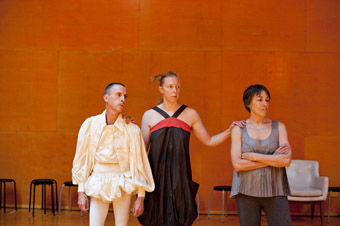
‘wildcard’ performers Trevor Patrick, Joanna Lloyd, Helen Herbertson, Full Colour
photo Rohan Young
‘wildcard’ performers Trevor Patrick, Joanna Lloyd, Helen Herbertson, Full Colour
HELEN HERBERTSON EXCHANGES SMILES WITH OTHER DANCERS, THEN WALKS TO THE CENTRE OF THE ROOM. THE ORANGE AURA OF THE SPACE (STAINED WOOD) IS INTENSIFIED BY THE PRESENCE OF A CURVED STREET LAMP. THE LAMP RECALLS FILM NOIR SCENES—A SINGLE LIGHT SOURCE SOFTLY ILLUMINATES A DARK WORLD. OUR KNOWLEDGE OF THAT WORLD IS CIRCUMSCRIBED. THERE IS NO PANORAMIC, GOD’S EYE VIEW.
Lasica often makes use of the spectator’s limited perspective, drawing upon a hidden score or creating a panorama which cannot be fully taken in. Sometimes a narrative lurks beneath the action, inaccessible or unconscious. Other times, multiple activities are superimposed so that the viewer must make choices about who and what to watch.
This time, inaccessibility is built into the structure of the piece and it is Shelley Lasica who must stay in the dark (choreographically speaking). Full Colour is performed by three dancers and one ‘wildcard’ performer each night. The latter has a certain leeway which the others do not. My wildcard was Helen Herbertson. Her beginning was particular to her body and her persona. The exchange of smiles was an indication of her own pleasure. Her taking the centre of the room was a momentary choice, a spur of the moment decision—unrepeatable.
Herbertson starts by flexing her hands, beginning at the periphery of the body, a distal origin. I suspected this was not Lasica’s movement material. Lasica’s arm movements are very distinctive, even when taken up by another body. She also has a preference for cross lateral connections made in the torso, which then spread out into the limbs. She composes staccato moments, perhaps a fall taken into a step; reassemble, reorganise, stop. Start again. None of this was apparent in Herbertson’s assay into motion.
Once begun, other bodies enter the fray, more recognisably mimeses of Lasica’s own body. I always enjoy watching others perform Lasica’s style, taking up her movements in the context of their own bodies. Deanne Butterworth has been doing this for some time. There is a plushness to her movement, a sort of peachy thickness which gives life to the material. Kyle Kremerskothen is newer to the task, but it is still clear that this is what is happening. This intense difference, between the wildcard’s improvisational work and the fixed material apparently performed by the others, sets the scene for Full Colour. It is as if the three performers (Lasica, Butterworth and Kremerskothen) are incarnations of the one persona in contrast to the wildcard.
Relationships emerge through physical proximity. Although interested in narrative and human relations, Lasica keeps the dramatic canvas spare. The responsibility for any interpretation of events and relationships lies squarely with the spectator, so much so that I cannot fully determine what Full Colour is about. I could say the work is about people in relation to each other. To that extent, Full Colour is not just about movement, it is about the movement of our lives. The wildcard does the trick in this respect, especially in Herbertson’s hands, for her personable interactions with the dancers suggests a human dimension over and above the human fact of dancers dancing. When she dances with Butterworth, it seems that a worldly project is underway. Although unclear what precisely that endeavour is, the feeling is that life has been abstracted.
What is it that allows for such abstraction? The bodies themselves are fully concrete. I think it is that the narrative dimension is underplayed. Theatrical forms of dance often show what they are about through creating recognisable stories or settings. We are at a train station, in someone’s home or in the bedroom; this is about a couple who are fighting or a group of energetic youths. Although there is a dramatic element to some of Lasica’s works, and to Full Colour in particular, its content is not laid out for the spectator. There are no surfaces, only depths. We have to work at interpreting any human drama. Furthermore, these interpretations are provisional, fleeting projections.
In this sense, my perceptions are only temporary illuminations. Lasica has left a lot unsaid and, in doing so, given space to the observer to meet the action. The music also refuses to determine the tone of the dancing. It gently supports the flow of movement. If this is in full colour, then it is watercolour, calligraphy, a picture created from momentary flows and constellations, the thickness of preconceived phrase material against the human tendency to perform oneself.
Full Colour, A dance performance, choreographer, director Shelley Lasica, dancers Shelley Lasica, Deanne Butterworth, Kyle Kremerskothen, with Wildcards: Helen Herbertson, Trevor Patrick, Jo Lloyd, Phillip Adams, sound Milo Kossowski, Morgan McWaters, lighting: Bluebottle, Ben Cobham, diffusion Rachel Young, Chunky Move Studios, Melbourne Dec 10-13, 2009
RealTime issue #95 Feb-March 2010 pg. 34
© Philipa Rothfield; for permission to reproduce apply to realtime@realtimearts.net
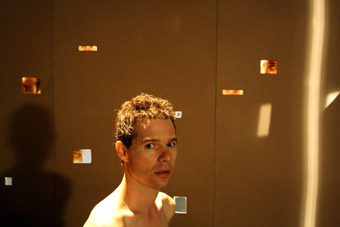
Jonathan Sinatra, The Voyeur
photo Rachael Parson
Jonathan Sinatra, The Voyeur
CLARE DYSON’S WORK HAS ALWAYS STRUCK A BRIGHT NOTE ON BRISBANE’S INDEPENDENT DANCE SCENE, BUT SHE HAS BEEN ELUSIVE AND DIFFICULT TO PIN DOWN BECAUSE HER RESTLESS UNDERTAKINGS HAVE TAKEN WIDELY DIFFERENT FORMS. IF ANYTHING, DYSON’S HIGHLY IDIOSYNCRATIC APPROACH MIGHT BE LIKENED TO A CUBIST PAINTER ANALYSING THE SURFACE APPEARANCE OF THINGS.
Nevertheless, there is a definite ‘Dyson-effect’, a sympathetic vibration that travels with us back into daily life but isn’t attributable to any consistent aesthetic element. Instead, there’s always been what I’ll call a ‘community’ of effects distilled into Dyson’s distinctive emotional tone.
Dyson’s latest offering, The Voyeur, is part of a larger doctoral research project looking at how audiences engage with contemporary dance. As such, it lightly carries scholarly references to 1970s performance art, or the even earlier experimental theatre of Polish director Jerzy Grotowski. Like Grotowski’s ‘holy’ theatre, Dyson’s audience is limited in size and configured as a vital part of the performance. Bruce McKinven’s design consists of a room constructed from heavy ply on the bare stage at QUT Gardens Theatre. The audience is given the choice of watching through multiple peepholes that provide access to a more or less partial view of the performance. They can listen through headphones to either one of the nakedly confessional texts produced by the two performers, but not both.
The room reflects a student bohemia from the past, indicated by a record collection and an old style gramaphone. The action is nostalgic, reminiscent of evenings we all remember when we resorted to playing our favourite records in an attempt to be understood by ‘the Other’, significant or otherwise. Records chosen ranged from Harry Belafonte to Iggy Pop, and Phillip Glass’s retrospective collection Glassworks. Two ‘lovers’ face one another, intimately looking into each other’s eyes. They are smiling tenderly, but knowingly, for there is danger here as well as promise.
Whole worlds might be exchanged in such encounters, but there is always the possibility of violation in one’s depths. The two play a game of slapping and sparring, testing the waters until, apparently unable to sustain the nakedness and vulnerability inherent in each other’s gaze, they break away, each to their own self-contained world. This was the leitmotif for the performance, and duplicated our own atomised responses as an audience of voyeurs individually consigned to play out a perversely ritualised, collective role. Shuffling, bending, peering through monoculars, we paid no heed to each other, even avoided each other’s eyes. Particularly we ducked the gaze of watchers concealed behind opposite walls lest we find ourselves in the position of the voyeur in Barbusse’s L’Enfer who peers through a keyhole only to be shocked to meet another eye staring back.
The more urgently, the more desirously we sought to become intimate with the performers, to enter their private worlds or perhaps simply to make the disparate elements of the performance cohere, the more we were forced to acknowledge our own gaze mirrored in their presence, to find that it was the recalled intimacies in our own lives that we must confess, the raw nature of our own desires that really counted. Dyson tells us through the headphones that research shows it takes the average audience member 15 minutes to fantasise about what it would be like to have an intimate relationship with the performer. She lethally evokes and simultaneously mocks desire as she slowly slices through a passion fruit on her bared thigh. As the juices run and her eyes seek us out, she obligingly personifies the object of desire. That the moment is bracketed, however, points to the performer as emptied of all real characteristics and substance. She is fulfilling a symbolic function, reflecting back the projection of our own narcissism. If you had been on her ‘track’, you were both aroused and at the same time felt completely exposed. Exposed in the sense of Lear and the Fool on the heath in the middle of a storm: that is to say, without shelter.
Dyson cites philosopher Emmamual Levinas to the effect that an encounter with ‘the Other’ is the only way of revealing the truth about ourselves. The interacting subjectivities of the performers—through what I would describe as the naked effrontery (in the sense of a scandal) of their texts, and in movement that comfortably existed in the here and now, in this time spot (however past)—showed us that unsheltering in Levinas’s sense can become a homecoming and a healing. This was ambiguously spoken for in Dyson’s Magdalene-like action of washing Sinatra’s hair, and in Sinatra’s self-absorbed jouissance in a dance to Iggy Pop’s Lust for Life while she sweeps the floor, but could only truly, finally be mediated, in Dyson’s wonderful dispensation, her gift to us, by the despicable voyeur, her audience.
The Voyeur, creator Clare Dyson, choreography, performance, text Clare Dyson, Jonathan Sinatra, dramaturg Kathry Kelly, lighting design Mark Dyson, design Bruce McInven, QUT Gardens Theatre, Brisbane, Nov 22-25, 2009
RealTime issue #95 Feb-March 2010 pg. 35
© Douglas Leonard; for permission to reproduce apply to realtime@realtimearts.net
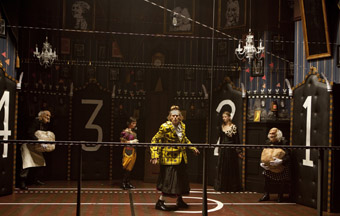
Willem Dafoe, Alenka Kraigher and the company, Idiot Savant
photo courtesy Public Theater
Willem Dafoe, Alenka Kraigher and the company, Idiot Savant
OF ALL THE PRODUCTIONS TO VISIT AUSTRALIA LAST YEAR, TWO OF THE BEST WERE NATURE THEATER OF OKLAHOMA’S NO DICE AND ELEVATOR REPAIR SERVICE’S GATZ, THE FORMER A SPRAWLING EXAMPLE OF VERBATIM THEATRE AT ITS MOST EXTREME AND POETICALLY INANE AND THE LATTER AN INVENTIVELY STAGED READING OF F SCOTT FITZGERALD’S THE GREAT GATSBY. ASIDE FROM LENGTH—BOTH WERE IN THEIR OWN WAY EPICS, ONE PLAYING AT FOUR HOURS, THE OTHER SEVEN—THE PRIMARY POINT OF SIMILARITY BETWEEN THE SHOWS WAS IN FACT THEIR POINT OF ORIGIN. BOTH NATURE THEATRE OF OKLAHOMA AND ELEVATOR REPAIR SERVICE HAIL FROM NEW YORK CITY AND TOGETHER REPRESENT A MERE FRACTION OF THAT CITY’S FORMALLY INNOVATIVE AND SELF-POSSESSED INDEPENDENT THEATRE COMPANIES.
For this writer, at least, both shows were revelatory and sparked an interest in New York’s Off- and Off-Off Broadway theatre scenes. It was not long before seeing Gatz that I booked my ticket to the United States and began furiously purchasing theatre tickets, too, to shows playing while I was there. While certain to temper my intake of independent and fringe work with a bit of White Elephant art (Patrice Chéreau’s production of Janacek’s From the House of the Dead at the Metropolitan Opera) and the occasional guilty pleasure (Ricky Gervais at Carnegie Hall), for the most part I was there to see what I could in the way of cutting-edge formalism, new writing and contemporary avant-gardism.
morgon thorson, heaven
Morgon Thorson’s Heaven fell somewhere between the first and third of these categories, a brilliant figuration at the level of the body, not only of religious ecstasy and grace, but also of the masochistic submission and abject self-loathing so often involved in the search for transcendence. Indeed, the performance often seemed suspended between the extremes of the sublime and the cilice, the performers running, jumping and whirling in circles, embraced for the moment by air and light, before debasing themselves at the feet of their unseen celestial dictator almost immediately afterwards. Throwing themselves into walls and each other, tangling and tying themselves in elastics and endless rolls of tape, there was a subtle but suggestive hint of corporal mortification in the work. Many reviewers insisted that the search for spiritual transcendence was a metaphor for the choreographer’s own search for physical perfection in dance; few followed this metaphor to its logical conclusion, however, which is that the price of this transcendence or performative perfection is in fact physical self-destruction. This idea is an unsettling one—that grace and self-harm contain and enable one another—but it reaped fine aesthetic rewards here.
temporary distortion, american kamikaze
Temporary Distortion’s American Kamikaze, too, contrived to collapse apparent opposites, the most notable of these being east and west, as well as theatre and cinema. A J-Horror [Japanese horror. Eds] story with an American neo-noir sensibility, the production perfectly married content and form. If Joseph Cornell, the master of the assemblage, had designed theatrical sets, he may have come up with something rather like this one: two coffin-sized boxes in which the performers stood motionless, speaking their lines in chilling monotone, flanked a tall, thin screen on which the pre-recorded inner lives of their characters played out, theatre and cinema leaning on and playing off one another. The production’s narrative of collapsing marriages, abusive lovers and leather-clad murderesses similarly amounted to little more than a pretence for narrative and generic deconstruction. As in David Lynch’s Mulholland Drive or one of Paul Auster’s intentionally airless fictions, everything in the production eventually turned around on itself, and had one questioning whose doppelganger was whose, and whether it was the stage or the screen component of the story that was meant to be its supposed reality. While some of the horror elements of the production were indeed quite frightening, it was as much this Möbius strip-like quality, the sense of having the formal and generic rugs pulled out from under you, that made the production most unsettling.
meg stuart, auf den tisch
!
Perhaps most striking about Meg Stuart’s Auf den tisch! was its overwhelming sense of nostalgia, at times only latent, at others self-conscious, and ultimately—if only retrospectively—restrictive and suffocating. The show’s conceit was a simple, even promising one: a group of actors, dancers, performance artists and random creative types were invited to create an ostensibly improvised work around a large, stage-like table, taking as their starting point whatever creative, political or personal concerns they wished to express or discuss at the time. Sitting around the table with the audience, and free to get up on it whenever the urge took them, the performers were given their heads. Using microphones placed around the table, they would start a conversation, which would turn sooner or later into a dance solo, which would turn into something else again. It very quickly became apparent that the production was meant to be a kind of happening, deliberately harking back to events the performers had once been party to or perhaps even performed in.
But this self-conscious happeningness was ultimately lacking in irony: earnest, strained attempts were made to get the audience to voluntarily tear up dollar bills (a not particularly original or effective political statement, and one that was apparently repeated the following evening, suggesting that things were not quite as improvised as had originally been made out), and race and class were discussed in prolix academic terms that seemed entirely out-of-date. At one point Slovenian artist Janez Janša, scaling a scaffold to one side of the table-stage, chided his fellow performers for not taking the performance to the extreme and pushing it to its limits. He cited a New York performance artist who decided, three decades ago, to question why one couldn’t get one’s kit off during a performance by getting his kit off during a performance. That’s all very good and well for you to say, another performer accused from the table, but you’re hardly testing such boundaries yourself. You’re just hanging off the scaffold there. At which point Janša got his kit off, hanging off the walls and flapping, so to speak, in the wind. But surely if people had been stripping off in the 70s, as Janša had claimed, then his own nudity now remained within accepted boundaries, little more than a nostalgic homage. Indeed, far from exploring new possibilities for performance, or asking new and probing questions about it, the performers remained unhelpfully stuck on old ones, unable or unwilling to move forward.
müller-wilson, quartett
There is something about Robert Wilson’s work that does little for this writer: the ultimate emptiness of its grandiosity, perhaps, or the decorative arbitrariness of most of its motifs of forms. Someone whose work this cannot be said of at all is the German playwright Heiner Müller, which is why the idea of a Wilson-directed Quartett seemed to me such a curious one, even if he’d already directed it numerous times in the past, and even if this incarnation starred the incomparable Isabelle Huppert. I rather entered the theatre hoping that Wilson would stay the hell out of Müller’s way.
And so it was surprising to find that while Wilson’s production neither obfuscated or misinterpreted Müller’s vicious, carnal adaptation of Pierre Choderlos de Laclos’ Les Liaisons Dangereuses, nor did it appear any less Wilsonesque in its aesthetic or execution. Unlike Americana Kamikaze, however, this happy accident had nothing to do with a perfect marriage of content and marriage didn’t even appear to be on the cards: it was as though form and content had never met. Indeed, for much of the production, stagecraft and text appeared to be running parallel to one another, bemused by, when not simply indifferent towards, what the other one was doing.
Only when Ariel Garcia Valdès, playing Valmont, and Huppert as the Marquise de Merteuil, were left alone on stage to thrash it out to the end, did these parallel lines converge to create a sense of a unified whole: the rest of the time you were basically able to regard one or the other entirely in and of itself. Regarding them thus, the text clearly came off the superior of the two. A dense, poetic, sweaty thing, obsessed with flesh and propensity to rot, its effect was a sense of mortality unlike any I think I have experienced in the theatre. Müller uses language to often intensely physical effect: not only did your skin crawl at his words—”I want to emancipate your blood from the prison of the veins, your entrails from the constraint of the body, your bones from the choke-hold of the flesh”—you actually felt it rotting on the bone, fetid, like a pound of flesh left out in the sun. The same could not be said of the production, which exhibited precisely the arbitrariness of form I had earlier suspected it might. With the exception of Wilson’s colour-coded lighting, which cast Valmont in demonic red and the Marquise in an icy blue, and which was at once both visually striking and more than a little obvious, Quartett’s visual and aural forms—large geometric shapes rotating slowly on the floor, electronically distorted voices—seemed at best dramatically unmotivated and at worst like out-of-date self-parody.
Huppert was at once a part of this aesthetic schema and apart from it. More than any other element of the show, including the other performances, the actress seemed able to embody Müller’s corpsical poetry while simultaneously accommodating Wilson’s more abstract vision. Delivering a taut, highly mannered performance, which nonetheless throbbed with real corporeal energy, Huppert fashioned herself as a site where writer and director might meet on common ground, while she took charge of the situation and—Merteuil-like to the last—sublimated both to the other and ultimately, therefore, to herself.
richard foreman, idiot savant
My first experience of Richard Foreman’s theatrical work had been plugged in the press as also being his last. Starring Willem Dafoe in the title role, Idiot Savant was to be the writer-director’s swan song—or, given the unexplained prevalence of another breed of web-footed fowl in the piece, his duck song—with avant-garde film to take up most of his time from now on. The piece was essentially an Ionesco-ish romp through some of Foreman’s trademark concerns, addressing such issues as language and its shortcomings and that old self-reflexive chestnut that is theatre that knows it’s theatre. But I found myself willing to excuse them in the face of such awesome performances.
Much like Huppert in Quartett, Dafoe was at once both a part of the play and external to it, lifted outside of it less due to his fame than by virtue of his valiant attempts to be more than Foreman’s paper doll. His co-stars, Elina Löwensohn and Alenka Kraigher, rose to the occasion, too: if the Pirandello-esque self-consciousness of their characters worked for the production instead of grating against it, it is likely because they seemed to be in conscious opposition to the director who had written them such flimsy and cipher-like roles. (Three Characters at War with an Author might have been an accurate subtitle.) The result worked a treat: even if one does not buy Foreman as a philosopher, you can’t deny he’s a creator of striking imagery and intensely theatrical business, and the struggles of the actors to find something human within his hermetically—and hermeneutically—sealed world rendered this production surprisingly engaging.
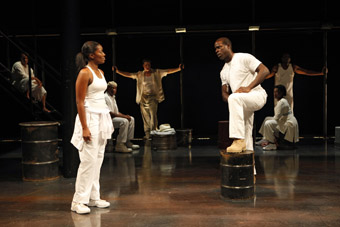
Kianne Muschett, Sterling K. Brown and the company, In the Red and Brown Water, part of The Brother/Sister Plays
photo Joan Marcus
Kianne Muschett, Sterling K. Brown and the company, In the Red and Brown Water, part of The Brother/Sister Plays
tarell alvin mccraney, the brother/sister plays
By far the best thing I saw in New York City was Tarell Alvin McCraney’s tri-generational epic, The Brother/Sister Plays, which any festival director worth their salt should secure for their next program. Directed by Tina Landau and Robert O’Hara and starring a versatile, highly committed cast, the three plays that make up McCraney’s trilogy—In the Red and Brown Water, The Brothers Size, and Marcus; or the Secret of Sweet—were at once both modest and expansive in scope, quotidian in their concerns and monumental in their realisation. Living on the Louisiana bayou, the characters have simple, even ordinary hopes and dreams—to have a baby, to help a brother, to learn about one’s past, to come of age—but in McCraney’s rendering take on the force and power of myth and the tone and timbre of memory or dream. Characters are named after Yoruban nature gods; they have prophetic dreams and visions.
The third play, Marcus, takes place as a hurricane bears down on the bayou, the narrative function of which is neglible, the symbolic function, like the storm at the end of the Coen Brothers’ A Serious Man, considerable. The characters also have a strange way of speaking: in addition to their dialogue (a rich, musical vernacular) they also speak their action lines: “Ogun Size sighs,” reminding the viewer of the pre-emptive voiceover in Robert Bresson’s A Man Escaped. This potentially alienating, even anti-dramatic, device took far less getting used to than one might have suspected and was used to bring the act of storytelling, which plays a central role in these plays, to the fore. The Brother/Sister Plays gave form to the manner in which we turn our lives into narratives, mythologising and making sense of them even as we are living them. It was a dramatisation, in other words, of the manifold ways we use concepts such as God’s will and fate, destiny and myth, the butterfly effect and teleology, to structure our lives as meaningful narratives. As Joan Didion once put it, we tell ourselves stories in order to live. McCraney, who I suspect we will be hearing more from in future, goes a little further: for him, we not only tell ourselves stories in order to live, we turn ourselves into stories as well.
Heaven, choreography Morgan Thorson, Performance Space 122, Oct 25–30; Temporary Distortion, Americana Kamikaze, writer, director Kenneth Collins, Performance Space 122, Oct 24-Nov14; Damaged Goods, Auf den tisch! (At the table!), curator Meg Stuart, Baryshnikov Arts Center, Nov 6-7; Odéon-Théâtre de l’Europe, Quartett, writer Heiner Müller, conception, direction Robert Wilson, BAM Harvey Theater, Nov 4-14; Public Theater in association with Ontological-Hysteric Theater, Idiot Savant, writer, director Richard Foreman, Public Theater, Nov 4-Dec 20; Public Theater in association with McCarter Theatre, The Brother/Sister Plays, writer Tarell Alvin McCraney, Part 1: In the Red and Brown Water, director Tina Landau, Part 2: The Brothers Size, and Marcus; or the Secret of Sweet, director Robert O’Hara, Public Theater, New York, Nov 17-Dec 20, 2009
RealTime issue #95 Feb-March 2010 pg. 36-37
© Matthew Clayfield; for permission to reproduce apply to realtime@realtimearts.net
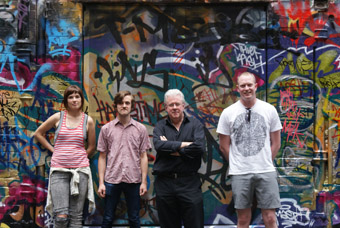
Sonya Parton, Keith McDougall, Mike Mullins, Gerard Hindle
photo Richard Bruch
Sonya Parton, Keith McDougall, Mike Mullins, Gerard Hindle
MIKE MULLINS AND I ARE STARING INTO THE PAST, AT OLD PHOTOGRAPHS ON A COMPUTER SCREEN. POINTING KEENLY, MULLINS SAYS, “THAT WAS TAKEN ON MAY DAY WITH GROTOWSKI IN POLAND. MAY 1, 1975. ONE OF THE YOUNG PEOPLE I’VE BEEN WORKING WITH HAS BEEN RESTORING ALL THIS. THERE’S EIGHT HOURS WORK GONE INTO THAT IMAGE. IT WAS SCRATCHED, IT HAD MOULD ON IT THAT HAD GONE HARD.”
I’m appreciative, “It looks so fresh. You could be just down the street.” We’re looking at Mike Mullins’ life in art in the 1970s and 80s: working in the outer limits of theatre, enacting solo performance art, establishing The Performance Space in Sydney and zealously promoting “new form” (which we now know as contemporary or hybrid performance or live art) to the Australia Council.
Mullins will launch this history at Performance Space as a performative lecture on February 16. He takes me through a chapter, a series of images which will be accompanied by recorded voice-overs quoting from letters and articles interpolated with his own live, onstage commentary. “‘Early Experiments’ is about the first original work I did in 1976, in Fitzroy in Melbourne when I came back from Poland. In the lecture I’ll recount how Grotowski referred me to Joseph Conrad’s The Shadow Line and said, ‘That’s you Mike.’ So I took that as a context for the work and developed a piece partly based on Woyzeck but also referencing Conrad’s book, which is about rites of passage. The work was very physically oriented but I started playing with symbols and metaphors. [He points to the image.] This was the performance area—imagine the OH&S on that these days! Here’s the young Margaret Cameron—she must have been 23—and those are slides on two screens.
“I’ll be talking about how the slides gave another dimension to the performance and indeed, one theatre critic wrote quite a good review and Reg Scott in Nation Review actually talks about how this use of photographic images in performance is something unknown at that time. We came to Sydney and performed at The Village Church where the Paddington Markets are now. But then I decided I was doing exactly what Grotowski advised me not to do. The last words he said to me were, ‘Find out what it is that you do. Don’t do Grotowski-style theatre.’ That’s what I was doing. It was a poor theatre, focused on the actor, very physical, quite violent in a way. It made me want to find out what it was that I did. People were doing theatre—with a capital T—based on scripts and there weren’t many of us actually out there exploring new forms of performance.”
out of the box
I ask Mullins what motivated him to write and perform his history. He explains that he recently embarked on a Master of Arts degree and “decided to open about 30 boxes that I’d been carrying around for about 30 years. I’m an obsessive sort of person and an obsessive documenter of my work and of the times. So I’d fill a box, seal it and those boxes weren’t opened until last year. What I discovered when I opened them was that I actually had an historically significant collection of letters, documents, people’s papers, newspaper articles and Australia Council publications, from 1973 to 1986. So I had this little window of time that told the story of the battles that were fought for new form practice. There’s one chapter, ‘The New Form Dialogue’, which is just letters between the Australia Council and me fighting, me accusing them of maintaining a colonial culture, of buying a culture rather than investing in a culture, and attacking the mainstream companies for what I considered to be colonial theatre, carbon-copy theatre. There’s a whole chapter on the production of Nicholas Nickleby as evidence of this with letters between Richard Wherrett and myself and Jim Waites because we’d attacked it for reproducing the achievements of English artists.
“Now, we’ve come a long way—and I’ve been practising this line for some time—when you look at Cate Blanchett sitting passively onstage taking a golden Shakespearean shower, you’d have to say we’ve come a long way since Nicholas Nickleby! And I passionately disagree with [the new artistic director of Opera Australia] Lyndon Teraccini when he says we haven’t come very far since The Summer of the Seventeenth Doll. Well, I’m sorry, but that kind of denies everything that’s ever happened at Performance Space for a start.”
Mullins’ history also includes a chapter on the “ceiling funding strategy” debate of 1985, which he thought extraordinary, not least because it was a serious national debate, but because it lacked the language with which to discuss the issues. The attempt by the Australia Council for the Arts to cap the funding of state theatre companies was met with voluble protest from those organisations as they demanded “certainty”—something the major performing arts organisations have had ever since (if under review next year). Mullins argues that the ‘ceiling funding’ debate really started much earlier, if implcitly, with the collapse of The Old Tote in Sydney and the establishment of the performing arts complexes. “Suddenly the game changed. The state governments created these cultural palaces—Adelaide Festival Centre, 1973, Sydney Opera House, 1973, The Arts Centre in Melbourne, 1984, QPAC, 1985. So not only did a whole lot of arts money go into these complexes but suddenly the budgets of the state companies had to expand. So all this money was being absorbed. And to be fair on the Australia Council and the Theatre Board, the decision they took with the concept of a ceiling funding was the only way they could respond to all the work emerging outside of the mainstream that warranted support. All hell broke loose. I’ve got a wonderful letter from CAPPA [Confederation of Australian Professional Performing Arts] sent to me at The Performance Space saying, ‘Of course we support you but not at the cost of funding to the major companies.’ And my response was, ‘Well what am I supposed to do—wait two decades?’”
thesis as performance
Initially Mullins opened his archive boxes when searching for historical references for the thesis he was writing for a Master of Fine Arts at CoFA. Eventually the research project evolved into a performative lecture, a work of art in itself rather than a conventional thesis or the exhibition that had been considered at one stage. Some of the material had aged badly: “One of my team, Sonya Parton, has just been doing the archive restoration—documents on fading fax paper—and putting it on slides. In one of the boxes I found the fifth carbon copy of the contract between Grotowski and the Arts Council of NSW signed by Grotowski. Gerard Hindle is doing the engineering for the multimedia presentation and the art direction and Keith McDougall is doing the sound design. Plus I’m working with a couple of graduates from the VCA who are doing the voice-overs. So the whole thing is like Media Watch meets Al Gore’s Inconvenient Truth. It’s an investigation, an exposé of a period about fighting for new form, about fighting for the right to pursue new ideas. What really underlies all of this is the question: why is it so fucking hard to pursue new ideas in this country? And it’s not just in the arts. It’s science, industry…What I will show, along with the clinical evidence, is how hard it was for me 1973-86 to pursue new ideas in this country. I ask the question, has much changed?”
Mullins’ archaeological dig into his archive was at moments intensely personal: “There were dead people in those boxes.” But also some revelations. When in 1986 he was asked to do some research for Andrea Hull at the Australia Council about the plight of the individual artist he agreed: “as long as I could in the first instance talk about my own struggles. So I had access to all my files and I discovered that when I was arrested for performing The Lone Anzac on Australia Day 1981, unbeknownst to me all hell broke loose. I found an incredible file of letters from the RSL, from the British-Australia Friendship Society, letters to Malcolm Fraser…It was much bigger than I knew and the Australia Council was under severe attack. It was even raised in the Senate. It was like the Bill Henson case. There’s a wonderful letter from Richard Perram [then a Project Officer at the Australia Council] to Mrs X from Kew in Victoria who thought the whole thing disgusting. He’s writing back to her quoting Gertrude Stein. I ask what’s happened with arts bureaucrats these days? All you get is a pro forma letter.”
For his historical performative lecture, Mullins has drawn on only 20% of the boxed material: “There’s 80% that’s got to be restored. There was a reel of 16mm film that I’d never seen but was shot on the day that The Lone Anzac was arrested. I’ve had that digitised. It was shot on Eastman Colour and colour’s faded, but it’s in there.”
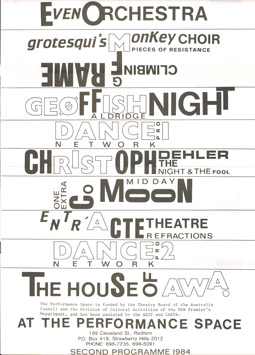
The Performance Space program, 1984
courtesy the Mike Mullins Archive
The Performance Space program, 1984
the performance space years
After establishing The Performance Space in 1980, Mullins says that “the sad story is that my own work largely died because I took on the politics. In 1986 I walked away from the whole thing, exhausted. It took five years of my life and a dole cheque to start up The Performance Space. And many people contributed to that process. I came to an arrangement with the Greek family who owned the building that I’d live there rent free and that I would set it up as a corporate funded body. I have all the letters of rejection from funding bodies. There’s a wonderful one: I have endorsement from one of the seminal figures of 20th-century theatre and I go to the Theatre Board and say I’ve got this introduction from Jerzy Grotowski and I’d like to go to New York and Europe because it will open doors for me. ‘This has no relevance to our agenda,’ says the Australia Council letter.”
I wonder how Mullins kept The Performance Space going until it got funding. “Oh, it was hard. As I explain in the lecture, The Performance Space came about, like most major decisions in your life, from not just one thing. I was working in the Pilgrim Church’s Pilgrim Theatre [over the road from the RealTime office in Pitt Street, Sydney] and because in Shadow Line 2 I had a huge cross that during Act 2 slowly fell, the church kicked me out. Fair enough, I suppose. So I was looking for space but every time you opened a new space it was time and money and energy. Then, after the Luna Park fire in 1979 the Public Halls Act became quite draconian. You couldn’t have a public performance in any church hall anywhere unless it had fire equipment. So the next place had to be the place.
A former trades union hall in Cleveland Street, Redfern, was licenced for public entertainment and “had all the exit signs and fire hoses and all that sort of stuff.” The third reason for establishing a home, Mullins says emphatically, “was that we artists were all working in isolation. I worked out that to do the work, you had to change the thinking of the funding bodies, by having innovative work all happening in one place. But that was the beginning of the end for me as a practitioner because all the energy was going into fighting the battles for change. Hence the title of my presentation, ‘The politics of change.’”
I asked Mullins who were the artists he was supporting and nurturing at The Performance Space. In his boxes he kept all the fliers, listing Dance Exchange, Grotesqui’s Monkey Choir, Even Orchestra, Nanette Hassell’s dance company, Carol Woodward’s Fools Gallery, Entr’Acte, One Extra and many others. “There were the ACT 1 and ACT 2 festivals which is where I did my Agent Orange piece. But The Performance Space also represented a pooling of resources in terms of audiences. It gave them a focus on this work. It gave the funding bodies a focus on this work. My God, it was in a fucking building. They could understand it now! An address. Oh, so that’s new form? 199 Cleveland Street, Redfern. Right! Got it! [LAUGHS].”
Mullins created a range of performances from 1980 to 1986: “Nuke Love (1980); Long Long Time Ago (1983); The Invasion of No-one (Orange Festival, 1985); Illusion (1986); and The Human Exhibit (1984), when I spent three weeks in a cage at Taronga Park Zoo.” His last performance work was Illusion, created with Peter Carey and others (with songs by Carey and Martin Arminger) at the 1986 Adelaide Festival, “for which,” he says, “I got a flogging. That’s a whole other story but an important part of the history. The concept for Illusion was conceived at the Pilgrim Theatre. It was the third part of a trilogy of works I wanted to do: the first two were Shadow Line 2, which was realised, and New Blood which unofficially opened The Performance Space in 1980 when I moved in there. The next work was going to be Illusion but it took me six years to get adequate funding to do it. It was a compromised work in many ways by the end. However, the ABC filmed it and I’m not ashamed of it. I’ve included a section from it in my presentation. It was about Australians pretending to be Americans and getting burned in the process. That’s not a bad statement and how relevant was that during the Howard era?”
investment & a national cultural policy
Reflecting on the rationale for arts funding, Mullins believes a long-term notion of investment in the arts is a good one, “because there’s no quick return. We’re a very young country, a post-colonial settlement, still forming who we are. So investment is very important. I’m a great believer in having a cultural policy because of that. I think we’re very vulnerable to outside influences and we need to protect our identity. That’s got to be the basis of why we have a cultural policy. Who are we? We’re actually quite strange: we’re a massive piece of land with relatively few people on it; we’re isolated by great oceans; we’re in the middle of Asia; we have some of the oldest cultures on the planet, and this idea of multiculturalism—what does that all mean?”
Mullins then looks back longingly to a period of substantial investment: “My chapter on 1973 is full of fantastic things. Whitlam doubles the funding for the arts that year; the first Biennale happens; Blue Poles is purchased; Sydney Opera House opens; Patrick White wins the Nobel Prize; a merchant bank is formed in Sydney called Nugan Hand; Rupert Murdoch registers News Limited in America; the Australian Film Television & Radio School (AFTRS) is established and Al Grasby announces ‘a multicultural society for the future.’ You know, in 1973 women were permitted to sit for the Public Service entrance examination in Victoria for the first time. It’s inconceivable isn’t it? Gilbert and George perform at the Art Gallery of NSW for the first time. And what was I doing that year? I was a trainee director at The Old Tote working on the three opening shows at the Sydney Opera House, pretty well learning everything I didn’t want to do in theatre.”
performing with a purpose
What will Mullins do with his performative lecture after its Performance Space launch? “I’d like to tour it around the country this year. I want it to start a dialogue. All this contemporary practice nowadays has a history. Australia is very good at denying its past. Spaces like Performance Space and Arts House in Melbourne didn’t come out of nowhere. My intention was always to promote the need for a cultural policy. We got real close to it with Creative Nation and I know Andrea Hull was looking at it back in the mid-80s at the Australia Council. I talk about 2110 when there’s been a cultural policy in Australia for 100 years and some kid from a rock near Wagga Wagga comes up with this grant application and it’s for a lot of money because he wants to do the work from the outstation on Mars. It’s a work referencing the red soil of Mars with the red soil of Australia. All doors open, he gets the grant.”
But Mullins isn’t only thinking of emerging artists: “I used to jokingly say about The Performance Space, we’re creating a home for the middle-aged avant-garde. And I was quite serious. Experimental or avant-garde theatre was something you did when you were young. It was never conceived to be a life’s work. And of course it is a life’s work. It’s not something you get over when you grow up. And I see great evidence of that in the work of an artist like Margaret Cameron.”
Mullins would love to trigger change, change that builds acceptance of change, of new ideas, into our culture. He’d love it to be a certainty: “My son has recently graduated as a mathematician and we’re trying to work out a formula, a mathematical equation that explains why art is a critical part of culture. We haven’t cracked it yet.”
The Politics of Change, Mike Mullins and collaborators Gerard Hindle, Keith McDougall, Mike Mullins, Sonya Parton, Performance Space, CarriageWorks, Sydney, February 16, 6.30pm
RealTime issue #95 Feb-March 2010 pg. 38-39
© Keith Gallasch; for permission to reproduce apply to realtime@realtimearts.net
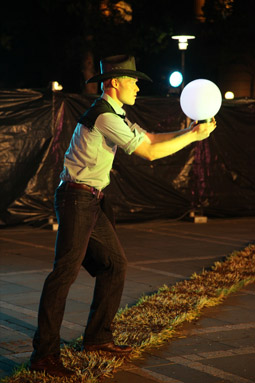
Steffen Hesping, The Hour We Knew Nothing of Each Other, Tantrum Theatre
photo Lauren O’Brien
Steffen Hesping, The Hour We Knew Nothing of Each Other, Tantrum Theatre
THE SCRIPT FOR PETER HANDKE’S WORDLESS PLAY THE HOUR WE KNEW NOTHING OF EACH OTHER INDICATES: “THE STAGE IS AN OPEN SQUARE IN BRIGHT LIGHT.” IN HER REVIEW OF THE NATIONAL THEATRE 2008 PRODUCTION IN LONDON, GUARDIAN BLOGGER LYN GARDNER COMMENTED THAT “RATHER THAN BEING PUT ON AT THE NATIONAL, MAYBE [IT] SHOULD BE STAGED OUTDOORS.” IT SEEMS OBVIOUS ENOUGH, ESPECIALLY IN THE AGE OF THE FLASHMOB, BUT APPARENTLY NO ONE HAS DONE SO. THAT IS, UNTIL NOW, ON THIS NOVEMBER NIGHT IN NEWCASTLE, WHERE TANTRUM THEATRE IS PERFORMING AT WHEELER PLACE IN THE CITY’S CIVIC PRECINCT.
Within Wheeler Place, which is too large and windswept for a performance, designer Kat Chan has fenced off a smaller rectangle. On one side there is a concrete barricade and a building shaped like a beehive. Perpendicular to this, a set of wide and shallow concrete steps leads up to the cavernous entrance of a brick warehouse. The third and fourth sides are seating banks for the audience. Surrounding us are the sights and sounds of Saturday night in Newcastle: we can catch glimpses of King Street and Civic Park and we can hear cars throbbing up and down Hunter Street. High above are the palm trees and the Newcastle City Hall clock tower, which strikes eight and signals the beginning of this absorbing performance.
Suddenly a man sprints diagonally across the space. Two girls run in the other direction. Then another man comes down the steps, gulping up the night air. Children skip across the stage and an old lady drags her shopping cart on another adventure. Two firemen hurtle through and some latecomers arrive, though they could easily be part of the performance, a worker almost knocks over a woman with his ladder and a skater breezes by. There is a man lugging rugs, a stockman cracking his whip and an office worker on a coffee run. Groups of schoolchildren wander by, always with a straggler at the back. Every once in a while the action is interrupted by the town fool who likes to mimic, follow and harass, or the street cleaner, who is constantly sweeping.
In amongst all of this activity, there are some lovely lulls when even the wind contrives to participate, swirling dust and debris across the stage. There is also a brief interlude when the performance is suspended for rain. Nevertheless the play soon regains its momentum as a glamorous woman (a minor celebrity perhaps) walks with a false self-consciousness across the square, acutely aware of every stare. The clock strikes nine, Moses comes down from the mount (or at least the warehouse) and a body bag is picked up and stretchered off. Sometimes it is as if European theatre history is playing itself out over two hours instead of several thousand years: there are gods, clowns, detectives, characters from the opera and the Bible, a lost circus and at one point the whole company might well be a Greek chorus. Other times, it is as if humanity itself is washing across the stage: characters’ paths cross, miss and run parallel to each other and there are arguments, reunions, pregnancies and deaths.
This is a well-paced and detailed production of Handke’s evocative scripted stage directions. (Gitta Honneger’s translation includes lines such as “The empty square in bright light, like a tiny island surrounded by an episodic torrent of oceanic sounds. The whistle of a marmot, the scream of an eagle. For an eerily brief moment, the shrilling of a cicada” [New Haven: Yale UP, 1996]). Director Brendan O’Connell has harnessed the energy of 54 performers, aged between five and 26, who play 450 characters between them. It is exhilarating to see so many bodies on stage and for the most part they are disciplined and generous, rarely loitering too long and almost always ready to share the space. Sound designer Roxzan Bowes allows Christopher Harley’s original compositions to coexist sympathetically with the city’s own soundscape and at various points we hear strains of a song from the pub next door (“Oh Mickey you’re so fine, you’re so fine you blow my mind. Hey Mickey! Hey Mickey!”). Similarly, John Zeder’s lighting design does not try to compete with the existing street lighting but rather to amplify it. The overall effect is of theatre deconstructed while simultaneously a sort of meta-theatre is reconstructed. Like the spectators of Handke’s most famous play, Offending the Audience, we are constantly reminded that this is a performance. Yet, like the angels in Wings of Desire—Handke’s film collaboration with Wim Wenders—we are granted an overview of life not normally available to us and certainly not available to those we are watching. We sit, taking it all in and stitching together our own version of the town square. In the final moments of the play, everyone runs across the stage before coming to a standstill and looking out at the audience. We’ve not known each other for nearly two hours now.
On the night I attend there are also a couple of speeches, marking the end of the year for the Tantrum Theatre team. While it has been operating since 1976 as 2 Til 5 Youth Theatre, the company was reborn and rebranded in 2003, gaining additional momentum in April 2008 when it appointed O’Connell—a former recipient of an Australia Council Flying Start grant—as Artistic Director. Like Powerhouse Youth Theatre or PACT in Sydney, or Platform Youth Theatre in Melbourne, the company aims not only to develop young artists’ skills but also to enable local emerging artists to create their own work in collaboration with professionals. Though Tantrum Theatre is not yet as famous as other Novocastrian organisations such as Octapod or events such as This Is Not Art, or even strategies such as LiveSites and Renew Newcastle, the company is becoming an increasingly important part of the city’s evolving arts ecology. In the process they are building a reputation for ambitious, innovative and inclusive performance. If you have the chance, I recommend getting to know them better.
Tantrum Theatre, The Hour We Knew Nothing of Each Other, writer Peter Handke, translator Gitta Honegger, director Brendan O’Connell, performers Tantrum Theatre junior and senior ensembles, designer Kat Chan, lighting designer John Zeder, composer Christopher Harley, sound designer Roxzan Bowes, Wheeler Place, Civic Precinct Newcastle, Nov 26-28, 2009. www.tantrumtheatre.org
RealTime issue #95 Feb-March 2010 pg. 40
© Caroline Wake; for permission to reproduce apply to realtime@realtimearts.net
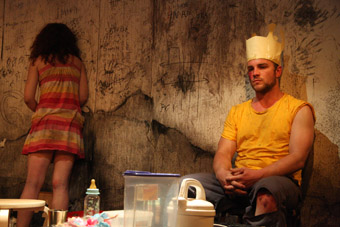
Sophie Mathisen, Andrew Dunn, Life is a Dream
photo Daisy Noyes
Sophie Mathisen, Andrew Dunn, Life is a Dream
IT’S TEMPTING TO STATE THAT 2009’S CLOSE WILL BE REMEMBERED FOR THE PROVOCATIVE, NATION-SPANNING DEBATES SURROUNDING GENDER DISPARITY IN THEATRE WHICH CROSSED MAINSTREAM PRESS, THE BLOGOSPHERE, SMALL PRESS AND FOYER CONVERSATION. THIS MIGHT BE WRONG FOR TWO REASONS: FIRSTLY, THESE DEBATES ARE FAR FROM OVER, AND TO CONSIGN THEM TO HISTORY WOULD BE GROSSLY NEGLIGENT. BUT SECONDLY, SADLY, THERE’S AN EQUAL CHANCE THAT THESE DEBATES WILL SOON BE HARDLY REMEMBERED AT ALL.
That said, I’m not going to try to address the entirety of this complex debate here. I do want to tackle one tiny corner of the canvas, however: the notion of the (male) wunderkind. It was a topic raised by a number of voices last year—the sense that those who push our theatre in the most exciting new ways are almost invariably youthful white males. Of course this is a fallacy. But the wunderkind phenomenon is no less real for being a myth, and an enduring one at that. The Koskys, Kantors and Andrews were never the only artists working at the vanguard, but they have reached a national status that affirms this mythmaking exercise and a younger crop are being hailed as their successors.
Four very different productions which appeared in late 2009 provide ways of thinking through this dynamic. Simon Stone is one of the touted heirs to the wunderkind title, but his B.C. saw the crown resting uneasily; Daniel Schlusser’s Life is a Dream made one wonder why he has never been positioned in the same category; James Saunders’ Harry Harlow emphasised collaboration rather than individual artistry; and Bagryana Popov’s Progress and Melancholy was a reminder that innovation has nothing to do with gender.
Schlusser and Popov have both been developing distinct aesthetics for some time now, but haven’t received the same kind of attention afforded someone like Stone. Life is a Dream was a rich, difficult production, infuriating to some and unforgettable to most. The complexity of its aesthetic sensibility made it, for me, one of the most rewarding experiences of the year. Schlusser stripped back Pedro Calderón de la Barca’s 15th-century play to a raw core of power relationships and plot mechanics, then had a cast of bedraggled wastrels act out this excoriated drama as an infernal punishment. The conditions within which these performers found themselves have been compared to Big Brother (both Orwell’s nightmare and the reality TV show) but the situation seemed to me more thickly existential rather than simply allusive. The actors forced one another into cruel games of torture, humiliation and betrayal; that the play they eventually began to perform was just another monstrous game is vital. De la Barca’s drama is very much concerned with freedom and predestination; Schlusser’s direction gives this greater resonance by creating a performance space that highlights the absurd limitations ‘theatre’ imposes on its participants.
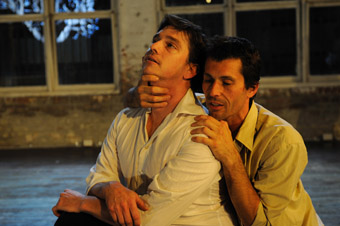
Todd MacDonald, Christophe Le Tellier, Progress & Melancholy
photo Paul Dunn
Todd MacDonald, Christophe Le Tellier, Progress & Melancholy
Popov’s Progress and Melancholy was a more playful attack on similar ideas—inspired by Chekhov’s The Cherry Orchard, it took a freewheeling, libertarian approach to adaptation. Standup comedy, dance and live music appeared unexpectedly; various narrative threads were given heightened prominence while others were almost done away with entirely. Popov herself gave audible direction from one side of the audience bank, and this sense of liveness underscored much of the production, where individual performances frequently took on aspects of improvisation and emotional immediacy.
The effect was quite other to that produced by Life is a Dream. Schlusser’s production created violent chaos within a tightly defined space of rules; Popov’s seemed more interested in challenging rules and the result was a strangely orderly experience. Its unruliness seemed merely sporting, making for an undeniably enjoyable work that never quite went beyond its own ephemerality.
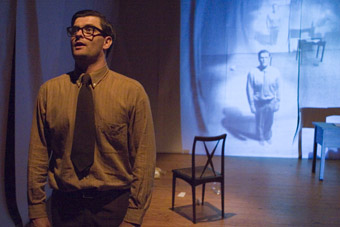
James Saunders, The Harry Harlow Project
photo John Sones
James Saunders, The Harry Harlow Project
James Saunders’ The Harry Harlow Project was another fascinating experiment which quite literally focused on the laboratory as a metaphor for freedom and control. Taking as its subject the notorious behavioural scientist whose pioneering experiments on primates deeply influenced 20th-century psychology on infant-rearing, attachment and mental illness, it shied away from biography in favour of a more impressionistic portrait of a troubling figure. Trapped within a cold, clinical room and beset by physical tics and psychological compulsions, the confines of the stage here came to represent the solipsistic inwardness of the character unable to escape the limits of his own existence.
But while Harlow’s lot is to be eternally caged with his own demons, Saunders has ensured that the production itself is not the result of a single vision—rather, much of the work’s shape is defined by his collaborators. Martyn Coutts and Kelly Ryall provided live video and aural components to Saunders’ solo performance, where projected monkey footage and fascinating sequences wherein Harlow engages with ghostly doubles of himself or his shadow offered some of the most striking moments. Brian Lipson’s direction, on the other hand, felt less disciplined and at times introduced a less integrated, more self-conscious tone to the work.
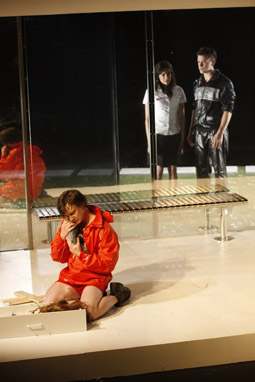
Dylan Young, Nicole Da Silva, Ashley
Zukkerman, B.C., The Hayloft Project
photo Jeff Busby
Dylan Young, Nicole Da Silva, Ashley
Zukkerman, B.C., The Hayloft Project
Simon Stone has been taking The Hayloft Project in encouraging new directions in the past 12 months. Initially a company indelibly stamped with his own creative mark, 3xSisters saw the director teaming up with two others to take on another Chekhov classic, while the wonderful Yuri Wells was essentially developed Stone-free (RT94, p8). This expansion of Hayloft’s boundaries has substantially enhanced the range of work we can expect from the company.
B.C. saw Stone back at the directorial helm, but here he took on an original script rather than setting his sights on reinventing an established work. Rita Kalnejais’ writing is perhaps the least confident ingredient in the mix, though an outstanding cast mostly made up for some structural failings in the narrative.
The work performs a contemporary retelling of the Christian story of Mary and Joseph: the pair are disaffected teens in a suburban Australia, the archangel Gabriel is Mary’s intellectually disabled brother. These religious notes are only one of B.C.s layers, however, and far more compelling are the less forced details of quotidian wonder that permeate the mythic overtones. Joseph’s gradual shift from clichéd tracksuit-wearing thug to self-questioning lover is deftly handled, while Mary’s parents are provided thick and engaging narrative arcs of their own.
What can these varied productions tell us about that old wunderkind thing, then? For one, they suggest that the kinds of dense, textured theatre that shifts away from textual primacy maintains a meta-theatrical self-awareness and incorporates extra-theatrical modes of performance are being created by all sorts of people all over the place. Trying to find applicable terms for this kind of theatre (the post-dramatic, the spectacular, the postmodern, the cross-platform) seems a bit unnecessary, since these diverse works aren’t simply a trend or movement. They’re an indication of where performance is at right now in this country.
Secondly, they hint at the way the great authorial director is always less responsible for a production’s successes (and failings) than the myth would lead us to believe. The finest directors in Australia are the ones with the best collaborators. However dictatorial and demanding a director’s public face may be, they’re still at the mercy of designers, writers, performers and countless others who will shape the thing that wears their name.
So why are particular men elevated to a particular status as directors? This isn’t to fault people such as Stone, or Benedict Andrews or Simon Strong or Matthew Lutton, who are all very talented and knowledgeable theatremakers. But they’re not alone, and they’re not Olympian in their abilities. Perhaps it’s just that among the many, many first-rate artists in the country, we need a few names to stick out as ones to watch; a combination of media laziness and audience acceptance. Is that really good enough?
Life is a Dream, director Daniel Schlusser, performers George Banders, Brendan Barnett, Johnny Carr, Andrew Dunn, Julia Grace, Sophie Mathisen, Vanessa Moltzen, Sarah Ogden, Josh Price, design Marg Horwell, lighting Kimberly Kwa, composer Darrin Verhagen, The Store Room, Nov 20-29; Progress and Melancholy, director Bagryana Popov, performers Todd Macdonald, Natasha Herbert, Majid Shokor, Christophe Le Tellier, Paea Leach, Sara Black, design Adrienne Chisolm, lighting Richard Vabre, composer Elissa Goodrich, Fortyfivedownstairs, Nov 19-29; The Harry Harlow Project, writer, performer James Saunders, director Brian Lipson, composer Kelly Ryall, video artist Martyn Coutts, dramaturg Kate Sulan; Full Tilt, Fairfax Studio, Arts Centre, Nov 26-Dec 5; The Hayloft Project, B.C., writer Rita Kalnejais, director Simon Stone, performers Tyler Coppin, Nicole Da Silva, Margaret Mills, Yesse Spence, Dylan Young, Ashley Zukerman, design Claude Marcos, lighting Kimberly Kwa, sound design Stefan Gregory; Full Tilt, Black Box, Arts Centre, Melbourne, Nov 30 – Dec 9, 2009
RealTime issue #95 Feb-March 2010 pg. 41
© John Bailey; for permission to reproduce apply to realtime@realtimearts.net
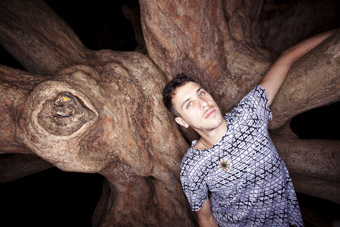
Adam Linder
photo Dan Aboud
Adam Linder
ADAM LINDER EXUDES A DANCER’S RESTLESS ENERGY, MOMENTARILY SUSPENDS SENTENCES AS HE SHAPES THOUGHTS, FILLS THE GAPS WITH EMPHATIC TURNS OF THE HEAD AND EXTENDED GESTURING (AS IF LITERALLY REACHING FOR THE RIGHT WORD), AND THEN RACES ELOQUENTLY ON. LINDER’S PASSION AND DETERMINATION BELONG TO A DANCE-MAKER IN HIS MID-20S IN THE PROCESS OF CREATING A NEW WORK, ABOUT ALTERED STATES OF CONSCIOUSNESS, FOR THE SYDNEY DANCE COMPANY’S FIRST 2010 SEASON, IN A DOUBLE BILL WITH ANOTHER NEW WORK, FROM ARTISTIC DIRECTOR RAFAEL BONACHELA, FOR WHOM LINDER HAS DANCED IN LONDON.
A graduate of the Newtown Performing Arts High School, Linder trained in ballet with Christine Keith and left Sydney at 16 for London where he was admitted with full scholarship to the Royal Ballet School. He subsequently joined the company, performing in classic works as well as modern creations by Kenneth MacMillan, Christopher Wheeldon, Mats Ek, Wayne McGregor and Cathy Marston. But he told The Guardian (Sept 29, 2008) that he had chosen to leave the world of ballet because “it’s not an evolving form of dance.” He explained: “I realised that traditional ballet, and the themes and stories it deals with did not really connect with me as a young dancer and artist. I wanted to delve into contemporary things and be involved in new work and the exploration of new approaches to dance, not be involved in rehashing historical pieces.”
After dancing with Netherlands Dance Theatre II in 2004 and making Over My Dead Body for company dancers in 2005 Linder then worked as an independent in productions by Michael Clark, Rafael Bonachela, Arthur Pita, Meg Stuart and, in Berlin, Jeremy Wade.
Linder says that the spaces between these jobs allowed him the freedom and time to invest in his own dance-making and branch out into photographic and film work. “I’ve managed to divide my time between dancing under other people’s authorship and my own. For the last few years it’s been six months on each if not always consecutively.”
Since 2006 Linder has worked with photographer Will Davidson on the dance-film collaboration Collectnudes.com, including the making of Fuck Forever (2007), which has been broadcast on British, Australian and Spanish television. There have been art films with Pablo Bronstein, since 2007, and in 2008 Lindner presented I Put My Trust In You with British band These New Puritans at the Palais de Tokyo, Paris. “I was getting into film and video before I plunged into making my own performances. It was at a time when I was dancing mostly for other people and it was somewhere I could form an identity. It was self-produced art-making with Will. We just did it, seeing the web as a great outlet. We were both living in London. I’d just moved back from Holland and I was creative assisting him on stills-based projects. I was also dancing and we were making these small films with no money and a lot of ideas and using every resource at hand in covert locations.”
Linder is now engaging with interactive media in a work-in-progress with a fellow Sydney-sider and Berlin resident, media artist Jordana Maisie as part of the 2009 Critical Path-UNSW Dance Research Residency Program. “I’m a dance-maker and she’s a media artist working in interactive installation—we meet in the middle to create a one-on-one participatory installation for the audience, one person at a time. I’m working on how to guide that person, orienting the whole physical experience and guiding them through it. It’s almost like translating all my body practice history onto someone who doesn’t have a practice.
“My work has either been on film or performed in black box and Jordana’s is gallery-based, on a loop, without a beginning or end. But here we were, working in an an undefined pitch black space, creating a linear journey. The audience member becomes the performer and it brought up the question of how you exchange movement history. We’re also working with a lot of text, which neither of us had gotten into before: more new media possibilities.”
Linder’s solo work, Perfect Score, performed to Ravel’s Bolero and described as “the psychodrama of an adolescent search for masculine identity” was commissioned by London’s The Place and performed in Italy and France. Later in 2008 he won the 25,000 pound Place Prize for Dance with Foie Gras a duet (with Lorena Randi) offering a satirical, surreal account of the excesses of consumerist society. His new solo performance, Early ripen early rot, has had preliminary showings in Sydney, London and Berlin and “is about the faith of self-obliteration.”
In 2009 Linder was one of the collaborating performers in Meg Stuart/Damaged Goods’ Do Animals Cry? which was developed in Berlin and is still in repertoire. He’ll work on a new Stuart show later this year. He says that over the last year he’s struck up a close relationship with her: “Meg’s processes are second to none…so wholly inclusive, so thorough, from the six performers to lighting and costume designers and production manager. We worked on Do Animals Cry? for four to five months almost every day, talking, meeting, engaging in experiential experiments. It was such a definitive process for me. Meg works completely with improvisation, with constant dialogue that is theme driven. Twice a week we’d watch a related film. We’d find different physical scores to realise that came up in discussion.”
Linder is inspired by this model of collaboration, of mutual discovery and sharing, where “choreography is not simply a group of performers on stage solely embodying someone else’s vision.” He sees the dance-maker as “setting up a thematic score or situation and improvisations that entail feeling, looking, thinking, possible references. But it’s up to the performers to access their own responses.” He says that many dancers happily work with improvisation and, increasingly, “will be disappointed if they’re not asked to.”
Linder’s new 30-40 minute work for the Sydney Dance Company is titled Are We That We Are. Asked what drives his dance-making, Linder replies, “I will make a work because I’m curious about something and the work needs to be made. By starting the journey I go further into the enquiry, primarily driven by its theme and then engaging in movement research to best explore it. This work will be about altered states.”
Linder explains that he’s been “doing a lot of state [of being] work rather than body practice improvisations with narratives or somatic directions or aesthetic ones, like ‘Only work with a plane lower than a metre high.’ I’m working with rapture, disillusionment, neuroses, inhibition…”
Working with Meg Stuart and Jeremy Wade in Berlin provided some of the impetus for Linder’s new work: “Jeremy’s very interested in the grotesque, the distorted and the transgressive. I was involved in a festival he curated in Berlin called The Politics of Ecstasy titled after Timothy Leary’s book. Meg and Jeremy and a musician, Brendan Dougherty, co-curated a series of improvisations. We were working in a pool of performers, researching ways of dealing with the topic of altered states, and I thought I want to get further into this, to find out my own take on it. I’m personally very interested in altered states, in what is fundamental to the right side of our brain—the sensory, the visionary, the experiential.
“Last night I was having fish and chips at Bondi Beach with my mother. A woman, clearly under the influence of some substance or other, was very slowly moving up the hill from the beach. I could almost sense what she was seeing with her mind’s eye, so disengaged was she from the function of her body in that moment, making swirling, sweeping, spirally walking patterns up the hill.”
Linder admits that he’s taken on a huge subject. He says that creative associate and dramaturg Sally Schonfeldt tells him, “Adam, this topic is too big.” His research embraces “clinical material, scientific research, transpersonal psychology, anthropological forays into shamanism, as well as meditation and Buddhism.” But Linder is emphatic: “I’m not out to make a definitive statement. Contemporary performance is not about putting a cap on things. The work will be an utterance of sorts, proposing an avenue in, one way of looking at things, hopefully inciting the audience to make their own estimations.”
For the new work, Linder’s primary communicative tool is, “of course, my body, for the most in-depth, extreme, experimental, for want of a better word, movement research. But lighting, which will be by Nick Schlieper, is especially important for the work given its role in altering states of being, and sound will also offer an accumulation of entry points into the topic.” In the 1960s psychedelic music was integral to the altered state experience. Linder will draw on the contemporary version (known variously as psychedelic pop or neo-psychedelia) found in the music of Animal Collective, Panda, MGMT, White Rainbow and, reaching back into the 90s, Sunburned Hand of the Man. Linder is curious: “This huge experimental psychedelia movement happening, these new modes, make me wonder what is it about the current political and social climate that is bringing this line of enquiry back from the 60s and 70s but exploding the old notion of it. It’s transcendental, ecstatic and timely for my investigations.”
–
Sydney Dance Company, New Creations, Rafael Bonachela, 6 Breaths; Adam Linder, Are We That We Are; Sydney Theatre, March 23-April 10; www.sydneydancecompany.com
RealTime issue #95 Feb-March 2010 pg. 31
© Keith Gallasch; for permission to reproduce apply to realtime@realtimearts.net
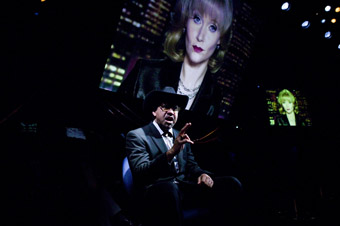
Wayne Blair, Essie Davis, Tot Mom, Sydney Theatre Company
photo copyright Lisa Tomasetti
Wayne Blair, Essie Davis, Tot Mom, Sydney Theatre Company
THE RIGID, PREENED FACE OF US CRIME TV HOST AND EX-PROSECUTOR, NANCY GRACE (ESSIE DAVIS), OGLES US ELECTRONICALLY FROM FIVE SUSPENDED SCREENS. HER EYES PROJECT RIGHTEOUSNESS, HER LIPS AND CHIN CARVE OUT A THICK ‘UPPER INCOME’ GEORGIAN DRAWL WHICH MISTAKES ‘S’ FOR ‘SH’ AND WHICH SWALLOWS VOWELS ECHOICALLY DOWN INTO THE BACK OF HER THROAT AND OUT AGAIN. NANCY GRACE IS A MEDIA MONSTER WHO SEEMS TO WANT “AYVERYONE”—WHETHER GUILTY OR NOT—”TO HAYVE THAYRE DAY IN COURRT.”
Oscar-winning film director Steven Soderbergh (Traffic, Che) had to travel all the way to Australia, and all the way to verbatim theatre, to air his version of the murder of Orange County’s toddler Caylee Anthony and ensuing media trial of her mother in the Sydney Theatre Company production, Tot Mom. The child’s disappearance was reported by her mother Casey Anthony (now indicted for first-degree murder and facing the death penalty if convicted) one month after Caylee had gone missing. Six months later, the child’s bagged and duct-taped body was found in a wooded area “only a stone’s throw”, as Grace repeatedly reminds us, from the Anthony residence.
Grace is best known in the US for Nancy Grace, the ratings-topping HLN program featuring breaking crimes news with lashings of innuendo from a variety of favourite experts. Night after night, Grace remounts the sordid debris of Florida’s rapes, murders and disappearances—skulls falling from plastic bags, the forensics of hair and skin, tears or dry eyes in a suspect—in her tightly conservative, scandal-bound media script. Her tactics are savage, banal and flush with the rhetoric of victim advocacy at the expense of due diligence and civil liberty. It seems she’d get on well with Sarah Palin, although it’s a marvel there’s space for two of their ilk in the world.
We are told that all words in the piece derive from transcripts—not the preciously undisclosed transcripts of witness testimony, but of nightly US TV verbiage, mixed with documents from the public record. What insight can live verbatim theatre bring to such a highly mediated event? Why theatre? Why verbatim? Why here?
Documentary theatre has been traditionally used to advantage minority voices and rights (Urban Theatre Projects’ Fast Cars and Tractor Engines [RT70), Alana Valentine’s Parramatta Girls). We’ve also seen the reversal of this convention in works like version 1.0’s CMI: A Certain Maritime Incident (RT61) and David Hare’s Stuff Happens, which take words out of the mouths of those in power to re-quote the quotation and let the rhetoric be heard. In Aalst, Duncan McClean shifted tactics again, deploying the chilling testimonies of two parents charged with infanticide to tempt our moral incredulity over the social psychology of good and evil (RT83).
Soderbergh’s strategy departs from these by remediating the already mediated: he re-screens words that have already, so to speak, gone to air. He saves these words from disappearance and brings them to account. They are made distinctly temporal, and although we never see Grace in the flesh, they are also made distinctly corporeal—they flash between the TV program’s interviewees (who are physically present, seated in a row beneath the screens and never seen on them) and Grace’s indomitable screen presence.
The text runs at hammer pace. Grace calls a bounty hunter, a psychoanalyst, a police detective and a defence attorney, amongst others, to her program—all excruciatingly facile in their observations. The structure of the work follows Grace’s shifts between these experts, eye witness news reportage and call-in viewers, to mount a crescendo of conjecture around the crime itself. At times the rhythm in Grace’s speech overtakes her meaning—she is given a parodic edge that makes her both larger than life and extraordinarily real. The staging is simple—a bog upfront reminds us of the missing child—and lighting is expertly timed to puncture Grace’s false solemnity with a perfunctory cut, black-out and edit to the next scene.
The performances are powerfully economical. Essie Davis creates Grace solely through manipulations of voice and face, her chin muscles often taut with purpose, her lips and eyes ready to pounce. The other performances are also compelling, with multiple character portrayals drawn through minimal costume changes. Wayne Blair stands out as the redneck bounty hunter Leonard Padilla and Darren Gilshenan for his depiction of hapless criminal defence attorney Mark Nejame.
The Anthony case became a witch hunt in the US, owing to media overexposure. In Australia, Tot Mum has been interestingly met with a degree of hostility (see http://www.sydneytheatre.com.au/2009/tot-mom/talkback/), with claims that Soderbergh is capitalising on someone else’s grief. (By playing only in Sydney he allegedly avoids compensation fees for the American figures in the play). That Grace is co-author of a bestseller on how “24/7 Media Have Hijacked Our Criminal Justice System” is no little irony. With the trial to begin in June 2010, Soderbergh’s account is an oddly timed intervention that contemplates this very topic. His is a ‘trial’ of the media ‘pre-trial’, but we are still a long way from knowing the legal outcome of Casey Anthony’s fate, and likewise, from hearing her story should it be told.
Tot Mum, director, creator Steven Soderbergh, performers Wayne Blair, Zoe Carides, Essie Davis, Darren Gilshenan, Glenn Hazeldine, Genevieve Hegney, Damon Herriman, Peter Kowitz, Rhys Muldoon, Emma Palmer, set design Peter England, costumes Tess Schofield, lighting Damien Cooper, sound Paul Charlier, Sydney Theatre Company, Wharf Theatre, Dec 23, 2009-Feb 7, 2010
RealTime issue #95 Feb-March 2010 pg. 43
© Bryoni Trezise; for permission to reproduce apply to realtime@realtimearts.net
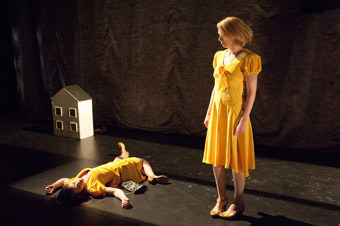
Jo Stone, Astrid Pill, The Pyjama Girl, Ladykillers
photo Shane Reid
Jo Stone, Astrid Pill, The Pyjama Girl, Ladykillers
IN REMEMBRANCE OF THE DEAD—THIS IS ONE OF THE MORE ENDURING FUNCTIONS OF PERFORMANCE: TO CONJURE THE SPIRITS OF THE PAST, TO LURE GHOSTS FROM THEIR GRAVES, TO EXHUME THE LIVES OF THOSE WHO HAVE DISAPPEARED.
Written histories and documentaries do much the same thing, but the rigours of authentication and realism often extinguish the warmth, intimacy and affection that performance can evoke.
The Ladykillers’ new work is an evocation. It calls forth the mystery of a murdered woman—the Pyjama Girl—whose body, dressed in yellow silk pyjamas, was found in a roadside culvert in Albury, New South Wales, in 1934. The woman was not identified until 1944, and then perhaps incorrectly, when a man confessed to the murder of his wife. The body was buried and the man convicted. But the case has been revisited several times since.
Historian Richard Evans’ 2004 book, for instance, casts considerable doubt on the identification and conviction, and raises questions about the conduct of the then New South Wales Commissioner of Police. The Ladykillers’ production does not seek to set the record straight. What it does, initially, is evoke an historical aesthetic that distances the trauma of the case, setting its eroticism and violence in the past.
The Australian 1930s are conjured with design (Gaelle Mellis), music and sound (Zoë Barry, Jed Palmer): a bakelite radio and an old-style microphone, a man’s hat and the women’s shoes, the instrumentation of popular song and the clipped accent of a newsreel announcer. At the outset, performer Stephen Sheehan, seated in a cane armchair, reading the evening news, projects a relaxed image of masculine order. Chaos may be consumed as evening entertainment for, in his work today, he has ensured that public order prevails in the world.
Not so within the fevered inner world of the women in the work. Performers Astrid Pill and Jo Stone, a blonde and a brunette, dressed in yellow frocks and high-heeled yellow shoes, play around a doll’s house and whisper to each other. Later, furtively, at home alone, Pill stuffs biscuits in her mouth and washes down the crumbs with swigs from a hip flask. The women perform the emotions of disquiet. They are often anxious and ill-at-ease. They take turns in dancing with the man—or, rather, listlessly being danced by him.
Vocally, the women are erotically assertive, anachronistically articulate. “Come on, punch me. Hit me. Give me a black eye”: one attempts to arouse the man with erotic fantasies of domestic violence—but fails. Instead, they play dress-ups to jazz percussion, swapping gender roles with shoes and hats. The man croons a song of love forgotten: “My old flame, I can’t even think of her name.” A woman censors her sexuality, infantilising herself by intoning quietly: “I am a bad girl. I am a bad girl.” The man tells a string of misogynistic jokes.
These gendered memories from the past are played skittishly like vignettes. But they also become painful and unpleasant. The violence, at times, feels real. Director Ingrid Voorendt choreographs the action with repetition to estrange the impact of bad affects. In the program notes, she asks, “How do we deal with our fear of bad men?” and “How do good men deal with this?” Voorendt’s direction takes particular care not to disconnect its audience from these gendered questions.
Characters are dislodged as they form. For Pill and Stone, the doubling keeps the identity of the Pyjama Girl unsettled and dispersed throughout the work. With Sheehan, the tendency for suspicion and accusation to alight on him is explicitly rejected. As the work’s tensions are threatening to snap, Sheehan takes a break. Taking off his tie, he turns to the audience and addresses us directly: “I’m not him,” he reassures us. “The whole thing makes me sick.”
The work’s dramaturgy hinges on a transition from fantasy to reality. First up, fantasies about gender, violence, sex and death range freely across the story of the Pyjama Girl, activating a sensual historicity and some playful, role-reversing erotics. What follows then is, literally, reality as revelation. Surface elevation gives way to depth and fantasies hit the dirt. A knife is drawn, a voice floats free, and the body lies inert—but not alone.
If I were a woman with a male partner, I would take him to The Pyjama Girl and I think he would enjoy it. Like a funeral, it is both confronting and consoling. We would come home, make love and talk about it after.
Ladykillers, The Pyjama Girl, director Ingrid Voorendt, devisor, performer Astrid Pill, performers Jo Stone, Stephen Sheehan, devisors, composers, musicians Zoë Barry, Jed Palmer, designer Gaelle Mellis, lighting David Gadsden; presented by Vitalstatistix with Adelaide Festival Centre’s inSpace program, The Space, Adelaide Festival Centre, Dec 9-19
RealTime issue #95 Feb-March 2010 pg. 44
© Jonathan Bollen; for permission to reproduce apply to realtime@realtimearts.net
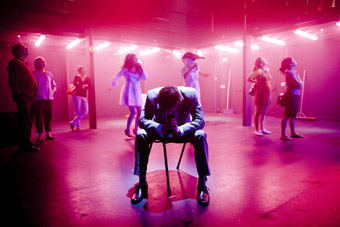
Sydney Theatre Company’s Mysteries: Genesis
photo Brett Boardman
Sydney Theatre Company’s Mysteries: Genesis
THE EARLY BOOKS OF GENESIS IN THE BIBLE ARE ALL ABOUT GESTATION: WITH HIS WORD AND HIS BREATH GOD TRUMPS WOMEN BY ASEXUALLY CREATING A PERFECT WORLD, INCLUDING ADAM AND THE ANIMALS, AND THEN EVE FROM ADAM’S RIB. BUT HIS CREATION IS FAR FROM PERFECT.
Adam and Eve in turn breed curiosity and defiance for which they are banished from Eden as sinners, doomed to parenting and a profound sense of the loss of direct contact with their maker. The Mysteries: Genesis, is written by Lally Latz and Hilary Bell, directed by Matthew Lutton, Andrew Upton and Tom Wright, and performed by the STC’s new young ensemble, The Residents.
The trio of short plays, based successively around the lives of Adam and Eve, Cain and Abel and then Noah adds up to a lateral re-working of the originals, a blend of The Bible, apocrypha and fancy. The staging resonates with associations with the mediaeval English Mystery Cycles. These were seasonal English pageants of Bible stories performed by craft guild members, mostly on carts, and often executed with fearsome spectacle and not a little humour in the vernacular up until their banning in the 16th century by a newly Protestant monarchy. In the black box Wharf 2 we can choose, in the first and the last plays, to watch seated on the floor or the balcony above, while in the second we can stand on the floor, moving about with the performers. The result is an apt sense of both ritual occasion and informality, of being in a public space to witness a re-telling of tales embedded, for many of us, in our psyches but here made new.
The first play, Adam, Eve, commences in total darkness until dim light reveals a mound of flesh which we then see is a body: God seated, bent over, as if in the act of self-creation. But his creation is already imperfect and rules have to be imposed, first on an ambitious Lucifer: “Hell is your gift if you should break my heart.” Ash pours down on Lucifer, rendering him black, erased: “Hell has no windows.” God admits, “I was dazzled by my own creation” but persists, and goes on to “fill the world with [his] ideas” as the stage floods with polystyrene snow in which the childlike Adam and Eve play. Their co-existence with a big penguin (a performer in a daggy costume) with whom they can communicate confirms their innocence, and that they live at one with nature. But we can also understand the couple’s growing curiosity, especially Eve who has not enjoyed Adam’s direct contact with God: “What was it like to look him in the face?” She wonders,”Is this tree the knowledge of our God?”
As Eve, like the child of an absent parent, yearns for God, the rationale for temptation is offered not by Lucifer but by a Lilith figure: “To reach him you must know him.” Eve’s curiosity extends to asking, “What is behind the stars?” But drinking the juice from a plucked glass apple yields a different truth: Eve declares, “I now know what a man is.” Soon she and Adam are feeling the chill, sense their nakedness and are ashamed. God is punishing, condemning Eve and her heirs to the agonies of childbirth and driving Adam to kill the penguin. From the costume Adam forces a woman and tears off her underwear in a palpable ‘rape of nature.’
Writer Lally Katz and director Matthew Lutton don’t subvert the through-line of the Bible story, the outcomes are given, but test its contradictions by siding with Adam and especially with Eve, portraying them as victims of a God who is himself clearly imperfect, a creator who inadvertantly generates a world of escalating contradictions—innocence/sin, black/white, man/woman, love/hate, man/nature—and who cruelly withdraws his affection. Design and performances are realised with like tension between absolutes, sometimes strikingly, too often awkwardly (as in the de-wigging of Adam and Eve in their transformation into sinning humans), and the text is delivered with a drab, actorly archness contrary to the pop staging.
The second play, Cain, Abel, tells the Bible tale but with some intriguing and some alarming variations alongside thematic continuities with the first play. Of the three it has the most affinity with a Mystery Cycle performance. It’s played out amongst the audience. The actors form a band (replete with penguin) that vividly opens the play and later, as a choral group, sombrely closes it with the same song. The script, with its vivid imagery, contemporary references (Cain finds after the murder that “the locks have been changed”) and couplets that evoke the mediaeval cycle texts. While In the first play, Adam and Eve as characters are inevitably difficult to invest with much human complexity, the tale of Cain’s killing of his brother Abel offers more room to move, especially by taking licence with the Bible story and texturing it with God admitting Cain as a mistake, Eve ackowledging her power (“I like God become creator”), and a tired cigarette puffing, dying Adam still longing for one last sight of his maker. The homecoming Cain is murdered by his daughter and wife (who had become prostitutes during his exile) and God is a hovering, bad tempered commentator in a business suit.
Binary dynamics are again central. Abel is played by a woman and his/her murder is perpetrated with precisely the same kind of sexual brutality as the assault on the penguin in Adam, Eve. The realms of Cain (the too demanding care of the earth) and Abel (the rewarding world of blood, plenty, animal husbandry and Eve’s admiration) are quickly mapped out on the floor with tape, dividing and re-dividing characters and audience. Brett Stiller’s performance is the best in The Mysteries: Genesis: his Cain is sulky, envious, dangerous, but, after the murder and exile, he is darkly and intensely remorseful, recalling his misery and abjection, “scouring through the garbage bins like a possum” and wondering, like Job to come, “Why me?” Tahki Saul, as Seth, brother to Cain and Abel, introduces a new dimension, an amiable, potentially restorative figure in a world God sees as almost iredeemably locked in a cycle of corruption. Tautly scripted and rich with curious apocrypha and invention, strong performances and an engaging use of space, the writer Hilary Bell and director Andrew Upton have engendered a disturbingly lateral account of the arrival of Death in the Bible narrative (though made oddly explicit as a female figure in underwear, her hair pulled down over her face).
Bell and Katz co-wrote the final play, Noah’s Ark, with a much more subversive intent than in the first two. Their Noah is a drugged fantastist, a refugee from the world, hiding on top of a pile of eight mattresses on which God addresses him from a radio and joins him for chats. Out of the mattress ooze his three imagined daughters who share Noah’s desire to punish family and neighbours for their sins against God and to sail away in the coming flood. When not sedating him, Noah’s wife berates the man (not in the comic manner of the mediaeval cycles) to nil effect. He is truly delusional, “All history begins and ends with me.” Even God wonders why Noah has no curiosity about his fate, but appears to long for contact with his last believer, almost reaching out to touch him.
Surround sound torrential rain floods the theatre, and the stack of mattresses spins. As the waters subsides God returns to give Noah mastery over all of nature, declares a long list of taboos (including not eating penguins and kangaroos), and makes a covenant that he will never again destroy mankind. It’s time to multiply, as God and Noah enter into a closed circuit of love, mutually delusional. Noah asks, “So what will we do?” God replies, “If you love me, you’ll be with me forever.” We, however, feel less certain. The prospect of salvation from a global environmental disaster through the grace of God worked through a madman seems distant. If dramatically one dimensional given the totality of the protagonist’s condition, the Noah play was nonetheless fascinatingly subversive and visually potent.
For their first mainstage outing, The Residents performed with conviction and ample ensemble spirit if not always investing sufficient detail in their characterisations, admittedly a challenge with this kind of archetypal material. While adding fuel to the ongoing debate between atheists and believers, The Mysteries: Genesis at the same time perpetuates our fascination with a significant component of western cultural history, not least as a theatrical legacy out of which 16th and 17th century English drama partly sprang. There’s also a notable focus from Bell and Katz on women in these Bible stories—Eve’s justifiable curiosity, nature raped by Adam, Abel as representative of the ‘female’ spirit, and Mrs Noah’s hard-earned recognition of her husband’s delusion.
For a very different visual experience, try the recently published R Crumb comic strip of all the Books of Genesis with text from Robert Alter’s lucid new Bible translations. Although not as outrageous as you’d expect from Crumb, there’s much telling detail that undercuts the aetherial abstractions of standard Bible story illustration with strong historical research and vivid characters who palpably sweat, age and have sex. You can’t keep a ‘good’ myth down, it seems.
Sydney Theatre Company, The Residents, The Mysteries: Genesis, writers Hilary Bell, Lally Katz, directors Matthew Lutton, Andrew Upton, Tom Wright, performers Alice Ansara, Cameron Goodall, Ursula Mills, Julia Ohannessian, Zindzi Okenyo,?Richard Pyros, Sophie Ross, Tahki Saul, Brett Stiller, designer Alice Babidge, lighting Paul Jackson, sound design Kingsley Reeve; from Nov 25, 2009; The Book of Genesis, illustrated by R Crumb, 2009
RealTime issue #95 Feb-March 2010 pg. 46
© Keith Gallasch; for permission to reproduce apply to realtime@realtimearts.net
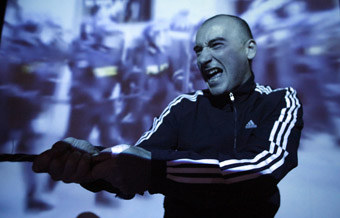
resist: the right to revolution, PVI collective
photo Bohdan Warchomij
resist: the right to revolution, PVI collective
THE SOUND AND SIGHT OF AN AUSSIE FLAG BEING SLOWLY TORN APART DOMINATES HUGE VIDEO SCREENS AT EITHER END OF AN ELONGATED BLACK-BOX SPACE AS THE AUDIENCE FILES IN FOR RESIST: THE RIGHT TO REVOLUTION, PART OF PERTH’S AWESOME ARTS FESTIVAL.
The atmosphere is energetic: a chaotic, kilted MC introducing a haphazard band while two tracksuited contenders, in red and in blue, repeat an individual tug-of-war over a tightly gripped flag.
Audience members, on their way in, have each been given a red satin cape emblazoned with the name of a ‘champion’, anyone from Che Guevara to Anne Frank. As music thrashes and the tug-of-war continues, we’re informed that Australia is unlike many countries worldwide in having no bill of rights. A sterile female voiceover interrupts at intervals: “The battle will commence in [x] minutes.”
The right to revolution, we’re told, is a little known clause in many existing bills of rights: in other words, if the government lets the people down, the people have the right to overthrow it. Today, the audience will decide, by tug-of-war, whether this clause should be part of an Australian bill of rights. If the decision is YES, the bill will be delivered to one of WA’s civic leaders—live—and videocast back to the theatre.
To the sound of rousing march music, our MC heads out to the streets to gauge the will of the people. We’re asked to choose sides, guided by our two performer/leaders and, as a practice run, the FOR team throws imaginary stones and sets up the chant, “WAKE! UP! WAKE! UP!” Those AGAINST deflect the stones with mimed ‘sticks’ and stomp closer and closer. At its climax, the energy approaches that of a protest—the agression, the power, and, crucially, the will to win.
Next, two teams of seven are chosen, and a heavy rope is measured out across the centre of the space. I’ve chosen FOR. On my team are Sun Yat Sen, Golda Meir, Germaine Greer, Morpheus, the Dalai Lama, Spartacus and Malcolm X. While we prepare for battle, the screens show our MC canvassing shoppers on the bill of rights. He meets, predictably, with almost complete public apathy.
We’ve been promised that if the result is FOR, the bill of rights will be delivered to one of WA’s key civic leaders–today’s ‘target’ is Police Commissioner Karl O’Callaghan.
Kelli McCluskey and Steve Bull, the pvi collective co-founders and show co-directors, were interested in the tug-of-war both for its participatory possibilities—audience engagement is crucial to pvi’s work—and because they found it has a very real history as a non-violent confict resolution device. “There is a hardcore physicality to the action of tug-of-war,” says McCluskey. “The physical effort alongside the mental conviction for what you are fighting for seemed to us a really potent combination.”
The investment in an outcome has palpable effect as those holding the rope feel the resin on their palms and tighten their grip, and the audience on the sidelines gets ready to barrack. Bull says that with a full house the performance space becomes more like a sports arena: “It feels like the ownership of the work transfers completely to the audience, with us simply facilitating.”
On the day I attend, the audience is of modest size, but the sense of ownership is strong, intensifying as the tug-of-war begins. The live cross is now crucial—we in the room know we’re determining something that will happen in the ‘real world’ outside. After a bitter struggle, the AGAINST team wins.
In a short review it’s hard to convey the personal investment that resist: the right to revolution sets up. It’s a poignant moment, watching our MC, still at large, intone to the camera, “The will of the people has decided. The right to revolution will not be on the bill of rights.” He takes the scrolled document, sets it aflame and lets it drop to the footpath, watching with exaggerated reverence. It’s a surprising moment, and a poetic one.
There is no audience applause, no curtain call, the two tug-of-war leaders have left the stage, feel-good music is playing but we’re left in our black box until someone decides to get up and leave. Some kids are playing with the rope. We take off our capes and leave them at the door, no longer heroes for the cause. And afterwards, outside in the museum café, I overhear a family talking about whether Australia should or shouldn’t have a bill of rights.
pvi collective, resist: the right to revolution, directors Kelli McCluskey, Steve Bull, performers Ben Sutton, James McCluskey, Ofa Fotu, Sarah Wilkinson, production Mike Nanning; Western Australian Museum, Perth, Nov 23-28, 2009
RealTime issue #95 Feb-March 2010 pg. 47
© Urszula Dawkins; for permission to reproduce apply to realtime@realtimearts.net

50/50, What is Music?
photo Catherine Brice
50/50, What is Music?
AFTER 15 YEARS, WHAT IS MUSIC? HAS BECOME AN INSTITUTION IN THE AUSTRALIAN MUSICAL LANDSCAPE, AT THE SAME TIME CONTINUING TO CHALLENGE AUDIENCES, REFUSING TO COMPROMISE IN ITS PROGRAMMING AND REMAINING STEADFASTLY DEDICATED TO THOSE INTERESTED IN THE EDGES OF MUSIC IN THIS COUNTRY.
Although there were concerts in Sydney and Perth, this year the focus of the festival was on Melbourne and here the festival started with the John Wiese Ensemble from Los Angeles at the East Brunswick Club. A 15-piece ensemble of local musicians performed two half-hour versions of a piece that Wiese devised specifically for the occasion. Each musician played from a visual score based on a graphic deconstruction of their own name underlined with a measure divided into durations of one minute.
After a brief introduction from festival MC Sean Baxter, the musicians launched into the performance and it became clear that the music was not recognisable as John Wiese’s but belonging to the individual performers themselves. It was as if I was listening to solo performances from all of the artists at once with someone playfully hitting ‘mute’ and ‘solo’ from time to time. Yet that process produced a genuinely gripping and dynamic music that seemed to constantly mutate, pushing out in different directions before springing back with contorted vocals, slices of guitars and strings, the feedback of overblown horns, scattered percussion and noise punctures. Gradually the structure became obvious and I realised that, along with the meeting of the individual voices on stage, the piece was principally about duration, with the sound of minutes ticking clearly discernable.
The second night at the East Brunswick Club started in punishing style with a tag team set from noisemakers Lloyd Honeybrook, Marco Fusinato and Lucas Abela that in 15 short minutes contorted our collective cochlear until the close with ‘Justice Yeldham’ smashing a pane of glass over his head to cheers from the crowd. It was followed immediately with the cry ‘Bruuutal’ from Sean Baxter, which would bookend every set of the festival from here on in, and provided the perfect summation.
Next up Oren Ambarchi and Matt Skitz launched into a relentless set of thickly abstracted guitar heroics and fast paced, powerful and precise drumming underpinned with a driving double kick that was like hearing a tape of the history of rock music on rewind. Although too macho for my taste, the tension between the virtuosic drumming of Skitz, who drove the set, and the abstracted tones of Ambarchi’s setup was compelling.
Robert Piotrowicz followed on laptop and Doepfer modular synth. He gave an impressive performance that, after the previous set, seemed to simultaneously synthesise and deconstruct a digital take on doom laden rock aesthetics, allowing shards of heavy chords to occasionally escape before breaking them into fragments interspersed with bursts of noise and the rhythms of manipulation.
John Wiese closed the night, sitting before a modest looking setup of laptop, mixer and cassette player, and immediately let forth a sharp but detailed mélange of noise. Everything remained just beyond comprehension as a frenetic but focused mix with hints of voices, electronics and other incidental noises flew past with gradually more discernable tape interruptions. It was certainly difficult listening, but Weise’s creativity and attention to detail was exceptional.
Last event for the festival, but certainly not least, came the 50/50 performance at the ABC Iwaki Auditorium in Southbank. The night featured 50 acts, each performing for a minute back to back. There was a buzz in the air and the sheer size of the undertaking was evident upon entering the venue and seeing almost the entire floor covered with instruments and performers, leaving only the fringes and gallery for the audience. After a brief explanation of how it would all work, the night started with a count down from 50 to one on the giant screen behind the performers that would serve as timekeeper for the event.
Quickly it became clear that explosions of noise, thrash and yells were the order of the day but the consensus afterwards seemed to be that it was the exceptions to this rule that were most interesting. The performers focused on what they do and avoiding getting caught up in the excitement were most memorable: personal highlights included Clare Cooper, Breathing Shrine, Frances Plagne, Pig & Machine, Golden Fur, Kim Myhr and a trio from Clayton Thomas, Dale Gorfinkel and Darren Moore. Absoluten Calfeutrail submitted perhaps the only example of a gripping and intense noise performance while Bum Creek succeeded where others failed with an hilarious set in which they ‘electrocuted’ each other, emitting stabs of ground hum punctuated with their own screams. Ivens led the most engaging of the ensemble sets, in which different groupings of artists from the various acts performed together, fronting an intimidating assault of drums and vocals.
I was surprised at the extent to which the event seemed to form into a single cohesive piece despite the at times disparate nature of the individual performances. Perhaps because so many sets were presented in the time it would usually take to hear just one, I found myself listening to the event as a whole. This was certainly due to the dominance of noise, grind and shit rock throughout the program; however, the inclusion of numerous ensemble sets broke down the notion that we were listening to completely separate acts and the finale, in which all the performers exploded in a minute of celebration, made it clear that there was an involvement from each of them in the organiser’s larger vision for 50/50.
Despite a clear imbalance between the resources the festival poured into solo performances from featured and touring artists and those involved in 50/50, What is Music? took a great number of artists from the local community and presented them and us with a wonderful opportunity to celebrate that community as a whole as well as the individuals who comprise it.
What is Music? in Melbourne featured two other nights, staged at the Old Bar and Horse Bazaar and curated with the help of organisers from Sabbatical and Stutter. This is a move that I commend and think further demonstrates a focus on Australian artists across the festival. Special mention must be made of sound engineer Byron Scullin, whose work was impeccable.
Before the festival I wondered about the issues inherent in the huge numbers of local artists being given only a role in John Wiese’s Ensemble or one minute in 50/50, while a small number of international artists was each afforded a solo performance. However, it became clear while listening to the performances that rather than limiting the locals each benefited from being placed among the others. The performance from the John Wiese Ensemble was much more interesting than the solo performances, which it must be said seem to feature a rotating but similar roster of artists each year, and 50/50, while not flawless, gave audiences a unique snapshot of contemporary music in Melbourne at the moment.
What is Music? East Brunswick Club, Old Bar, Horse Bazaar and Iwaki Auditorium, Melbourne, Dec 13-19, www.whatismusic.com
See Gail Priest’s review ofWhat is Music? Sydney; and the selection of RealTime articles about What is Music? from the archive
RealTime issue #95 Feb-March 2010 pg. 48
© Ben Byrne; for permission to reproduce apply to realtime@realtimearts.net
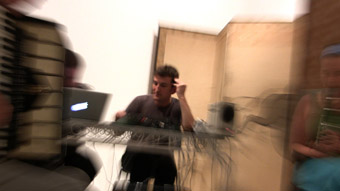
Peter Blamey, Monica Brooks, Laura Altman and Daniel Whiting, Difficult Music Festival
photo Nick Dan
Peter Blamey, Monica Brooks, Laura Altman and Daniel Whiting, Difficult Music Festival
THE SUMMER SWELTER OF SYDNEY HAS BEEN ASSOCIATED WITH A REASONABLY LIVELY EXPERIMENTAL MUSIC SCENE FOR THE LAST FEW YEARS MAINLY THANKS TO THE NOW NOW FESTIVAL (SEE REVIEW, RT96). HOWEVER THIS YEAR IT REACHED A VERITABLE FRENZY OF ACTIVITY WITH THE ADDITION OF THE DIFFICULT MUSIC FESTIVAL.
Run by the core team of Nick Dan and Nadine Pita with Damian Sawyers and other guest curators, the Difficult Music Festival heroically presented a gig every night in January. The majority of events took place at Sedition, the legendary barbershop in Darlinghurst run by Michael Joyce (who came up with the idea), which has been hosting the weekly Apostasy series amongst other events since 2007. Waking up slowly to the year, I finally made it to some gigs in the festival’s final week.
Monday January 25 saw the small shopfront packed (by about 30 people) to hear Ivan Lisyak, Ben Byrne and Dale Gorfinkel. Lisyak pointed his guitar to a small amp perched on a sink and sculpted the feedback. Well controlled, it was loud but never crossing over to pain, neat and punchy in its timbral and tonal investigations. Ben Byrne, visiting from Melbourne, played an old tape machine and laptop carnivorously patched together, his fingers spasmodically swiping back and forth across a mini Kaoss Pad pad to manipulate random snatches of sound, creating serrated edges to his densely textured wedge of noise. Both sets were satisfyingly succinct, appropriate considering the steamy climate.
Given the tight squish it was fortunate that Dale Gorfinkel didn’t bring his vibraphone but rather played trumpet, employing some of his now customary devices: backyard-invented small motors which introduce chance elements and make styrofoam cups spin and little balls bounce around in jars. Gorfinkel has been developing his ideas around extended technique, instrument building and improvisation over the last few years and he is fascinating to hear and watch. Using circular breathing he guided us through a playful soundscape of squeaks, burbles, blobs and whirs. Gorfinkel has created a unique performance style that is unassuming, yet commandingly showman-like. His makeshift toys sat well amidst the outsider art that adorns the walls of the shop.
Unfortunately after the following evening’s performance the nightly crowds of people swarming around the shop drew the ire of the neighbours and the final gigs for the festival became nomadic. I caught Wednesday January 27 at The Cross-Art + Books in Kings Cross. In the less charged and, let’s admit it, more comfortable atmosphere—a neat, white airy reading room lined with books—the three sets were more extended. Laura Altman (also curator for the evening) played clarinet with Monica Brooks on accordion. Exploring the threshold between sound and no sound, Brooks plays tiny sustained notes with bellow sighs, while Altman breathes through her instrument, eking out minute squeals. It’s the second time I’ve seen the pair play super quietly together, and while the exploration is rigorous and intriguing, I do occasionally long for a contrast to what sometimes can seem either like gentility or timidity.
Peter Blamey and Daniel Whiting are loud and dense in comparison, yet in reality this duo also exercises considered restraint. Blamey tames and shapes the blurp and stutters of his mixing board, which, when plugged in wrongly takes on a life of its own. Whiting deftly walks a fine line between pretty melodic snatches and hard electronic detritus, and together they create a place of broken rhythms and textures in which you can lose yourself.
The final set brought all four artists together: small sustained tones from the women, playing with shifting harmonic spectra, grounded by electronic grit from the men. Extra dynamic was added by some of Whiting’s offerings which occasionally verged on melody and acted as kind of a glue between the players.
The official final night of the Difficult Music Festival (there was yet another gig on Feb 2) was curated by Sumugan Sivanesan and found a home at Locksmith Gallery in Alexandria—probably better placed since the deserted thoroughfare of Regent Street was a far less conspicuous place for the mayhem on offer. Stepping onto the bill at the last moment was WT Norbert, recently relocated to Australia from Berlin, who played a short and humble set on an instrument constructed of 1/4inch jacks and effects pedals. While he admitted that this was his first gig for many years, his curious brand of minimal glitch was appealing.
X-No MSG-X was up next, a totally trashed display of non-sensical screaming and out of control exhibitionism which doesn’t warrant serious comment, though the miniature rave that emerged after much spazzing about did excite the kids. This was followed by the songs of Dominic Talarico which are not so much difficult music as just lo-fi electro-pop. With witty lyrics about meatheads and being a bong slave, he had a certain charm and once again had the kids dancing.
The final set was a face-off between Defektro, with his elaborate noise instruments, and Justice Yeldham (Lucas Abela), returning to his fan-mounted record attacked with a miked up skewer. The eviscerating sound of Abela’s instrument rendered it not the most sensitive tool for collaboration, but once the set evened out some interesting tones and structures emerged, particularly from Defektro. Being fearful of decapitation by vinyl, and even more afraid of Defektro’s gas bottle powered percussive flame thrower, I experienced this performance from the street looking in. All up a fittingly extreme end to an extreme festival.
While this vast array of artists and interpretations of ‘difficult music’ was going on nightly, the Sydney Festival/Modular Circa 1979: Signal to Noise forums were presented at the Seymour Centre, in which the heyday of post-punk was raised to holy status, and there were moans about how different times are now, with kids frittering away their time on Facebook. Well, it is certainly harder to live without the shackles of a real job these days, but the Difficult Music Festival, which was free or entry-by-donation and completely DIY (along with other independent events across the year), puts the kibosh on the assumption that this generation is just waiting around for things to happen. If you add in several extra gigs by the whirlwind duo of Clayton Thomas and Clare Cooper now based in Berlin, as well as Cooper’s inaugural two day audiovisual festival Smack Bang! at the Red Rattler, Sydney this January truly felt alive with the sounds of experimental music.
The Difficult Music Festival, Sedition and other venues; http://www.myspace.com/seditionapostasy; Jan 1-31
RealTime issue #95 Feb-March 2010 pg. 49
© Gail Priest; for permission to reproduce apply to realtime@realtimearts.net
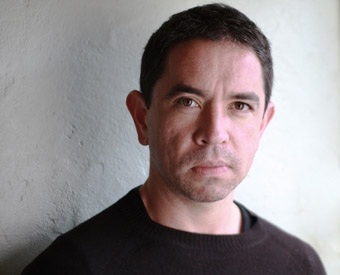
David Young
photo Daisy Noyes
David Young
IT SURPRISES DAVID YOUNG THAT TWO TO THREE YEARS AGO HE COULD NOT HAVE IMAGINED HIS EXISTENCE OUTSIDE OF APHIDS, BUT NOW, MOVING ON TO THE ARTISTIC DIRECTORSHIP OF CHAMBER MADE OPERA, HE LEAVES KNOWING THAT APHIDS IS SUCCESSFUL AND SELF-SUSTAINING AND HAS A STRONG TEAM, INCLUDING YOUNG’S LONG TIME ARTISTIC ASSOCIATE, ROSEMARY JOY. AND IT’S THE RIGHT TIME FOR HIM TO LEAVE. ABOVE ALL HE’S DEEPLY SATISFIED, AFTER 15 YEARS, THAT THE COMPANY, ACCLAIMED IN AUSTRALIA AND OVERSEAS FOR ITS INVENTIVE HYBRID ART CREATIONS, FUNCTIONS AS “AN ARTWORK, NOT JUST A SET OF PROJECTS BUT ORGANIC, AN ECOLOGY.”
The position of artistic director has been advertised. It’s timely for Aphids, Young thinks, “to have a new injection of ideas. Projects and tours are in place for 2010, so the incoming artistic director can enjoy focusing on 2011 and beyond.”
Asked why he was attracted to the Chamber Made Opera job, Young says that outside Aphids there had only ever been two organisations in Melbourne in which he thought he might play a role. The first was Next Wave, which he directed in 2002, the second Chamber Made Opera. Both have offered opportunities to support and develop contemporary Australian work and been open to embracing a wide range of art forms and practices: “So it seemed a logical step for me to go from Aphids to Chamber Made Opera.”
While Young “enjoyed the ambiguity of Aphids” he’s amused that he sometimes found it complex to explain just what the organisation is, given the sheer newness of what it does. “I feel I’m moving into more defined territory with Chamber Made Opera: people at least have some concept of what opera is. But I’m hoping also to challenge that expectation.” Aphids has effectively rewritten our expectations of the music concert and the installation by merging them, explored the relationship between experimental film and contemporary classical music and, not least, reworked the audience-performer space in works of intimate scale whether of music or puppetry, as well as asking what actually constitutes a musical instrument—in Rosemary Joy’s exquisite creations.
For 20 years, led by founding artistic director Douglas Horton, Chamber Made Opera has been the only company in Australia consistently dedicated to the creation of often innovative and memorable new operas. Young is determined to continue the company’s tradition of producing chamber operas of medium size, but will introduce “works of different scale, different models, for example adding miniatures that offer opportunities for touring—and sooner rather than later. Touring is the only way for the company to survive and broaden its audience base. We already have plans for interstate and overseas activity.” Young can add to the touring potential by drawing on Aphids’ success in the creation of cross-artform, intercultural partnerships across state borders and between countries—developing works, for example in Belgium, Japan and Mexico.
Young thinks that his new venture will benefit from “fond memories of the company’s 20 years, the strong feeling and goodwill for Chamber Made Opera in Melbourne.” As with Aphids, Young believes that Melbourne will provide Chamber Made Opera with a strong base. “New work will be made in Melbourne and travel, or be made overseas and then be shown here.” He quips, “I see my job as an international appointment.” But he means it.
Young sees opera, a hybrid form right from its 16th-century inception, as “a springboard for creating new kinds of work, including a reimagining of chamber opera itself—with musicians, architects or visual artists.” He’ll commission works and is keen, as a widely played composer, to occasionally create something himself for the program (“it’s not going to be all about my work!”).
There’s a certain timeliness to Young’s appointment. It corresponds with the great promise inherent in singer and festival director Lyndon Terracini taking up the artistic directorship of Opera Australia—“It sets the right tone,” says Young. As well, Chamber Made Opera and Opera Victoria are nurturing new opera music theatre works in their NOVA (New Operatic Ventures Australia) project. A call was put out for proposals in 2009: “Many more were received than we expected. There’s clearly a great need. Six works have been selected for workshopping in August and subsequent showings. It’s important that very different organisations like Chamber Made Opera and Opera Victoria work together. Some of the selected works will suit one company rather than the other, but all have potential.”
After 15 wonderfully creative years with Aphids, David Young is clearly already enjoying his new role with Chamber Made Opera, bringing to it a mix of continuity, new vision and ambition. The synchronicities of Terracini’s appointment and the Victoria Opera project partnership could bode well for opera and music theatre in Australia. It’s about time.
It intrigues me that the first work I saw by Aphids was Ricefields, in 1998 at Sydney’s The Performance Space (the work also played in various settings in Melbourne, Brisbane, Tokyo and Belfort in France). At the time I was closely following what appeared to be the improving fortunes of Australian music theatre (pretty well over by the early 2000s), and although Ricefields was a subtle synthesis of concert and installation it also exuded a magical theatricality. When RealTime edited the first of the Australia Council’s In Repertoire Series in 1999, it promoted to the world operas and music theatre works ready to tour—and we just had to include Aphids alongside Chamber Made Opera and others. Now, in 2010, I look forward eagerly to a new Chamber Made Opera, taking on the world.
RealTime issue #95 Feb-March 2010 pg. 50
© Keith Gallasch; for permission to reproduce apply to realtime@realtimearts.net
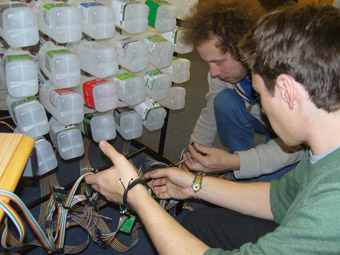
Milk Pixel, Robotics Lab, Craftivism
photo courtesy the artists
Milk Pixel, Robotics Lab, Craftivism
WE USE OPEN SOURCE SOFTWARE WHILE TORRENTING THE LATEST HBO SERIES; REDUCE OUR CARBON FOOTPRINT BY FLYING LESS WHILE IGNORING THE CONGO GENOCIDE FUELLED BY MOBILE PHONE CONSUMPTION; EAT LOCAL PRODUCE WHILE DRINKING IMPORTED BEER AND WINE; FORTIFY GLOBAL CORPORATIONS BY RECYCLING AT EBAY AND PURCHASING INDIVIDUALLY CRAFTED OBJECTS AT ETSY. ARE THESE IDEOLOGICAL INCONSISTENCIES, OR THE REALITIES OF C21 ANTI-GLOBALIST CULTURE WHICH EASILY MIXES GREEN IDEALS WITH INDUSTRIAL ENTITLEMENT?
Nowhere is this better illustrated than in our enthusiasm towards today’s iteration of the Gothic revivalist Arts and Crafts Movement. Although the original 19th century movement was largely a reaction to industrialisation—advocating traditional craftsmanship and economic reform—it also recognised the necessity for machines to carry out tedious, repetitive tasks. Inspired by John Ruskin’s writings it espoused the pleasure and intimacy of making, along with the moral imperative of art to better society. A century later one of its mutant off-spring is Craftivism, a term coined at a knitting circle in 2002 to describe the Political Activism meets Craft Practices movement.
Materially agnostic, the Craftivism event at Arnolfini in Bristol, perfectly captures the hand-made Zeitgeist. Artworks emerge from almost anything: textiles, cellophane, wood, bread dough, recycled clothing, string, YouTube videos and computer code. Skills and knowledge are shared in the gallery via knitting and knotting, mapping free urban food locations, and pure:dyne real time video and audio processing workshops. Information is replicated through a spectrum of technologies—from ye olde brass rubbings, post-it notes and photocopiers to a carefully crafted user-generated wiki containing extensive video documentation.
There is a direct relationship between the rise of DIY craft and the World Wide Web. Both date themselves from 1994, with the early days of art on the internet characterised by artists taking up the tools of technology to craft code: challenging museum hierarchies, reinventing distribution systems and building collaborative communities across the globe. It’s fitting then that one of the highlights of Craftivism is the inclusion of those pioneers of net art, JODI.
Over the 15 years they have been creating code art, the changing web has elicited an array of humorous and critical responses from JODI. In YouTube Records they again succeed splendidly in making us reconsider the familiar with an absurd conceptually and materially looped work. JODI take the audio tracks of YouTube videos of people singing about the Internet, usually in their bedrooms, and etch them onto vinyl records. The vinyl then becomes an artefact of performance, being videoed while playing on a turntable in the gallery.
In a parody of net celebrity, persona and identity, the video of the vinyl playing is then posted back to YouTube as a response to the original video. And so on…However JODI’s vinyl of someone covering someone else, covering something else is for sale. Work that copyright out!
Delving into another type of celebrity, Handmade Hero explores the culture of pro-wresting—a form of theatrical athleticism which originated in 19th-century carnival sideshows and music halls. As matches are choreographed with scripted outcomes, the wrestlers’ larger than life personas are vital for audience engagement.
Artist Rhiannon Chaloner has been working with Bristol-based wrestlers to design and construct their masked and costumed alter-egos. Strikingly similar to the way users approach their online identity and avatar personality construction, these wrestling personas are constructed from a mix of the purely fanciful with a reappropriation of the wrestler’s everyday identity. Handmade costumes, such as a magnificent cape of stitched together silk business ties, will adorn local wrestlers when they face off in Craftivism’s satellite wrestling matches in January.
Mandy McIntosh and the West Country Knotters sounds suspiciously like a good-time folk meets neo-punk band, however this former Kenzo knitwear designer and the West Country branch of the International Guild of Knot Tyers are seriously into macramé. No, don’t think of hideous 1970s hangings, but rather contemplate the sophistication of textile-making using ornamental knotting, as popularised by sailors decorating anything from knife handles to parts of ships.
McIntosh and the West Country Knotters’ joint project, Extended Family, is a social and play space within the gallery, with hanging macramé book cases stuffed full of McIntosh’s personal craft reference library which dates back to the 1970s; a macramé hammock and swing in which to relax or browse books; and a photocopier to enable gallery visitors to take patterns home. Again a subtle circularity emerges—the crafting circle uses the book patterns to build the objects that now hold them, at the same time creating a skill-sharing and resource platform, which in turn proliferates their production and distribution.
Craftivism could have felt a little preachy if it were not for its uncurated satellite event, UnCraftivism. Over the opening weekend, anyone could book a space in the Arnolfini building via a post-it note whiteboard schedule in the foyer. Surprisingly, or not, this thoroughly unpredictable, self-organising method produced some of the most engaging outcomes of the show, which are well video documented on the Wiki.
The local Dorkbot chapter (people doing strange things with electricity in the West of England) had a fun array of inventions to play with, including a lovingly crafted wood and copper mechanical eye prototype with natural looking eye movements that followed people as they moved around. I submitted myself to 20 minutes of green noise in a Ganzfeld Experiment that supposedly hacks the brain and cleanses the mind. As it didn’t induce the promised hallucinations, and I felt silly with ping pong balls taped to my eyes, I went searching for other sorts of stimulation.
Next stop was the Bristol Knowledge Unconference room, where talk of Knowledge from scientific and new-media perspectives accompanied by geeky nods was interspersed with poetry readings. Up the hall, in the Members Room, several artists spent the weekend hacking the building itself—constructing a scary giant cellophane string, paper and wool insect hive between bookshelves and furniture. I came back the following day to find the artists installed inside Touch me touch you, with just their fingertips emerging to entice the touch of passers-by.
Downstairs in the Auditorium I played my first game of Tambourelli, a musical variation of shuttlecock for two to four people played with a tambourine as a racquet. Flickering from across the room was Milk Pixel built by the Bristol Robotics Lab, an inspired re-use project incorporating LEDs into two-litre plastic milk bottles. The 64 bottle/pixel array continuously responded to sound performances and moving image in unexpected collaborations and improvisations.
Amidst this sometimes chaotic self-organising and generative environment the glorious ninth artwork Cultural_Capital provided conceptual stability as well as being delicious. Paralleling the use of bacteria and culture in that staple of life—traditional bread-making—Cultural_Capital is a touring artwork that acquires both bacteria and Bourdieuian value from its installations over a period of time.
For Craftivism the sour-dough starter was cared for by curators in the gallery, transforming over about a week into a mature sour-dough. It was then baked into bread and made into bruschettas which were appreciatively consumed at the openings. What could be better than art you can eat! Portions of the finished dough were distributed amongst guests who could use it all to make a single loaf, grow it for a continuous supply of bread dough or let it die. The curators retain a certain amount and the remaining starter is passed on to the curators at the next venue.
The strength of this work lies in its simplicity: designating a colony of living yeast and bacteria in a stable symbiotic relationship as a collectable work of art, and situating the curator as the carer of that lifeform which will die unless regularly fed. Cultural_Capital is still alive and has been installed and eaten continuously around Europe since it was launched in Cornwall in March 2009. Unfortunately you won’t taste Cultural_Capital here as the sour-dough starter cannot legally enter Australia due to our strict border protection regulations.
Crafitivism could have been mistaken for a warm and fuzzy Information Age Village Fair, espousing principles of commons, community and care with artists, curators and visitors actually talking to and working with each other. However beneath the artful surfaces, crafty textures and edible objects, subversive structures and essential networks were being cultivated around distribution, modification, customisation, skill-sharing, playfulness, risk, and intimacy. Here the individual is never the hero—rather in these places the pleasure is in the process.
Craftivism, Arnolfini, Bristol, UK, Dec 12, 2009-Feb 14, 2010 http://www.craftivism.net
RealTime issue #95 Feb-March 2010 pg. 51
© Melinda Rackham; for permission to reproduce apply to realtime@realtimearts.net
{$slideshow} HELD OVER EIGHT WEEKS AT THE AUSTRALIAN EXPERIMENTAL ART FOUNDATION (AEAF), GONE IN NO TIME (GONE IN NO TIME) DESCRIBES NOT SO MUCH A COLLECTION OF WORKS BUT THE UNFOLDING OF MULTIPLE PROCESSES THROUGH THE SUCCESSION OF FOUR SETS OF ARTISTS OR ‘ACTS.’
As a way of circumventing the static display of objects in a gallery space, each ‘act’ in the program was staged over the course of a fortnight by a pair of artists who actively produced work and also engaged with gallery visitors during opening hours. The work of each ‘act’ was left in the gallery for the succeeding ‘act’ as material to work with.
The teamed artists in gone in no time were, in successive ‘acts’, Annette Lawrence and Jacobus Capone; Yhonnie Scarce and Nicholas Selenitsch; Margit Brünner and Danielle Freakley; and Ardi Gunawan, Katherine Huang and Jason Sweeney with guest Fiona Sprott. A musical performance by AEAF director Domenico de Clario and Sweeney concluded gone in no time.
Given that one of the accepted assumptions of a gallery is that it divides, separates and binds discrete works of art within its neutral surfaces, gone in no time directly called this assumption into question, as objects were accumulated, erased, eliminated and transformed throughout its duration. At the same time, the ‘acts’ transformed the approach to making and exhibiting objects, as artists had to consider working within a dynamic and evolving field of relationships effectively collapsing art’s historical boundaries, such as object/ field, support/supported, close/distant, process/product. While within contemporary art circles this might not seem so unusual, gone in no time went further by dissolving the distinctions between the process of creation, creation itself and the life of the artist, making them one. It is therefore extremely difficult to write about individual works; rather, in discussing gone in no time it is more productive to describe the unfolding of a single project that multiplies space thereby extending the idea of the gallery in both spatial and temporal terms.
Three aspects of gone in no time are of particular interest. First, as indicated, the framework is noteworthy through its activation of time while enabling artists to engineer or intensify (or take up the option of) the accidental and the surprising and, in effect, to bring about a transformation of the space. This was made possible through the exhibition’s sequential revelation, which enabled gone in no time potentially to make, unmake and remake itself. Ardi Gunawan’s reconfiguring of movement through the gallery space, by repositioning and tilting the gallery’s moveable internal walls each day, altered the perceptual field of observers and their connection to the work, while Danielle Freakley (of Quote Generator fame) literally disassembled the space by destroying the work of previous artists, transforming the gallery into an infrastructure of various shifting micro–spaces. Similarly, Katherine Huang’s sensitive placement of an assortment of small mirrors, vents and air-conditioning tubing throughout the space both revealed and explored these spaces through strategies of framing and mirroring at micro scale. In an enjoyable pairing of artists, Huang’s exploration was on such a divergent scale from Gunawan’s that together they produced a cinematic effect, the observer continually negotiating the differences.
The second significant aspect of gone in no time was in its being primarily experiential. Objects matter less than the relations between them: everyone and everything moved either by increment or at incredible speed through the activation of the temporary, the ephemeral and the changeable. For the observer this meant that no single or coherent image or artefact independently embodied the totality of the exhibit. Rather, what one recalls is the multiple fleeting impressions, moods, atmospheres or the ambiences of the gallery space rather than individual objects. The atmospheric drawings of Margit Brünner, for example, both generate and are generative of part of gone in no time’s multiple moods. Collapsing the distinctions between object and subject, the sense and the sensed, the drawings consist of dense layers of delicately produced coloured lines applied directly to the wall by a range of drawing instruments, some up to three metres long. The instruments altered the artist’s relationship to the surface by extending the body, at the same time enabling her to extend what a wall can be. The drawings produced a new depth (as opposed to flatness) by absorbing the observer within a perceptual field that alters the one-to-one, front-to-parallel relationship the observer customarily has with a vertical surface. This field enables the observer to test various distances and positions from which to view the work, at the same time cunningly propelling the observer into motion. Similarly, a particular atmosphere is evoked through Annette Lawrence’s abstract calculations. But unlike the sensuous experiences evoked by Brünner’s drawings, her work depicts an abstract landscape of information made visible through number, pattern and iteration. Informed by the cycles of the female body, Lawrence’s work is both self-reflecting and self-neglecting, tracing the body’s movements through time and space and therefore through another possible dimension—the unreal or the virtual.
The third aspect of interest was that objects in gone in no time were ‘monstrous.’ Substituting promiscuous objects for autonomous ones, creates a deviation from what one expects to find in a gallery space. The stability and circumscribed nature of objects is cast aside for the materially and programmatically malleable, deformable, transformable, bendable and able to be destroyed—gone in no time is, after all, about ruin. Consequently these objects began to take on properties of other works, making it difficult to determine where one artist’s work began and another ended. Jacobus Capone’s work, derived from rituals of “futility, pointlessness, moments gone,” exhibited this monstrous capacity through patterns that slowly threatened to engulf the entire gallery space in continuous expansion. The patterns turned out to be an interesting trajectory to monitor through the several acts of gone in no time. The work took on a second life after Nick Selenitsch sought to discipline the work in Act Two simply by ‘cleaning it up’ only for the work to then undergo a third mutation after Danielle Freakley decided to do a brutal aerosol number on what was initially a delicate surface pattern in Act Three. All of this left Capone’s initial work in a state entirely ‘other’ than how it started out.
These three aspects of gone in no time—its micro-spaces, the monstrous nature of its objects and its varying atmospheres and moods—are provocative and can be extended by analogy with Gilles Deleuze and Felix Guattari’s ideas of “minor language,” whether or not a conscious influence. If a succession of art movements, styles and artistic figures describes a “major language”—of both the art historian and the institution—then a “minor language,” according to Deleuze and Guattari, is marked by the unruly and heterogeneous, where titles, names and objects fall between stable categories while opening them up to networks of proliferation and connection. In this respect, gone in no time invites consideration in terms of the Fluxus ‘movement.’
While some might dismiss gone in no time as an experiment that overshoots its mark or as underdeveloped or misguided, such assessments overlook the questioning of ideal forms and stable categories that marks gone in no time’s complex relationship to both power and history. Now that all is gone the question remains: how to account for it?
A selection of images and movies which in part document gone in no time can be seen at www.eaf.asn.au/2009/goneinnotime.html
Australian Experimental Art Foundation, gone in no time (gone in no time), Adelaide, Sept 15-Nov 7, 2009
RealTime issue #95 Feb-March 2010 pg. 54-55
© James Curry; for permission to reproduce apply to realtime@realtimearts.net
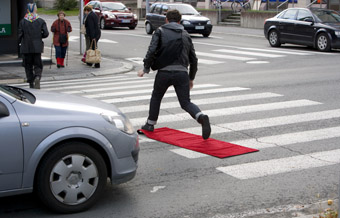
The Red Carpet Treatment, Vincent Chevalier; ANTI – Contemporary Art Festival, Kuopio, Finland
photo Pekka Mäkinen
The Red Carpet Treatment, Vincent Chevalier; ANTI – Contemporary Art Festival, Kuopio, Finland
I AM IN KUOPIO, FINLAND AT ANTI, THE INTERNATIONAL LIVE ART, SITE-SPECIFIC FESTIVAL THIS YEAR CONTEMPLATING WALKING AS PERFORMANCE, AS A WAY OF UNCOVERING THE STORIES OF THE CONTEMPORARY CITY AND RECONFIGURING PUBLIC SPACE.
I approach the city as an outsider, a curator who already recognises the potential of live art to uncover schisms through which new meaning can emerge. However, I have never before seriously thought of walking as an act of transformation. I have legs, a map and some artists to guide me and through my own act of mundane motion I hope to discover an alternative city, a place that sits just outside usual perspective, recognisable but shifted into something moving or profound.
I have no previous experience of Kuopio, no prior affinity or particular empathy. My first impressions are of autumnal change, days caught between seasons with people in big hats and stout boots. Teenagers hang in bus stops and in the early hours old ladies wheel bikes through impressively drunken throngs hugging the pavements. In All the Demos I’ve Ever Been On, my partner Alex Bradley (UK) stomps the street in a repeated oblong for five days, a solemn, solitary demonstration of his own history of political activism. Transposing Kuopio for London, Kauppakatu becomes Embankment and Kaupungintalo the Houses of Parliament.
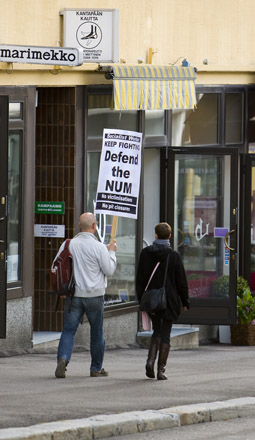
Every demo I’ve ever been on (1985-2009), Alex Bradley; ANTI – Contemporary Art Festival, Kuopio, Finland
photo Pekka Mäkinen
Every demo I’ve ever been on (1985-2009), Alex Bradley; ANTI – Contemporary Art Festival, Kuopio, Finland
For the first few days Bradley is quietly insulted or largely ignored by Kuopio’s residents. With constantly changing placards that scream defiance in clipped English sentences, he relentlessly supports the working class, long-gone British industry, the marginalised, the victimised and the poor. He supports the Miners’ Strike of 1984, the Ambulance Workers and the NHS [National Health Service], protests against the Poll Tax, Apartheid and Clause 28 [which prohibited local authorities from promoting homosexuality; enacted 1988, repealed 2000-03]. On his fourth and fifth days his placards shout of the global anti-war movement and at this point the people of Kuopio gently start to wake up. A police car idles past repeatedly, a punk shows him a victory sign, an older man shouts “Bless You” while another gives the thumbs up. We are told there is no significant history of public protest in Kuopio or indeed more widely in conservative Finland, but in the confusing mess of reaction and interaction Bradley’s 48 mile demonstration seems like it is starting to be noticed, just at the point it’s about to be gone. As he puts down his last placard a series of questions hangs in the air above the route of his protest, who are the Finnish disenfranchised, what statements fill their placards, whose future voices will rise to be heard?
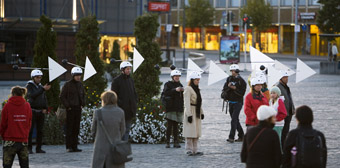
Live Windwalks, Tim Knowles; ANTI – Contemporary Art Festival, Kuopio, Finland
photo Pekka Mäkinen
Live Windwalks, Tim Knowles; ANTI – Contemporary Art Festival, Kuopio, Finland
What do the market squares, shopping centres, parks and harbours of Kuopio mean to the artists, these outsiders? Will they rewrite these streets as they tread themselves into the tarmac and earth? Tim Knowles’ Windwalk (UK) takes place in a violet market square as the sun sets and a collection of participants gather with comical helmets and sails on their heads. The instructions are liberating and simple. Follow the wind and go as far as it takes you. Let the sails lead you through the streets, around all obstacles. People scatter like pollen, grouping then dispersing, caught in eddies and dark corners until one or two are freed on the outskirts of the square to range around the city, ignoring normal routes or obstructions in a kind of free fall with feet firmly on the ground. The work is a delightful statement of otherness and freedom in a city that appears not to mind either. One woman apparently travels miles before stopping in darkness against a wall.
Experiencing Rotazza’s theatrical illustration of a supermarket, Wondermart (UK), there was one single moment—when I was asked to open a fridge, stare at the white plastic and feel the frozen air—I found utterly transporting. Mostly however, I found the work predictable. Seduced by the tinned reindeer meat and weird mushrooms on the shelves before me, I embarked on an adventurous walking project of my own through the market. On the street, Vincent Chevalier unfurls a simple red carpet before him throughout his five days in the city (The Red Carpet Treatment, Canada). To see the artist approaching from a distance in slow chaotic determination is like watching a relentlessly bobbing minor television personality who remains just a little bit apart from the rest of us. It is a funny work of public endurance and there really are not too many of those.
Even in Kuopio the streets can be brutal. Despite the differences in their work, all the festival artists mention the pain and fear of being alone, of being vulnerable and the pressure of forever being on show. They talk of keeping to the path, following the map and ensuring always to bed down in safe places. They know their bodies’ limits. Blisters, wet feet, insect bites or any other minor affliction could ultimately finish the work. None of them speak of extreme acts of endurance but more of deliberately paced endeavours designed to push them on. The road acts as a score and their eyes are fixed on the approaching horizon, or what’s around the next corner or on the small path trodden by adventurers before them and passing less obviously between the bins, parked cars or trees.
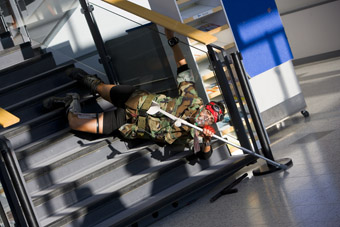
Roberto Sifuentes, The “Pocha Nostra” performance intervention brigade, Kuopio airport; ANTI – Contemporary Art Festival, Kuopio, Finland
I see La Pocha Nostra (US/Mexico) who have sought out a covered walkway between fast food joints and department store to one side of the main market square. Here the public move quickly and tell of dealers and streetfights as the young and disaffected congregate in the glare of shopping centre lights. Five La Pocha Nostra characters enter, like barbarians from a freezone with identities distilled and distorted. A young Finnish punk faces off the genuine article, Guillermo Gomez Pena, in wheelchair, tulle skirt and head-dress with wise, black khol-rimmed eyes. Roberto Sifuentes dressed in military fetish wear shivers as he inserts saline solution into his eyes, spurting the water onto the pavement until the tears really come. A sign announces he has served in Iraq and seeks resident status in Finland. His ritualised plea, or apology, is largely ignored by passers-by. The artists remain long after the festival audience has departed and I realise we are not the intended participants. As the sun sets behind us only Kuopio’s punks float in fascination, temporarily giving over their territory in half-understanding as the temperature plummets.
Place is not static, it is rewritten by the performances that happen each day. I wonder if the psyche of Kuopio has been changed by the eight years that ANTI has been playfully interfering with its solid structures and tidy grid-like paths. I notice the public, their performances of not-looking played out in sideways glances or speedy road-crossings in the face of ANTI’s strange artistic goings on. In Bodycartography (US), a woman is framed by the dirty ramp into a car park as she bends double. Another woman hugs a bin for 10 minutes while a man lies on the pavement with a lamppost between his legs. How much do the artists disrupt the domestic goings-on? A few cars crawl past and a lady in a fluorescent track suit walks quickly as though she is part of the weird passing circus, but she is not. A normal town, on a normal day.
On a beautiful bright day, I walk with Stephen Hodge (UK) in SLaaristokaupunki [http://2ndlive.org/projects/slaaristokaupunki.php]. We leave the sensory overload of the outside world to enter a bland office space and sit before a laptop, a doorway into Second Life. Here I enter an island and walk under water without oxygen, traipse a beach without feeling the sand between my toes. I teleport from my island back to the beginning but with no sense of movement, time or distance. I leave Hodge’s’s guidance, Second Life and the office building to walk by the lake in the white light and perfect blue of the morning. It seems almost like dream space, caught between real and virtual, its lines so perfect and colours so precise. As much as I’d like to, I cannot teleport but I take comfort from the concrete certainty of the road and my heart thumping as I walk uphill.
At ANTI I find an adventurous spirit and strike out into the unknown. I give myself permission to walk where, when and however I damn choose. I walk without trepidation and look to the horizon where I meet helpful strangers. I discover beauty because I have looked for it. I find adventure in ordinary, wild or dirty landscapes. I am now a walker and I will only whisper the stories of my own vulnerability, of the darkness and its dangers, the bears and wolves that might lurk therein.
ANTI Contemporary Art Festival, Kuopio, Finland, Sept 23-27, 2009
Helen Cole will present Collecting Fireworks, a growing archive of Live Art, as a Members Event as part of Performance Space, ClubHouse program, Sydney, March 2-3 and at Artshouse, Melbourne, March 17-19
RealTime issue #95 Feb-March 2010 pg. 19
© Helen Cole; for permission to reproduce apply to realtime@realtimearts.net
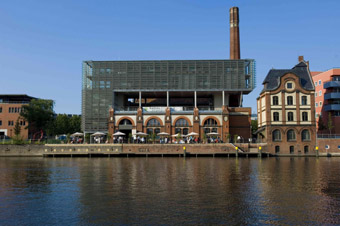
RadialSystem V, Berlin, view from the River Spree
photo Sebastian Bolesch
RadialSystem V, Berlin, view from the River Spree
A TWO-DAY FORUM, NEW SPACES AND SYSTEMS FOR THE ARTS, CREATING CONNECTIONS—CONNECTING CREATIVITY, HELD AT AND ORGANISED BY BERLIN CONTEMPORARY ARTSPACE RADIAL SYSTEM V IN LATE OCTOBER 2009, WAS A HOTHOUSE (IN FREEZING WEATHER) OF RESEARCH DATA, PRESENTATIONS AND DEBATE ABOUT A RAPIDLY EXPANDING PHENOMENON. IN CITIES AROUND THE WORLD, FORMER INDUSTRIAL SITES ARE BEING CONVERTED INTO ARTSPACES PRINCIPALLY DEDICATED TO HYBRID FORMS AND ACROSS-THE-ARTS PROGRAMMING, AND ACCOMMODATING AND GENERATING NEW AUDIENCES WHO ENJOY ART WITHOUT BOUNDARIES.
The elegant four-storey Radial System V, a former water pumping station is located on the River Spree in a relatively undeveloped area of Friedrichshain. Housing two ample performance spaces, rehearsal rooms (including a large space used by Sasha Waltz’s resident company), a bar and restaurant, and a big, sheltered second floor space open to the elements, Radial System V is at once intimate and capacious. Atypically for the centres participating in the forum, it is not funded by the city, although the artists who perform there might be. It’s an independent venture on commercially owned land. Co-director Jochen Sandig said at one point in the forum that it would be preferable for the organisation to own the land, perhaps raising funds to purchase it by selling ‘shares’ to supporters.
Despite its relative independence Radial System V faces many of the same problems as its city- and government-funded guests with whom it was eager to discuss shared challenges and strategies for improved conditions. Above all, it was agreed that the new artspaces were providing governments with artist-led urban renewal. Art-led gentrification has moved like a wave through Berlin since the 90s, especially in the former East Berlin (and Jochen Sandig is one of those who has made the wave and ridden it) with Radial System V as a recent exemplar.
Fourteen centres (12 European, one Australian, one Indonesian) were represented at the event, most established within the last five years (or revitalised, like Hamburg’s Kampnagel), some brand new and others to be completed within a year or two. These are quite different organisations, reflecting local conditions and cultures, but the forum very quickly revealed similarities in inspiration and, above all, challenges for which mutual awareness and networking might aid survival and growth.
beginnings
While the conversion of former factories, warehouses, mortuaries, collieries and wharves into arts venues has a long history, this most recent manifestation of the phenomenon is more complex. Many of the organisations had been offered sites by the state or local government (or found a site themselves and sought support) in an area without other cultural facilities, with limited public transport and with a local population often not attuned to the arts. The pressure therefore has been to attract established audiences from other parts of the city and at the same time convert locals into arts lovers through often labour-intensive community programs. Some centres have been lucky enough to be supported by governments that have built public transport access into the early stages of development; others have been hindered by its absence.
For governments the opportunities of culture-led urban renewal in problematic suburbs is attractive in increasingly service-based economies. In terms of arts ecology there is evidence here of mutualism between the arts and government: between arts organisations seeking out new homes in relatively inexpensive city regions, homes that are flexible, responsive to the demands of a range of artforms and especially multimedia and hybrid practices, and governments keen to capitalise on culture as the first tool for urban regeneration. Sometimes it’s the arts organisation that makes the move, sometimes government, but as with CarriageWorks (a former train carriage building workshop) in Sydney, well before the venue was identified there was a very real need for Performance Space and a range of arts groups to find a new home.
For many of these centres, governments invested heavily in developing the sites. Sometimes artists and organisations were closely consulted, sometimes not, the ‘hardware’ being installed without thought as to how the ‘software’ would fit, for example how to cope with the technical demands of vast spaces. The next stage, of making the venue work and building audiences while promoting an identity (or re-establishing it in a new environment) was a serious challenge, labour-intensive and demanding. As a rule, governments have been less keen to provide funds for these spaces to invest in programming, commissioning and producing work, the very means they need to establish creative identity and the capacity to contribute to regional or international collaborations and touring networks.
Government expectation has often been that the artspaces will generate self-sustaining income rapidly through venue hire for local and touring productions, conferences, weddings and commercial trade events. This at the same time as building their own programs often with limited means alongside servicing local communities (with workshops, markets, child care) and, for some, benchmarks set for local audience numbers.
double binds
The challenges to these new centres, to their survival and especially to their sense of artistic integrity, have manifested as potential double binds: public/entrepreneurial; local/other; old (heritage site)/new; arts centre/social centre. Given that most have been set up by governments, even if in direct response to art community needs, there is also likely to be continuing pressure for these artspaces to enact cultural policy.
Maintaining programs with innovative, sometimes challenging content while running child care services and community events, isn’t necessarily an easy match. Unravelling these potential binds into healthy dynamics is hard work, but the binarisms were seen by some forum participants as evidence of a paradigm shift in the arts, of partnership-based centres (inhabited by a number of cooperating arts groups) that are innovative in all respects, addressing sustainability in multiple ways, operating holistically, essentially working ‘bottom up’ (responsive to the new forms that artists are evolving), interdependent (immediately networking) and developing a ‘hybrid audience’ who are already engaging with a range of media platforms in their everday lives.
Above all these centres yearn not simply to present work, but to commission, develop and produce it and, critically, debate the new forms with their public. This tri-partite thrust was seen as a break from the relative inflexibility of older arts institutions.
The artspaces also see themselves as meeting points for the advancement of theatre, dance, the visual and media arts and of interdisciplinary work—many have substantial workspaces for residencies and workshops. And many have aptly retained their factory origins in their name and architecture—as workplaces.
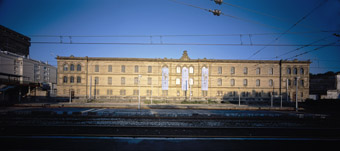
Tabakalera, Centro Internacional de Cultur
photo Idoia Unzurrunzaga
Tabakalera, Centro Internacional de Cultur
the new artspaces
In short introductory presentations and in discussion groups, directors and coordinators spoke about their centres, revealing the distinctiveness of each artspace as well as shared strengths and challenges.
Clara Montero is Co-ordinator of Activities for Tabakalera (www.tabakalera.eu) in the Basque country of San Sebastian, Spain. The building is a 150-year old tobacco factory currently owned by the city. Funded by the city and the Basque government, the centre will open in 2013 but currently runs events, such as inviting sound artists to work in the spaces. There is a strong focus on visual culture including cinema, video and media hybrids with studios available to artists and communities. There is also a considerable emphasis on archiving, in the form of a digital library with public access.
Montero sees the role of the new centres as integrative. Therefore, because the San Sebastian Film Festival is so strong, “we have taken it as a model.” She described the centre as being like a bridge. At the same time, Montero says she faces the big challenge of engaging 15-23 year-old audiences, and has done many free shows to attract people.
A few centres are more self-contained, focusing on artistic rather than audience development. Karen Wood is Creative Director, Briggait Development, Glasgow, which is run by Dance House (www.dancehouse.org). Originally it was a Victorian fish market, built in 1873, empty for 20 years and then converted to visual arts studios. At the centre is “a huge unheated hall,” a space common to many centres offering opportunities for spectacle and communality but presenting challenges. Established initially with lottery, arts funding and commercial support, the centre is, says Wood, “now into Phase 2, needing money. There are seven studio spaces, four resident organisations including dancers with disability, circus, aerial and street theatre people and a dedicated live art studio. It’s a venue for creation, not public performance and incidentally, the only place in Scotland where people can rehearse double trapeze.”
In contrast, Axel Tangerding, an architect and theatre director from Munich, spoke about Teater Maskinen (www.meta-theater.com), whose new building he has designed and which is located just outside of Stockholm—to keep costs low. In a former mining district by a river, the land was purchased for one euro per square metre. Designed to be ecologically sensitive, the centre includes a guest-house for 20 people, studios for work and creating video, a kindergarten, an outside theatre and a sauna—”It’s time the arts had a bit of luxury,” quipped Tandering.
Another new building is Amsterdam’s Muziekgebouw (www.muziekgebouw.nl), a spectacularly beautiful glass and metal construction located in “an old industrial district on the water, which used to be populated by drunks and hookers”, says Tino Haenen, General and Artistic Director. Unlike the other centres discussed here, the focus at Muziekgebouw is on one artform, music and more specifically again, contemporary classical concerts and jazz, and no pop concerts. Opened in 2005, the centre was conceived as part of a plan to develop the east of the city. Like the other centres “it’s very flexible,” says Haenan, “even the floor can be elevated, which means the space can be adjusted to change reverberation substantially.” The building has three decks and a unique microtonal organ, which is very rare. The centre’s annual budget is three million euros, one million going back to the city for rental (a not uncommon tale). Around 250 concerts each year are presented in a building “which is huge but has a nice human scale to it.” Haenan says he’s sticking very much to his agenda, not wanted to risk competing with local theatre.
Mohamed Goenawan is director and initiator of Salihara (named after the lantana flower; www.salihara.org) in Indonesia. When Tempo, the political magazine he edited was banned in 1994, Goenawan went underground, set up alternative journals and ISI, a space to produce plays and gallery shows as a front for political purposes. He continued to work after Soeharto had been deposed, and says he is now battling rising Islamic fundamentalism. Goenawan describes his organisation as “a medium to introduce difference.” With money made from the newspaper, he has developed the former garbage truck parking station into a 3,000 square metre arts centre. The only flexible performing arts venue in Indonesia, it can seat 225 people or 400 standing. There’s also a roof theatre for traditional puppets, a cafe and a gallery. Salihari also hosts noted performance and literary festivals attracting artists and audiences from the region.
Philippe Bischof, Artistic and Managing Director, Südpol Luzern (South Pole Lucerne; www.suedpol-luzern.ch) in Switzerland and staff member Eva Heller described the centre as being in an industrial area of the small city of Südpol, 10 minutes out of Lucerne—“but people still see this as ‘far out’.” Costing 26 million euros to set up, and with ongoing funding coming from city and private sources, Südpol opened in November 2008. There is, as was reported by most centres, no funding specifically for programming or commissioning.
The centre, which also includes a music school for 6-18 year olds and a state theatre company, is dedicated to presenting the performing arts including hybrid practices. The building is a former slaughterhouse, but 90% of it is new construction. The architect designed the centre to be very flexible, with four acoustically discrete performance spaces (discrete from the school and the theatre company) in the complex, a restaurant and a bar. The audience, says Bischof, often stays for two to three hours after a show and there’s a downstairs club that can handle 250 people. The performing spaces can handle 600 people standing. “There is no ‘scene’ in Lucerne. We have to create it.”
For Südpol internal management is important, with collectives participating in running the organisation: “If partners have equality (and both have money), it’s easier to negotiate than having all the money and power in one place.” Other centres have ‘top down’ management but there was much talk of keeping it open and cooperative.
Sergi Diaz the coordinator of Fàbrica de Creació de Fabra i Coats, north of Barcelona, describes their centre, still in the process of renovation, as a network of former textile factories—the biggest at 2,000 square metres. It also includes a community centre and a school. Opened in 2006, the focus is on dance, theatre and multidisciplinary practices and includes musicians working in the factory space thanks to project funding from Red Bull, popular music events and media arts shows. Diaz described the working conditions for artists as very good.
Lea Dolinsek, Public Relations Officer for the Spanski Borci (Spanish Fighters) Cultural Centre in Lubiana, Slovenia says the centre, a renovated cinema, which was soon to open on November 25, 2009, was named after Slovenians who fought in the Spanish Civil War. The space is home to and is managed by the award-winning dance company En-KnapGroup as a “meeting point for local, regional and international dance” (www.en-knap.com). It’s unusual for such a centre to be run by a discrete artform company, but see also the Nowy Teatr below. The building was purchased from the city, which invested 250,000 euros in the renovation, and another space was added for music “after pressure from the electorate.” The centre has a 350 seat studio space, a smaller former cellar space for 50 and a library.
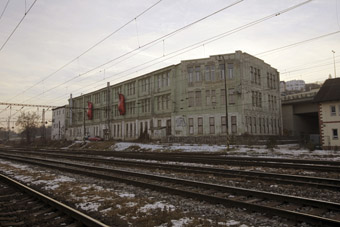
Meetfactory, International Center of Contemporary Art, Prague
photo courtesy Meetfactory
Meetfactory, International Center of Contemporary Art, Prague
Jindra Zemanová is Director of MeetFactory, International Centre of Contemporary Art (www.meetfactory.cz) in Prague, a 5,000 square metre facility leased from the city and focused on a residential program with 15 studios (40 to150 square metres) for visual artists (local and foreign) and theatre workers. There was no gas or water when Zemanová arrived, but since then a main theatre space (seating 150) and a gallery have been developed. The main hall holds 600 people. Far from ‘perfect’, the venue is very flexible: Zemanová reports that a Mexican artist knocked large holes in a wall as part of his project. Although MeetFactory as yet has no formal funding, she says that “the City of Prague is very supportive.”
Joanna Nuckowska, the Production Manager for leading Polish theatre company, Nowy Teatr (New Theatre; www.nowyteatr.org/#/en), Warsaw, tells us their huge new centre will be opened in 2012 in the former headquarters of the Municipal Waste Company. It will be an interdisciplinary, multifunctional cultural space presenting European co-productions, video, performance, actions and concerts. In the meantime, one-day events are being staged (Day of the Dead, 2008; Sleeping, 2009). A bookstore, cafe and facilities for children are included in the plan, a large roof garden and amphitheatre, plus a surrounding garden with concert space and open-air cinema. Nuckowska said that there will be a big emphasis on exchanging ideas with audiences in this the largest arts development in Warsaw for a long time.
Sue Hunt, CEO of Sydney’s CarriageWorks (www.carriageworks.com.au), described meeting the initial challenge of attracting audiences to a new destination (“there were no rules”) by running festivals for children and others featuring hip-hop and underground artists, supporting “ephemeral and unfunded” work in the first two years and programming the venue with resident arts groups. The principal of these is Performance Space which has four seasons a year focused on hybrid practices, plus residencies and special events. Two large, attractive performance spaces are used for mounting independent productions and commercial events, while other spaces accommodate workshops, rehearsals and residencies. There’s also a cafe and a gallery space. As with other artspaces, funding is largely operational with little room for investment in producing (see RT91 for more about CarriageWorks and Performance Space.)
Director Amelie Deuflhard, a much admired figure in art-led urban regeneration, has recently revitalised Hamburg’s harbour-based Kampnagel with a progressive performance program and “a lot of energy involved bringing together disciplines, community projects, a lot of work with children, all with the aim of ‘bringing Kampnagel to the city.’ I took it over when it was tired and it took two years to achieve flexibility.” She described a successful project called Talking Opera, an orchestral karaoke show for young people which was subsequently performed with older people, as a way of bringing together artists and audiences. Deuflhard believes that community work builds more spectator numbers. Kampnagel receives 3.6 million euros per year, “but this has to cover six halls, 80 staff and structural costs of 4.2 million euros—this is before the cost of shows is added.” (www.kampnagel.de)
Dietmar Lupfer is the co-director of Muffatwerk (www.muffatwerk.de), Munich, a former power station, located by the river, downtown and opened in 1993. “Initially the concept was for an avant garde venue but this was broadened with political change and there’s now a youth emphasis.” From the beginning there was, said Lupfer, no desire to create a “bad city theatre.” Instead, staff asked themselves, “What kind of inter-mediality can we create?” Now, he said, their strategy was copied by the big city theatres. The big issue for Lupfer is “how to keep the work political.”
Muffatwerk’s turbine hall, a huge empty area (similar to Brisbane’s Powerhouse) with a moveable grid is used for performance: “Heiner Goebbels loves the space.” There’s been a focus on new media with shows by Stelarc, Chico MacMurtie and bio-artists, plus considerable emphasis on installation and its relationship with performance in striking large scale works. Muffatwerk also has a mobile studio for reaching out beyond the centre, reflecting a desire voiced by a number of directors elsewhere in forum discussions.
art houses/cultural centres
Discussions repeatedly returned to potential binds. While most of the artspaces acknowledged socio-political aims (often inherent in their establishment) to some degree, artistic aims were their priority. Professor Birgit Mandel, Faculty of Cultural Policy, University of Hildesheim, reported from her survey of 10 of the spaces that they were “rather art houses than cultural centres,” focused on innovation and committed to new forms of interdisciplinary artistic work. At the same time they saw themselves as developing a supportive environment and meeting place for artists, and focusing on international artistic exchange while helping “develop neglected areas of the city” and “new ways of interaction between artistic production and audience reception.”
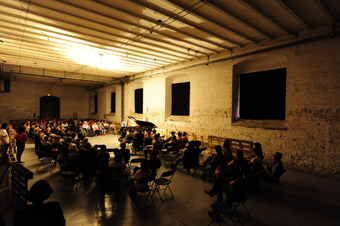
Interior Tabakalera, Centro Internacional de Cultur
photo Ian Penman
Interior Tabakalera, Centro Internacional de Cultur
old building/new space
The old buildings adapted as new artspaces were sometimes proving problematic. On the one hand, their flexibility was lauded for enabling new means for arts production and reception. Their “aura” was seen as “an inspiring influence for artists and audience” and the sheer spatial volume as allowing for ample performance spaces, studios, galleries, bookshops, cafes and restaurants. But some artists found themselves occupying spaces that were variously too big for their intimate work or, in some cases “too perfect, too clean” or simply unaffordable. One centre director commented that the new spaces “fill a gap but open up a new one.”
public/private
All the spaces saw themselves as essentially non-profit but with varying degrees of dependency on commercial activity, often from renting out the building or hosting conferences (a speciality of Radial System V). Professor Mandel pointed out that in a country with very high public subsidies for the arts, like Germany, there was an increasing expectation of reliance on more private funding and commercialisation. In other countries public funding was increasing. She reported that, “None of the spaces is able to exist without public funding; the majority get at least 50% of the budget from public authorities.” The scale of operation of the artspaces varied enormously from management staff of two to 40 and overall staff, at Kampnagel, of 80. Most also worked with freelancers and some volunteers.
the ideals
Although artspace directors were frank about the contradictions they were living out, there was nonetheless a prevailing mood of idealism which saw the centres as laboratories for producing and presenting new interdisciplinary art and moving beyond traditional definitions of low and high art. With flexible and cooperative management, centres were aiming to avoid hierarchical and too institutional structures. Openness, ‘mobile thinking’ and risk-taking were lauded. However, a series of specific challenges were delineated, beyond the double binds already cited.
the challenges
Participants in the forum saw serious challenges to the sustainability of new artspaces in two areas. Ugo Bacchella, President of Fondazione Fitzcarraldo in Torino, Italy was concerned that “although these spaces were being established, national cultural policy doesn’t recognise them.” Secondly, most centres were receiving less public money than traditional arts institutions. Bacchella could “not see governments pushing more money towards these centres,” therefore they needed “to be innovative in all respects, including funding models and should look at environmentalist models, different kinds of sustainability, bottom-up approaches, engaging citizens in new paradigms for funding.” He pessimistically cautioned these innovative centres about becoming obliged to the state. On the other hand, he reported “a big new European focus on education, with a new mantra: society, education and the arts.”
Some saw the pressure to generate considerable income outside of funding as risking conservatism in programming. Dietmar Lupfer of Muffatwerk saw it as “a big challenge for hardcore experimentalism.” Radial System V directors reported their “turnover as 2.7 million euros per year, with income of 60% from renting out spaces and the bar; 40% from production income. Foundation money and subscriptions are very small.” New work does not always attract large audiences in the short term.
time/space; new/other
Lupfer argued that “it’s not about being new, but being other, for both artists and audiences. It’s about time and space: both have been lost in conventional spaces, resulting in bad working conditions. In the new centres there’s the opportunity to work a space where a community can develop with a focus and an audience—an open house for social views. A docking station. In the 1980s the other was music, in the 90s the other was dance, now it’s net activism.” An important element in this is an audience attuned to and living with new media.
Jochen Sandig argued for “mobile thinking” as opposed to the exclusivity of traditonal institutional structures and their “immobile thinking.” He declared that “in reality there’s a mobile audience.” However, central to the sustainability of new centres is the need for sufficient funds to create time for new work and space in which to create it. He described the current situation as political, “when too many euros are spent on institutions and not on development, on operas and orchestras rather than development of new work—which makes this forum political.”
Some speakers argued that the potential of the new artspaces was at an early stage, emphasising the capacity for more varied building use and off-site projects. Sandig pointed to the revival of performance art outside of art galleries. He argued for “developing ideas for ‘outer space’. It’s not enough to be just in your space.” Paul Gazzola, a Berlin-based Australian who works in many cities around the world argued for a nomadic principle, while Mohamed Goenawan declared, “Space is produced when you create work.” Ugo Bacchella iterated that “new spaces should be seen as resource based, not just offering an art product but process, product and discussion versus the old one-dimensional function of the public arts venues.”
Further to the discussion about these artspaces as new, or other or oppositional, the general inclination was to see their primary responsibility as artistic but accommodating, reflecting a belief that the public didn’t want to see the new space as just another intimidating, inflexible institution.
Professor Wolfgang Schneider of the Faculty of Cultural Policy, University of Hildesheim, reinvoked the political dimension. He’s deeply concerned that “currently only 10% of society has access to the arts and yet huge amounts of money go into them.” He sees the new spaces as offering society a meeting point for the arts, flexible infrastructure and potentially clear outcomes like “a larger audience, not just the happy few.” He’d like to see the growth of the new artspaces as an opportunity for the development of a “utopian attitude to the arts, a rediscovery of aesthetics.” He suggested that the European Union’s enthusiasm for science should also be applied to the arts.
At the end of the forum, the outcome was indeterminate in practical terms. But everyone was more informed and the challenges for the new artspaces had been carefully delineated. It was agreed that the spaces would keep in touch with each other; that an approach possibly be made to have an ongoing gathering under the wing of IETM (International Network for Contemporary Performing Arts; see p10); that the exchange of staff could be a means for sustained contact and dialogue; and that opportunities for program networking be explored.
the city & the new artspace
As yet in their early days, the new artspaces represent the creation of revitalised public urban space, at a time when acccessible spaces are fast being diminished or commercialised. They embody new artistic practices, new relationships with audiences, greater accessibility, unconventional managerial and financial models— ‘non-profit entrepreneurial’—and expanded notions of the arts centre as not just a place for presentation but for actual creation and debate—a resource for artists and audiences, a source of creativity for the city. RadialSystem V, its directors Jochen Sandig and Folkert Uhde, and forum coordinator Tina Gadow, with Lisa Stepf, are to be commended for providing a timely opportunity to confirm the ideals of the new artspaces and jointly face common challenges.
postscript: cent quatre, paris
After the forum we visited Cent Quatre (see our cover image) in Paris’ north-eastern suburbs, a huge development in a one time slaughterhouse then mortuary with numerous studio spaces for residencies, two performance venues, an impressive bookstore, restaurant and welcoming cafe, and lots of central open, covered space for installations and events. Apparently aiming to build a sub-culture through its artist in residence programs, the centre cost 100 million to set up and receives eight million euros in funding a year. The suburban location is a culturally complex one, offering challenges for audience development and community relations. Just before our arrival a huge exhibition of artworks by young practitioners had attracted a large audience. We’ll have more on Cent Quatre in RealTime in the near future.
New Spaces and Systems for the Arts, creating connections—connecting creativity, A Forum at RadialSystem V Berlin, Oct 16-17, 2009; as part of Hybrid Arts Fest—Australia, organised by Radialsystem V during the Asia-Pacific Weeks Berlin 2009. In cooperation with the Goethe-Institut and the University of Hildesheim, Institute for Cultural Sciences, Aesthetics and Applied Arts.
Keith Gallasch attended New Spaces and Systems for the Arts with the support of the Goethe-Institut Australia.
RealTime issue #95 Feb-March 2010 pg. 2-4
© Keith Gallasch & Virginia Baxter; for permission to reproduce apply to realtime@realtimearts.net
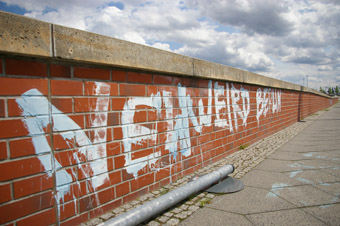
newweirdberlin, Kai Stiehler, 2009
© urban dialogues
newweirdberlin, Kai Stiehler, 2009
AFTER BEING IMMERSED IN RADIALSYSTEM V’S FASCINATING SYMPOSIUM ON THE RELATIONSHIP BETWEEN NEW PUBLIC ARTSPACES AND CITIES, NEW SPACES AND SYSTEMS FOR THE ARTS (P2-4), IT WAS THRILLING TO GET ONTO THE STREETS OF BERLIN TO EXPLORE SOME OF THE ISSUES RAISED FROM OTHER PERSPECTIVES. COURTESY OF A GOETHE-INSTITUT ITINERARY AND AN EXCELLENT GUIDE, OVER TWO DAYS WE MET PEOPLE ACTIVELY ENGAGED IN SHAPING AND CHALLENGING THE CITY’S NOTIONS OF ITSELF. APTLY, BE BERLIN, A GOVERNMENT CAMPAIGN TO ENCOURAGE BERLINERS TO PARTICIPATE IN DEVELOPING A SENSE OF THEIR CITY’S IDENTITY, WAS IN FULL SWING.
Much has been written about the attractions of Berlin, not least its plethora of opera, theatre and dance companies, numerous festivals, including Transmediale and the Berlinale Film Festival, superb museums, countless commercial and independent galleries and clusters of shops with innovative wares (promoted in printed English/German guides in each of the fashionable districts). Large student and artist populations, enjoying cheap rents, have fuelled the evolution of squats into idiosyncratic art, shopping and eating districts with varying degrees of gentrification, development and heritage preservation.
The squats either side of the Wall in the 80s, especially in the former East Berlin, became hubs for intensive creativity into the 90s and beyond, incubating a wave of successive cultural hot spots across the city. We looked out from RadialSystem V across the River Spree at the grafittied old warehouse and factory squats that our hosts said would soon be home to new development. This wave moves slowly, if with determination. Land ownership was, and remains, a hugely problematic issue in the reunification of Berlin—who actually owned what in the former East? An older problem, resolving ownership and compensation for land stolen from German Jews by the Nazi state, persists as well. Several people we spoke to said that ownership challenges had a positive aspect in inhibiting rapid commercial development and keeping rents down. Protests against development are also common—one was taking place as we looked across the river.
The artists we met, not a few of them Australian, live in Berlin because of its cultural density which offers them connections, networks, study, mentoring, collaborations, inspiration and cheap rent, but not necessarily work or grants. Some arrive with grants from their home countries, many work elsewhere in Europe and use Berlin as home.
Already we had a strong sense of Berlin as a creative totality—it’s a place where artists want to be, as do audiences from the city itself and beyond. However, we were constantly reminded that Berlin is seriously broke, that a huge percentage of arts funding goes to a handful of major institutions and performing arts companies and little to a huge population of individual artists and groups. Much of the population cannot afford to enjoy the arts.
Nevertheless the city appears to be in a state of continual renewal. We visited the Neues Museum the day after it opened, a superb work of renovation and preservation housing the creations of ancient and mediaeval cultures. The external walls are pockmarked with bullet holes: inside and out the city’s history remains visible.
Two of our acquaintances are proud Berliners, but believe that the Nazi and Communist destruction of the city’s middle class and Jewish life in the last century meant that Berlin lost the opportunity to establish a consistent, coherent cultural drive, one that could acknowledge the artistic realities and potentials of the city. They look elsewhere—to the emerging cultural life of Istanbul for example—for inspiration.
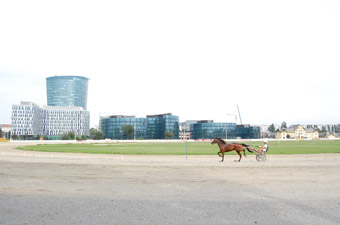
Xenia Rautenberger, 2009
all rights reserved by urban dialogues
Xenia Rautenberger, 2009
urban dialogues
Others worry at the fragmentation of Berlin life. Instead of a coherent city, they see islands—ghettos of isolated citizens divided socially and spatially although living almost side by side. Urban dialogues (www.urbandialogues.de) devises projects that take participants deeper into their own neighborhood and then outside of it—to other parts of the city or some other city elsewhere in the world.
Urban Dialogues began in 1998 with an emphasis on site-specific work involving young people, research based projects and conceptual art work. A team of 11 evolved—eight artists, two urban geographers, one pedagogue. Artistic director Stefan Horn and collaborators constantly reinvent their approach according to the character of the location and the participating group as well as the skills and passions of the artist who will run the project. Photography has become the principal tool for many of the projects, used in myriad ways.
We meet Horn at the Clärchens Ballhaus in Berlin-Mitte, a century old timber dance hall where you can eat and drink, dance at night (as does our guide), enjoy chamber music or a jazz recital. The atmosphere is warmly communal.The amiable Horn briskly engages us with alarming accounts of the borders rising within cities and optimistic arts-led means for breaking them down. He describes himself as “a theatre designer who wanted to get out of black boxes and into urban dialogues outside. So I did a project with choreographers and designers on how to deal with community.”
Urban dialogue projects, explains Horn, are about “difference and communication, youth art and networks. A project might take three years to complete. Urban Dialogues builds teams of freelancers. Young people join workshops, each run by a professional artist. Each project has academics evaluating it from beginning to end with reports at different stages. We’re always looking for different ways to work with young people. Again there’s no recipe.” Horn appoints a local artistic director and “keeps in touch by teleconferencing and lots of visits. In Berlin we have done lots of art and education projects, focused on school or youth groups, choosing artists with the right experience.”
The main function of the projects is to reduce a sense of isolation, to encourage something as apparently simple, but often quite threatening in a big city, as visiting a neighbouring suburb. Young people going from from Brixton to Barcelona were “shocked by small things—the ritual of sitting down to drink coffee instead of taking it away.” The project report emphasises how quickly the young photographers sought out what was distinctive about Barcelona, instead of the familar “we’ve got one of those.”
The 15-month Signs of the City program focused its young participants (variously students, vocational trainees, hearing-impaired, homeless) in Berlin, East London, Sofia (in Bulgaria) and Barcelona on documenting and creatively intepreting cultural signs—state, commercial and personal—points of recognition and recollection. Often it was their first encounter with cameras, from pinhole to digital.
In these projects the artist leaders are not cast as teachers, they provide the means, models and inspiration for participants “to become authors in their own right, directly involved in the production of knowledge.” Significantly this is achieved through collaboration and through visual language, circumventing literacy challenges and allowing communication between different language speakers. These young people “are cut off from the art world as a result of language and segregation.” Artists and assessors reported the invaluable addition of GPS-receivers to the project, allowing the participants to achieve a greater sense of active documentation and facticity beyond taking and selecting images—”conjoining place and time.”
Exhibitions of the photographs were staged in each city, but online collections played a more significant role in allowing participants and others to see the greater range of the projects and to play with the images, assembling them into patterns and narratives to help shape perspectives on where they live (www.citipix.com). Excellent documentation of the project can be found in Stefan Horn, Rudolf Netzelmann, Peter Winkels eds, Signs of the City—Metropolis Speaking, Jovis, Berlin 2009.
Horn elaborated on the range of projects Urban Dialogues had initated or been involved in, incuding Islands+Ghettoes, case studies of Dubai and Caracas. These are “extreme cases of ghettoisation”, he says, “but good exemplars of working in social crisis zones.” He mentions the gated communties of London and Barcelona: “Sometimes the borders within a city are actual but even if metaphorical they’re nonetheless real.” A very real example can be found, he says, in East London where he’s currently working and where the 2012 Olympics will be held. He’s concerned that appropriate urban regeneration will be hindered by the installation of an 11 mile, 10 foot high, blue security wall replete with CCTV that cordons off the Olympics site over many years. The assumption is that the Olympics will regenerate the East End, but Horn is concerned it will set up new borders given its long-term presence and the possibility of permanenly dividing communities.
Horn thinks that “urban regeneration can work but there’s no recipe for it. It should develop at the same speed as the lives that inhabit it. People need a chance to cope, to develop a life in their city.” As for Berlin, despite its steady cultural development of parts of the city, Horn sees it as an island with ghettoes—”an island needing culture and tourism” to keep it alive. He writes in Signs of the City, “Berlin: a city that could, and had to, re-invent itself after the Fall of the Berlin Wall in 1989. Sometimes resembling a peaceful urban island…[it faces] the challenge of integrating two different social and value systems.”
In the book documenting Islands+Ghettos (Verlag fur moderne kunst Nurnburg, Heidfeberger Kunstverein, 2008), Horn writes “that the spatial fragmentation of urban space…will increase in the future.” Concerned about “territorial delimitations and their effects on young people”, he argues that “perception must be schooled and the gaze sharpened for the things that surround us everyday that, all too often, we no longer really recognise, because we are accustomed to them.” As several observers of Signs of the City point out, this is a quest to develop ‘urban literacy’ and a slowed down, considered response to city life. For a freelance writer, Andrew McIllroy, reflecting on the project, Signs of the City is possibly about “emergent citizenship” and “the city as a place with soul.”
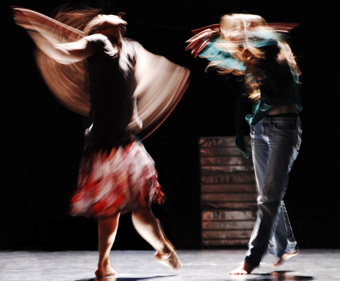
ina Wollny, Lea Draeger, Trust, Schaubühne Am Lehniner Platz
photo Heiko Schäfer
ina Wollny, Lea Draeger, Trust, Schaubühne Am Lehniner Platz
schaubühne am lehniner platz
Tobias Veit (Director Artistic Production) and Friederike Heller (Dramaturg) spoke frankly with us about the Schaubühne’s place in the city as the only major theatre company in the former West Berlin. It has been a challenge, they said, to get audiences to cross town. As well, this once wealthy district of the city, Charlottenberg, has become progressively poorer. Against these odds the Schaubühne has sustained progressive direction and programming, establishing itself as European and an international player.
The Schaubühne makes itself “internationally visible” with productions with English surtitles, by translating plays, by including in the program dance theatre which, Veit and Heller say, can draw a very different audience and build the contemporary profile the company is looking for—”to give way to diversity, rather than be overwhelmed by it.” Some productions draw particularly large audiences, like artistic director Thomas Ostermeier’s production of Shakespeare’s A Midsummer Night’s Dream performed as a party in a garden, but there’s a need to reach out beyond Berlin’s constraints.
The Schaubühne is part of Prospero, a partnership networked across six European cities. Veit says that “the works from each of these companies are very local in origin. Each year four mutually agreed on productions are shared. There are 10-12 other productions from which each chooses two. The challenge is to take into account your own audience and decide what they’ll like.” The organisations also meet, this year in Tampere and in 2012 in Leige, for a colloquium—”talking, dealing with four languages, developing co-existence, growing together.”
Veit pointed out that the partners are six completely different organisations: “The Modena company in Italy (Fondation Emilia Romano Teatro) is an autumn festival with no theatre of its own but produces tourable works. The one in Lisboa, Portugal (Fundaco Centro Cultural de Belem) is a cultural centre that presents a variety of forms. The Finnish Department for Theatre Research and Practice co-operates with the Tampere Festival. None is doing the kind of work that Ostermeier does. But there is a shared interest between organisations in certain directors.”
Another international dimension to the Schaubühne is to be found in its International Playwrighting Festival on Identity and History and FIND, its International Festival of New Drama focusing on and promoting lesser-known writers from around the world. The festivals involve “very fast programming—one year ahead—invited productions, staged readings, fundraising, support gained from political leadership, the Goethe-Institut and educational organisations, and programs are printed in German and English.”
The Schaubühne ethos is built on Thomas Ostermeir’s notion that culture comes from the contemporary author. The company has been producing Falk Richter’s work for 10 years as well as the plays of Marius Von Mayenberg [whose plays have been directed by Australian Benedict Andrews, a regular at The Schaubühne] alongside works by British playwrights Sarah Kane and Mark Ravenhill. Choreographer Anouk van Dijk has been working with the company since 2000.
When Berlin’s other theatres followed the Schaubühne’s focus on authors, “it became overfished territory,’ said Veit. “Too many young writers in Berlin were expected to come up with a string of world premieres.” It was decided at the Schaubühne, among other things, to include dance in the program and to make an innovative shift by working with Van Dijk and Richter on the production TRUST, broadening the companys’ ambit.
Despite the language barrier (we had brief access to a rough draft translation), TRUST proved to be an engrossing experience shared with a large responsive audience. We’re familiar with dance theatre, but TRUST is like an inversion—theatre dance—in which the text is centre-stage but is danced and inventively moved to varying degrees. As an elliptical drama about an ageing relationship, infidelities, cross-cultural encounters, the global financial collapse and the draining pressures of digital social networking the tone of TRUST ranges from hyperreal to fantastical. While being lifted high and swung, characters continue to communicate normally. Or they are rendered puppet-like. A man performs a neurotic little dance in an armchair, not knowing what to do with himself as a woman speaks on and on. Monologuish interrogations of self or other multiply: “Have you actually ever thought about your body, what it tells you, the story of your body…the story your body tells me every morning?” A funny therapy class that offers release through barking turns nasty. Bodies clump together or are tossed behind a couch or are disappeared by a box. Speakers lose limb mobility as they rattle on. And all the while there’s the growing sense that personal or couple collapse is just part of some greater, surreal if mundane disaster. The performers, a mix of actors and dancers, commit to Richter’s lateral text and van Dijk’s movement (the show is co-directed by writer and choreographer) with passion and precision on the multi-level set to a live sound score. We’re hoping TRUST will hit the festival circuit with surtitles so that we can share our excitement in this theatre-dance innovation.
Meanwhile, on the financial side, “75-80% of the Schaubühne’s budget comes from the city while the other four major theatres receive up to 85%.” The five theatres are competitive but, says Veit, “there’s no serious debate or will to cut funding.” Similarly, despite the financial odds, Berlin still has three opera companies as well as the most theatre companies of any German city. With 230-250 personnel involved in the Schaubühne at any one time, “we might do 500 performances a year, 60-100 will be outside Germany, few within. Touring is very important to us.”
The Schaubühne reflects the changing social dynamics and fortunes of Berlin, adapting by finding new forms and audiences within the city and outside the country. Theatre companies around the world are diversifying their programs, embracing contemporary dance and performance, in some ways keeping pace with new multi-functional artspaces like RadialSystem V.
adrienne goehler
Author, curator and sometime politician, the dynamic Adrienne Goehler describes Berlin as being full of “people searching for euros because we’re an experimental city reinventing ourselves after the fall of the Wall.” For 12 years Goehler headed the academy of fine arts (Hochschule für bildendeKünste) in Hamburg. In 2002-2006 she was curator for the Hauptstadt Kulturfonds (cultural capital funds) of Berlin and wrote a book, Liquefaction, Ways and byways of the welfare society, culture (Campus, Frankfurt, New York 2006). For seven months she was Cultural Minister for the City of Berlin
A passionate arts advocate with a radical social justice agenda, Goehler has ambitions for Berlin. She’d like there to be more free creative spaces; for her city to more conscious of the importance of the arts for its own future; and a basic income for all citizens, working or not, “given that there will be no longer a return to full employment in Germany.”
Goehler describes the recent Jugend Forum with Parliament: 1,000 young people discussing the city’s creative crisis. “It included a range of artists—film, dance, cyber—addressing everything: alcohol, political correctness, poor kids, dating protocols, modern Nazis who are dangerously subtle and wear suits…The city is still bankrupt but recognises that it needs to open itself to new practices. But it’s too busy commercialising art and not understanding the conditions of creativity and without a clue about the pioneering work that has been done. The result is more and more a shopping window culture with a mayor who adopts the cultural ministry to create a culture to mirror himself and ignores the grassroots.”
Goehler spoke about how hard life was in the city for most artists, while at the top end the arts were well funded. She’s convinced there’s “a need for capital to provide a laboratory to discover new kinds of labour and art. But the city’s departments of economy and arts are totally separate.” This, she says, was what hindered her in her seven months as cultural minister: “In blinkered divisions people limit their responsibilities, whereas one of the big potential energies in Berlin is in-between-ism, between the arts, between sectors—especially in education. You need arts and artists in schools. I want dance in school during the daytime, not after 5pm. One of the best things that Simon Rattle did when he took up the job as Chief Conductor of the Berlin Philharmonic was to demand music education in schools as part of his appointment. It’s taken three and a half years before the Departments of Education and Culture began to share euros and responsibility.”
Goehler said that when she headed the cultural capital fund “the government didn’t like my approach because it looked ‘social’ whereas I said, ‘it’s urban, ideological, educational.’” She drolly described her experience as arts minister as “my little workshop.” She was fired. “I’d won too many battles. I’m opposed to functionalising art for politics.”
As for her work now, she describes it as “a wild, intense precarious, independent life curating and writing. I’m fighting for a basic guaranteed income for all, an idea feared by all political parties. In the 21st century we need different ideas and creativity to overcome ecological and other problems. Therefore we need artists and scientists and we mustn’t let them starve. This includes non-university scientists and artists. Art has been built on the self-exploitation of people in their early 20s and the current means of securing money is humiliating.”
Goehler is involved in organising an exhibition on aesthetics and sustainability, bringing together inventors, artists and scientists. Behind the show there’s an aim, to set up a fund to connect the arts and sciences, “not a foundation—foundations are also sector-bound, and artists too need to see beyond their sector.”
At a time when art is expected to be educational, therapeutic, an industry, a service, Goehler’s position is a significant one. She places art firmly in a socio-political context, as having a role in improving the city, but on its own terms and for which artists should be duly rewarded. “[Creativity] is flexible, liquid, not a reserve, not a commodity, but a current.” As she said in a speech delivered in Sydney several years ago, of a city with the highest density of independent artists in Germany. “Berlin…has all the pre-requisites to perceive itself as a laboratory for trying out arts and knowledge related jobs.”
be berlin
Berlin’s government is also having thoughts about the city’s identity, clearly hoping to consolidate among its citizenry a positive view of the metropolis. The Mayor has backed and visibly fronted a public relations campaign. Christophe Lang Head of Corporate Communications/PR Be Berlin, says “it is designed to make Berliners aware of their own city, to overcome a certain critical and sceptical frame of mind. The best Berliners would ever say about Berlin was ‘you can’t complain.’” After the Wall came down, Lang says there was “a lot of change and a sense of loss but an improved attitude after 2006 when Germany was the World Cup host.”
Be Berlin commenced in 2008 “with a five million euros budget, and an aim to enhance trade for Berlin-based companies and marketing of the city, but not for tourism. It involves 168 companies—advertisers, publishers and management agencies. The central idea is a new branding of Berlin as the place to be: ‘Become a part of a city of change, and be changed by Berlin.’”
The campaign’s emphasis has been “on finding the uniqueness of Berlin. It’s already seen as unique, especially by the young but it was not clear what this uniqueness stood for. A logo was developed and posted all over the place. We sent letters to 1.4 million households, invitations ‘to tell your story—about your successes.’ We got thousands of responses from which 500-600 stories were chosen covering 2,500 people. We didn’t use celebrities or professionals, just average Berliners. If your story was accepted it was projected onto the Brandenburg Gate and you’d become a Berlin Ambassador with a special award and your story included on the website for Be Berlin.”
Each story was headed by a slogan variation: “Be volleyball/Be winner/ Be Berlin”; “Be upright/ Be garden saver/ Be Berlin.” The stories, in the areas of art, business, science, city life, are about personal successes large and small (www.be.berlin.de/en/stories).
Lang says that there’s a strong focus on youth, on green energy and cultural events and that polling has revealed a high approval rate for the campaign which is now extending to international events and trade fairs overseas. The key ‘descriptors’ of Berlin that appear to have emerged from the campaign suggest that the city is energetic and cutting-edge, has unparalleled diversity, attracts people from all over the world and has friendly citizens “with big hearts and big mouths.” There’s also a Berlin Friendliness Initiative designed to show visitors Berliners are helpful and good humoured. The Be Berlin logo is attached to arts, fashion, design, science and business products and events wherever there’s a will to be involved. Not surprisingly, artists we spoke to are less than impressed, thinking that the money spent on Be Berlin might be better invested in creating a future for the city rather than an attitude.
monopol
We enjoy a brief meeting with Elke Buhr, the assistant editor of the millionaire-owned Monopol. With its staff of 10—five writers, two art directors, two picture editors, two production people—the magazine initially focused on lifestyle, art and fashion, but “discovered that lifestyle readers are not so interested in art.” So the focus became visual arts in a city with reputedly the largest number of galleries in Europe per head of population and heavily involved in the continuing boom in the commercial art market: “We need the visual arts public.”
Buhr describes the magazine as “Berlin-centred while being international.” Mrs Taschen, partner in the idioyncratic Taschen publishing company, “does a double-page column each edition focusing on a different city.” Atypically two recent issues cover performance art, with a lead story on Rose Lee Goldberg’s Performa live art festival in New York. Initially the coverage was to be in one edition but was spread over two “to avoid an impression of ‘harshness.’” Media arts only occasionally make it on to the pages of Monopol whose strength lies in responding to a Berlin and European niche readership committed to progressive visual arts.
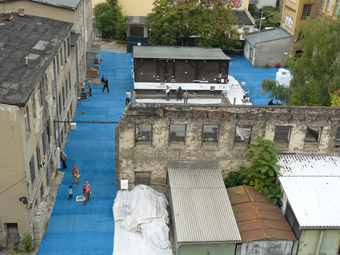
Rigaer Street 71-73A
photo Anja Leu
Rigaer Street 71-73A
fabrik (im) quadrat
Our last meeting was in Friedrichshain with The Association for Urban Spaces and the Creative Industries involving young artists directly engaged in preserving and regenerating a part of the city. Behind a tired, old wall topped with ragged barbed wire there’s a courtyard in which stands a large timber shed (apparently long ago it housed cows) and to its right a low bunker-like stone building. Towering above is an elderly, neat apartment building, once a 19th-century factory, with a shared cafe space on the ground floor in which plans are on display to convert the site in part into a cultural centre.
The shed is adorned with photographs, charts, maps and information cards, suspended light globes and an occasional ‘peep’ box. As we walk around the shed a 140 year history of the building unfolds, its industrial uses, including as a furniture factory in the 30s, changing ownership, the ‘missing’ years (blank wall space) of Nazi domination, the stealing of the property and the murder of the Jewish owners, the merchants Mechel and Simon Beiser….and on to more recent times. The display has an archaeological aura—photographs of layers of brick, a peephole glimpse of wall surfaces—and an air of mystery—swinging globes and a query about what precisely Osram were up to here with their wartime armaments research. It’s an engrossing site-specific installation, even on a chilly day. We’ve arrived just after the exhibition closed and see only traces of the bright blue ‘carpet’ that filled the spaces between buildings, unifying Rigaer Street 71-73A into a single concept—a workplace of the past, a living space in the present and an active cultural hub for the future.
This project at Fabrik [im] Quadrat (literally, the factory in the square) is described as “an intervention with light boxes, future-plans and historical speculations; yard-exhibition,” and was shown throughout October. An initiative of the local community (residents, artists, associations) who came together in 2008 under the leadership of Stadtraumnutzung e.V. to contest the sale and demolition of the historical property, the project gained the support of other organisations including the Cottbus Technical University.
In the ‘bunker’ there is a club gallery named Antje Øklesund, which contains a range of other peephole works including a small self-contained 50s loungeroom in which, swathed in retro-glow, you can sit as others spy on you. The venue is also used for progressive music performances at night and has a cozy bar and a variety of small rooms, one of which features a huge mound of trolley wheels (another layer of the site’s history) on which are mounted flickering video monitors. Outside, in the ruins, there are remnants of a sound art installation—small speakers on walls and in cracked wash basins. At the edge of the property a mechanic happily restores old GDR Trabant cars.
The three young artists and organizers of Antje Øklesund, Hajo Toppius, Thomas Redekop and Sascha Schneider, who guide us around the site are committed to preserving and simultaneously transforming it, collaborating with the community of heirs spread all over the world. Although they admit it will be a challenge given unresolved ownership and city politics, their determination is evident. (For more information & pictures see www.stadtraumnutzung.de)
berlin: i.d.
Strangers to Berlin, and on a short visit, we quickly absorbed a range of opinions as to the character of this city. We certainly sensed and experienced its diversity and vitality and were left in no doubt that here was a city busily re-inventing itself, despite its financial debt. But while the city saw itself as friendly, creative and internationally attractive, and was shoring up that opinion with its Be Berlin campaign, it was also described as an island with more connections to the greater world than with Germany, but also with islands and ghettos within of citizens separated by geography and wealth and inequitable degrees of access to the arts. Activists, theorists and artists seek a balance between preservation, regeneration and the new, seeing the city as a laboratory for producing new forms of art and knowledge. In the opinion of Adrienne Goehler, Berlin already is that laboratory, but it has to acknowledge it and, to make the most of it, invest.
Our thanks to Klaus Krischok Director of the Goethe-Institut Australia for proposing the visit, to Timm Klöpper of the Goethe-Institut Berlin for organising our itinerary and special thanks to our excellent guide Monika Böttcher for her companionship and for generously sharing her considerable knowedge of the city.
RealTime issue #95 Feb-March 2010 pg. 5,6,8
© Keith Gallasch & Virginia Baxter; for permission to reproduce apply to realtime@realtimearts.net
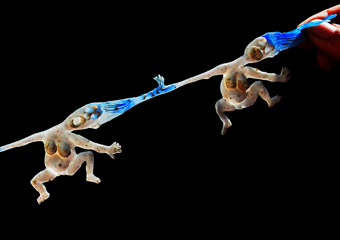
Mrs Strangled and Mr Shot, Psilicone Theatre
photos courtesy of the artists
Mrs Strangled and Mr Shot, Psilicone Theatre
VILNIUS: EUROPEAN CAPITAL OF CULTURE 2009. VILNIUS: THE CAPITAL OF LITHUANIA. LITHUANIA: INDEPENDENT SINCE 1990. RIDING THROUGH THE STREETS CHECKING OUT THE SOVIET MODERNIST AND CONTEMPORARY ARCHITECTURES WITH MEDIA ARTIST AND RACONTEUR GEDIMINAS URBONAS WAS A GREAT INTRODUCTION TO THE LAYERS OF HISTORY IN THIS CITY.
Lost Vilnius Through the Window of a Trolleybus introduced us to brutalist concrete buildings, to timber summer houses from another era, to the KGB prison-now-museum and the soon to be demolished historic Lietuva cinema—one of many buildings lost to the growing property market. Exposing us to the redevelopment of many culturally significant buildings brought about by the privatisation of public spaces, the trip critically charted the remapping of the city since the Soviets left in 1990.
An ‘artistic trip’ developed for the participants of the IETM Autumn Plenary Meeting in October last year, this experience was a fitting introduction to the contradictions raised by two decades of integration of East and West Europe—the broad theme of the meeting.
We return to the cobblestone streets and baroque architecture of the old city, wet with the rain that’s apparently typical. Our colleagues explain that the etymology of Lithuania (or as the locals say, “Lietuva”) derives from “lietus”—rain. The inside-out yellow umbrella logo of the event we’re attending suddenly makes sense.
Six Australian delegates attend the IETM meeting in Vilnius. Formally known as the Informal European Theatre Meeting, in recent years this 30-year-old network is reaching out to include other parts of the world. Renamed IETM: International Network for Contemporary Performing Arts, it’s a membership-based organisation with more than 400 members in 45 countries. It holds two plenary meetings per year, hosted by different cities and attended by an eclectic network of artists, producers, presenters and academics.
The Australia Council is an Associate Member of the IETM, and has been sending delegations of Australian producers and artists to their meetings since 2008. A partnership between the two organisations has now been formalised with the appointment of David Pledger (director of Melbourne’s not yet its difficult) as Project Director, IETM-Australia Council for the Arts Collaboration Project. Based at the IETM office in Brussels, Pledger describes his work as, “developing more opportunities for Australian artists to work internationally…and taking an active role in larger discussions which support more international artists working and performing within the EU.” One of his first tasks was to attend the IETM Plenary in Vilnius along with John Baylis (Performing Lines), Michelle Kotevski (Urban Theatre Projects), Lockie McDonald (Fullsky), Kate Neylon (pvi collective) and myself.
The IETM plenaries are about professional connection and exchange. ‘Pitching’ is fiercely discouraged; IETM is vehemently not an arts market. The panels and discussions typically address artform development, models of making and presentation, and sharing knowledge and strategies across borders. The performance program introduces delegates to some local work. And the informal moments are about developing relationships, brokering international collaborations and partnerships, sharing anecdotes and, in Vilnius, quite a lot of vodka.
The plenary was hosted by Menu Spaustuve, a performing arts centre located in a recently refurbished printing house in the middle of the old city—so recently they were still finishing the wiring and painting the day before the plenary opened. I arrived early to encounter great excitement—“The heating has arrived!” With its range of multi-use spaces, black box theatre and outdoor marquee, Menu Spaustuve was a great location for the events and for hosting the various constellations of people emerging in intense discussion.
The plenary focused on the shift in relationships between Eastern and Western Europe over the last two decades—examining promises and expectations from both sides—and the emergence of new colonisations. The impact of more fluid contact since the wall/curtain came down was a major area of discussion, proving to be full of contradictions and questions. Have the geographic and ideological been replaced with economic differences? How can resources be shared more equally across borders? Have Western markets ‘lost interest’ in the East? Why?
Nele Hertling, the founding director of Berlin’s Hebbel Theatre observed that while there are a handful of Eastern directors who’ve become ‘shooting stars’ in the Western European theatre festival circuit, presenters, press and audiences have generally shown disdain for the ‘folkloric’, ‘old fashioned’ work emerging from the East. She maintains the West’s interest in the East was stronger during the Cold War: “… whenever artistic work from behind the Wall was presented, one could be sure of interested audiences and press attendance. Maybe the interest was not so much in the artistic, but in the ‘subversive’ quality…When this was gone, the dream of artists—having an easy and open dialogue with new Western audiences—was cruelly damaged. Without that subversive quality the audience lost interest.”
Maciej Nowalk, Director of the Polish Theater Institute, maintained that although “we became much more open about new ideas and possibilities…the iron curtain still exists…with all of the money and power coming from the West…The UK has most of Poland’s plumbers and our artists too because they can earn more there…and Polish artists who stay ‘give in’ to the West by creating work that caters to the ‘old world’ curiosity.” Explaining that this drain of artists and ideas to the West has not been replaced with an influx of collaborations with western artists, he finishes simply “The exchange is uneven.”
As an outsider to the East/West European experience, these (and many other) insights were useful to decode and contextualise some of the artform discussions and performance work on offer.
Staged concurrently was the International Theatre Festival Sirenos, which, along with the Lithuanian Dance Information Centre offered delegates the opportunity to see performances with local audiences. With little knowledge of the artists and companies in the program, many delegates took a series of blind punts on shows we booked before arriving. And like any festival some of the works were great and others were not. Collectively though, they represented a strong survey of Lithuania’s rich theatre tradition (including works by internationally renowned directors Oskaras Korsunovas and RimasTuminas), its relatively young contemporary dance practice (for the five Soviet decades only classical ballet and folk dance received state support) and a new generation of hybrid collaborations.
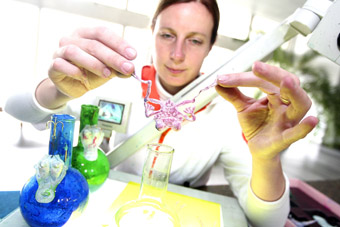
Aukse Petruliene, Mrs Strangled and Mr Shot, Psilicone Theatre
courtesy the artist
Aukse Petruliene, Mrs Strangled and Mr Shot, Psilicone Theatre
My highlight was the modest but distinctive DIY show Mrs Strangled and Mr Shot made by young performance company Psilikono Teatras, a collaboration between visual artist Aukse Petruliene and musician Tomas Dobrovolskis. Petruliene animates a series of hand-made miniature silicone puppets and props on a worktable in front of the audience. Projected onto a large screen, these constantly mutating images create a compelling world of grotesque desire and intrigue. Building atmosphere and narrative, Dobrovolskis’ one-man orchestra provides the live soundtrack. Together, the two depict a story loosely based on documentary material from a scandalous pre-war murder case reinterpreted into a mythological exploration of hunger and desire.
As both technicians and performers, the collaborators play with their hand-made materials/instruments and the live pacing of the storytelling with enormous pleasure, creating an engrossing experience for the audience. Watching these artists, I’m sure they’re part of a new generation doing what they love to do, without needing to second guess what the West might want.
Three days of lively discussion, performances and meeting new and old friends and colleagues made the IETM Autumn Plenary a fantastic, albeit whirlwind, experience. For an Australian it was a window on another world, where the idea of East/West has a different set of co-ordinates, cultural meanings and lived experiences. Being my first time in Lithuania and at an IETM, I was glad to have gone a couple of days early to see the extraordinary Urban Stories: The X Baltic Triennial of International Art at the Contemporary Arts Centre and to visit the new National Gallery and the KGB Museum. It helped me understand where I was and to physically and culturally acclimatise to (some of) the differences.
As many delegates reiterated in different ways throughout the meeting, cooperation and partnership need continuity to thrive. While this is true of the relationships between East and West in Europe, it’s also true of Australia’s involvement in this international arena. So here’s hoping future Australian delegates take up the opportunity to attend IETM Meetings and take the time to broker new networks and collaborations over the next decade—in both Europes.
IETM (International Network for Contemporary Performing Arts) Autumn Plenary, Vilnius, Lithuania, Oct 8-11, 2009, www.ietm.org
The Australia Council has negotiated a special flat rate of 295 Euros for Australian artists and arts organisations interested in joining the IETM. The council supports an Australian presence at the 2010 IETM Spring (April 15-18) and Autumn (October/November) plenary meetings. David Pledger, Project Director, IETM-Australia Council for the Arts Collaboration Project, is based at IETM’s head office in Brussels (david.pledger@ietm.org).
RealTime issue #95 Feb-March 2010 pg. 10
© Fiona Winning; for permission to reproduce apply to realtime@realtimearts.net
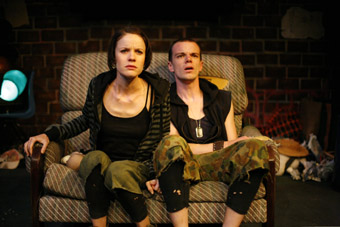
Elizabeth Haslam, James O’Connell, Hoods, Street Theatre/NORPA
photo Lorna Sim
Elizabeth Haslam, James O’Connell, Hoods, Street Theatre/NORPA
FESTIVALS, ESPECIALLY THOSE IN THEIR INFANCY, AND MAJOR EVENTS LIKE ANNIVERSARIES CAN LEAVE PROFOUND LEGACIES: THIS IS THE OFTEN UNDER-VALUED POWER OF EPHEMERAL ART. ANTHONY STEEL’S NEW MEMOIR, PAINFUL IN DAILY DOSES (WAKEFIELD PRESS, ADELAIDE, 2009) CANDIDLY DESCRIBES HIS QUEENSLAND EXPO PROGRAM AS A BOX-OFFICE UNDER-ACHIEVER, YET POINTS OUT THAT IT WAS THE STIMULUS FOR A HUGE EXPANSION OF CULTURAL ACTIVITY THAT HAS SINCE DEVELOPED IN BRISBANE.
The other side of that major event coin is the sad tale told by a young theatre-maker from Porto: she claimed that her city’s year as European Capital of Culture had all but destroyed local arts and many young artists, herself included, had found it necessary to leave. Resources had all been corralled for that year’s boost and left little for ongoing activity in the years to follow.
As Gavin Findlay has suggested (RT 93, RT94), the National Festival of Australian Theatre and the Festival of Contemporary Arts both served as timely platforms for Canberra artists. Given their subsequent demise, we have to assume that neither event was given long enough to put down strong roots. The former had been Anthony’s brainchild and he gave it a point of difference by embracing one genre, liberally and laterally interpreted. Had the faith been maintained, the national capital would now be host not only to a much needed annual theatre conference, but also to one of the greatest gatherings of performing arts professionals in the world. The Australian Performing Arts Market began under my watch in Canberra and when the festival was canceled a couple of years later, the market followed me to Adelaide and has continued to flourish there. Such is the fate of short-term thinking.
Nevertheless, my take on Canberra at present is a positive one. While I was shocked to realise a couple of years ago that there had been a dramatic reduction in the number of professional companies resident there, all of whom I had invited in to the festival, what I now see is new energy and a burgeoning renaissance. The celebration of the Canberra Centenary in 2013 offers yet another timely opportunity to nurture and encourage that movement.
The Centenary program will be cultural in the broadest sense and will showcase Canberra as an incubator, rather than reinforce the misconception of it as a passive host to national government and collections. Science, sport, political and environmental concerns, the slow food movement etc, all deserve to be celebrated next to, and in collaboration with, the major cultural foci of design, architecture, city-planning, writing, film and sound, music, visual and performing arts, and all of this against the unique local, regional, national and international landscape of Canberra.
In 2011 we hope to announce a major hypothetical design exercise which will not only engage with fresh ideas nationwide about urban planning and city-scaping, but also ensure that the thinking that went into designing a new capital 100 years ago is brought into the present. It will highlight new concerns for building, environmental sustainability and their challenges to design as pure creativity.
In that unique mix of centenary programming sits a once-in-a-century opportunity to support local arts practice for the long term. Gavin is right to point out the dearth of arts training and a decline in resources for dance: they are things which need attention. But the first signs will come surprisingly soon. Flipart is a new addition to the Canberra Festival and will not only bring Stalker, Dislocate, Zimboyz and others for free street performances, but also ensure that visiting artists offer workshops. It will provide platforms for local artists such as Janine Ayres’ Aerial Dance and Warehouse Circus. With new initiatives this year, the period around Canberra Day (March 12th) is starting to gather the kind of critical mass which might soon be shaped into a festival of note in the ACT. One endearing aspect is a reminder that despite its national and international significance, Canberra is also a regional city: sheep-dog trials are still included in the program.
Other festivals with continuing grunt in the ACT include the Canberra International Music Festival, the National Folk Festival and the Canberra International Film Festival (a great 2009 program by Simon Weaving).
In the context of year-round activity, the Street Theatre can’t be underestimated. Caroline Stacey is providing exactly the kind of support emerging artists need and has created a process for local artists who are invited in, and mentored, to make their work. Aerial Dance’s The House that Jack Built was a standout, but new music theatre, poetry, music drama and a rap show produced by a couple of high school students were also part of Made in Canberra.This is an emerging artist program the Centenary will be keen to nurture. At the same time, Canberra Youth Theatre offers residencies to young artists, Min Mae is indeed leading the charge in live art, Jigsaw and QL2 still produce, CMAG and Craft ACT are devoted to local work, and barely a breath away the Q Theatre in Queanbeyan has a lively program.
If you add the outstanding exhibitions and public programs of our national collecting institutions housed there, and the speaker programs of ANU and Canberra University, their art, music and design schools, to say nothing of the programs of 100 diplomatic missions, there’s never a dull moment in the national capital. The brainfood is in staggering quantities and can feed myriad creativity.
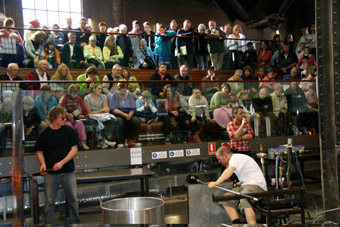
Hotshop, Canberra Glassworks
The current Chief Minister, Jon Stanhope is also Arts Minister and a genuine supporter of the arts. His personal commitment to the excellent Glassworks, a new arts centre in Belconnen, and public artworks all over the city is testament to this. He is also a passionate supporter of the new International Arboretum, rising like a Phoenix from the burnt-out hillsides—100 forests of 100 trees and 100 gardens. All these initiatives offer platforms to a wide range of artists.
Stanhope’s endorsement of widespread reviews is an acknowledgment that this is a time for change. I don’t share Gavin’s view that this will mean just more bureaucracy. He may be right that some energies are, understandably, exhausted. But there are new ones a-foot and a-wing, especially for those keen to roll up their sleeves and work for the renaissance.
My mantra is seed now, flower in 2013, blossom for another 100 years. Canberra is not in-your-face like Sydney and Melbourne. Despite the myth of monumentalism, it’s a shy city, like its twin, the ancient Japanese capital of Nara, and that’s why I like it. Seek and ye shall find. I hope that those who cherish Canberra’s past, as Gavin Findlay clearly does, will have a happier song to sing of its future in a few years’ time.
The first two parts of our survey of the recent history of performance in Canberra were by Gavin Findlay (RT93; RT94)
RealTime issue #95 Feb-March 2010 pg. 12
© Robyn Archer; for permission to reproduce apply to realtime@realtimearts.net
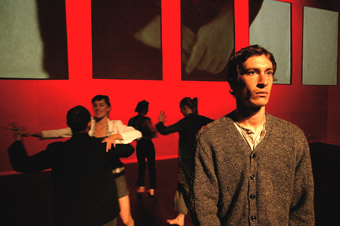
Lee Serle (foreground), I Want to Dance Better at Parties, Chunky Move
photo Igor Sapina
Lee Serle (foreground), I Want to Dance Better at Parties, Chunky Move
IT IS EASIER FOR AN AUSTRALIAN CONTEMPORARY DANCE COMPANY TO TOUR INTERNATIONALLY THAN IT IS TO VISIT A REGIONAL VENUE. THIS APPEARED TO BE THE CONSENSUS WITHIN THE SMALL TO MEDIUM DANCE SECTOR WHICH PROMISED TO TAKE THIS ARTICLE INTO GLOOMY TERRITORY. I CAN REPORT HOWEVER THAT A NEW PERFORMING ARTS TOURING SCHEME IS OPENING UP THE REGIONS TO AUSTRALIAN CONTEMPORARY DANCE COMPANIES.
Before researching this article I shared the opinion, derived from reports of international success from companies such as Melbourne’s Chunky Move and Adelaide’s Australian Dance Theatre (ADT), that there was a hungry international market for Australian contemporary dance due to the high production values, markedly physical style of the work and strong stamp of the sophisticated choreographers running the major middle-scale companies. Looking at the touring schedules of four companies with significant international touring in the last two or three years, it was immediately evident how little national touring accompanied their overseas success.
Set to explore the issues underpinning this imbalance, I spoke to the producers of these companies and was surprised in a couple of cases to find that large and significant Australian tours are planned for 2010 and 2011. Kate Champion’s Force Majeure is the first company to embark upon a national tour through the new Australia Council funded Roadwork network. This network administered by Performing Lines in Sydney consists of a self-selecting group of 18 regional theatres and the regional touring network, Country Arts SA. Roadwork is an extension of the successful Mobile States network model (also administered by Performing Lines and subsidised by Australia Council) which supports smaller scale work.
Roadwork seeks to support adventurous middle scale dance and theatre which is suitable for regional touring. The presenters meet to select productions from dance and theatre which can benefit from marketing and audience development activity. Created in response to feedback articulated by both presenters and producers about the obstacles to presenting dance, the program has been tailored to meet immediate needs. Force Majeure will tour The Age I’m In, the production which premiered to great acclaim at Sydney Festival in 2008. For the company the opportunity to present the work across such a large range of venues is an exciting extension of its aim to create accessible work which has a strong relevance to Australian audiences. Champion plans to accompany the performances with workshops and talks to create opportunities for regional audiences to come into contact with the artists and the work.
Also, heading out on a Roadwork tour, this time in 2011, is Lucy Guerin Inc’s Untrained, the production which premiered at Melbourne’s Dance Massive festival in 2009 and which will tour to Adelaide Festival, Hong Kong Arts Festival and regional Victorian venues—Kingston Arts Centre, Geelong Performing Arts Centre, Colac Otway Performing Arts Cultural Centre, Frankston Arts Centre and Dandenong’s Castle Theatre in 2010. For Guerin, the nature of this production, which pitches two trained performers alongside two untrained individuals in a series of tasks which are both humorous and touching, has been the breakthrough required to reach broad Australian audiences. In 2011, the show will tour to 16 venues over nine weeks, with workshops for two untrained locals creating the show with the two touring professionals and Lucy Guerin. The work will literally transform with each local iteration.
For both Guerin and Champion, these new opportunities to present their work outside of their home bases in Melbourne and Sydney respectively are unprecedented. Prior to this tour Guerin’s producer, Michaela Coventry, told me that there were ongoing relationships with Brisbane’s Powerhouse, Sydney Opera House and PICA in Perth, but that it remains difficult to build an audience and demand for the work outside of a festival context. Only in Melbourne has the company succeeded in securing a long-term presenting partnership with Malthouse which has consistently presented the company and will partner Lucy Guerin Inc in an Interconnections commission of a new work in 2010.
In 2009 Lucy Guerin Inc toured Corridor, Love Me and Structure and Sadness to three US venues and six European venues. Untrained was presented at Sydney Opera House for the successful Springdance program but there were no further Australian presentations. In 2008 the company presented at Sydney and Perth festivals and in 2007 there was a Mobile States tour of Love Me which reached all five venues in that network. International touring in 2007 reached Korea, China, the US and Singapore.
Force Majeure has mainly presented work in Australia in the festival context and has begun to explore international opportunities for presentation on the back of its successful inclusion in Lyon’s Biennale de la Danse in 2006. In 2009 The Age I’m In toured to prestigious festivals in Ireland, Korea and Canada. For real international profile however Chunky Move and ADT have been redefining the parameters of success.
In 2009 Chunky Move toured more or less non-stop from March till December, with Glow, Mortal Engine, Two Faced Bastard and I Want to Dance Better at Parties. Fourteen venues in the US, UK and Europe presented this Melbourne-based company. Glow, the technologically driven solo created by artistic director Gideon Obarzanek in 2006 has become the company’s international calling card, with huge demand for the work appearing unabated into 2010. Executive Producer Rachael Azzopardi explained how this international dynamic was not mirrored in Australia. While Chunky Move has presented work annually in Sydney, Geelong and Canberra and has seasons in Sydney and Canberra planned for 2010, the company’s wish to tour regionally is difficult to fulfil. In 2007 I Want to Dance Better at Parties undertook an extensive regional tour supported by Playing Australia but Azzopardi admits that this did not create any forward momentum for the company.
ADT too has undertaken national tours in the past, with Birdbrain in 2002 and again in 2005, but in the last 10 years there have been only four visits to Sydney and one apiece to Melbourne, Brisbane and Canberra. ADT toured Birdbrain internationally for seven months solid from late 2002 to early 2003 to UK, Europe and the US. Between 2004 and 2007 it toured extensively with Age of Unbeauty and Held. In 2008 G toured to 26 venues with 39 performances across Europe and in 2009 added a tour of five more international venues to the impressive tally. Between 2002 and 2009 there were over 200 international performances. Due no doubt to the strong relationship with Gent based agent, Frans Brood, ADT experiences consistent and strong international demand for work which is rarely seen in Australia.
So why is there such a roadblock for contemporary dance in Australia? A follow-up article to this will survey the presenters and seek their views but for now the producers have their opinions. First amongst these is cost. The producers recognise that they compete with smaller, less technically complex works regionally. ADT sends up to 19 people on the road to support a production with 10 dancers and Chunky Move’s Mortal Engine requires a three-day bump-in. None of the companies can afford to subsidise their touring from operational budgets dedicated to the creation and presentation of new work.
The nature of contemporary dance is another obstacle, in that the form is perceived to be relatively less accessible to audiences. Whilst the large Sydney Dance Company, Bangarra Dance Theatre and The Australian Ballet have a sizeable audience in the major performing arts centres they visit each year, the producers often hear that these companies meet the need for dance content and attract all the dance attenders out there. The producers indicate that there is a lack of enthusiasm for dance from the presenters and few advocates for dance within the touring infrastructure. The invisibility of contemporary dance at dedicated touring platforms such as the Australian Performing Arts Centre Association (APACA) conferences, discourages producers from more confidently tackling opportunities to interface with presenters. Not since Playing Australia’s Made to Move program (now defunct) have the producers experienced pull from the sector. The losses experienced by many of the presenters associated with Made to Move are not forgotten and there is a sense that risks will not be taken with dance programming. With targeted funding programs for international market development and a keen interest in contemporary Australian work in several dynamic markets such as the UK and parts of Europe, it is little wonder that these busy producers focus their efforts upon areas where they are more likely to make immediate impact.
Perhaps the success of Force Majeure and Lucy Guerin Inc on their Roadworks tours to come will open some doors for dance companies to tour outside of this initiative and begin to build the communication between companies and venues which has dwindled of late. There is no lack of interest in engaging with Australian audiences on the part of the companies and no quality issues with the work. There are obstacles to be removed and companies, presenters and funders need to continue to work together to clear the path. More Roadworks required.
–
Lucy Guerin Inc’s Untrained will be presented at the Adelaide Centre for the Arts, Feb 24-28 as part of the Adelaide Festival.
Chunky Move’s Mortal Engine returns to Melbourne, March 3-13 at Malthouse, and Sydney May 5-15 at Sydney Theatre.
RealTime issue #95 Feb-March 2010 pg. 13
© Sophie Travers; for permission to reproduce apply to realtime@realtimearts.net
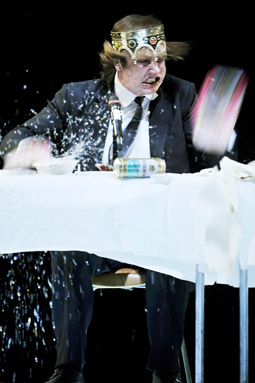
Lars Eidinger, Hamlet, Schaubuhne Berlin
photo Arno Declair
Lars Eidinger, Hamlet, Schaubuhne Berlin
LINDY HUME’S 2009 SYDNEY FESTIVAL WAS FRAMED AT EITHER END OF ITS PROGRAM BY SUPREMELY INVENTIVE AND INSIGHTFUL INTERPRETATIONS OF CLASSIC WORKS: SHAKESPEARE’S HAMLET AND STRAVINSKY’S OPERA OEDIPUS REX. EACH PRODUCTION DREW FROM THE ORIGINAL UNEXPECTED PASSION, HORROR AND PITY, AND, HAVING ESTABLISHED THE FRAME IT WAS TO WORK WITHIN (ITS MODES OF TELLING, PERFORMANCE STRATEGIES, VISUAL MOTIFS), SUSTAINED AND DEVELOPED IT WITH RIGOUR AND CONSISTENCY.
The Schaubühne from Berlin, directed by Thomas Ostermeier, delivered a Hamlet rich in excess and abjection yet able to switch from raucous comedy and spurious violence to moments of intense interiority and intimacy. This was not only because the actor Lars Eidinger is frighteningly adept at such shifts, but because his Hamlet is part of a world that is likewise angry, rattled, impatient and unpredictable and he more than most. Guns are fired at the dinner table, people yell (even Polonius at Ophelia while trashing his meal) and Hamlet intrudes everywhere with a video camera that casts images on a huge screen and reframes our understanding of what is happening to him.
Although other characters take turns at videoing for Hamlet, the tool is principally his but it does more than pry and document. Hamlet’s psyche sees what it wants to see—the huge screen recurrently turns a stale yellow with flying black flecks, like bats or ash. Within this enveloping nightmarish image Hamlet, ‘projecting’ furiously, can create a growling Gertrude out of The Exorcist (much later he spiels an exorcism over the Queen in evangelical American English) and then transform her into Ophelia (played by the same actress). When the camera is turned on Claudius we see him become Hamlet’s dead father (Claudius’ brother), the skull quivering beneath his flesh—another of Hamlet’s conflations and a chilling rendition of the ghost.
The set is a frame that is itself constantly being reframed. Filling almost the width and height of the stage and riding back and forth, downstage and up, it is pulled by the actors over a field of dark earth. The frame that houses the screen (long thin metal chains providing a dense curtain as well) can be separated from its base, so that the screen can stay upstage while the base with table and chairs rolls forward, or vice versa, creating sudden shifts in depth of field with a cinematic verve isolating, for example, a terrified Gertrude in a vast sweep of dirt while Hamlet maniacally romps about her.
A room in the court can open up into a muddy graveyard in which, in the play’s opening, a lone gravedigger struggles to lower a coffin, falling into the hole with it and bouncing up like Buster Keaton while a member of the court creates arcs of rain with a garden hose as if requested to add apt ambience to the funeral (recalling Claudius’ “mirth in funeral…dirge in marriage”). Later in the production there’s a wild hose fight reflecting the frustrations and anger felt in a rapidly collapsing court. It’s the ‘undue haste’ of the marriage of Claudius and Gertrude that seems to have provided the impulse for the production—things are spilt, get messy, people stagger (especially Claudius) and pratfall. Impatience and anger saturate the action. The swordfight between Laertes and Hamlet looks dangerously reckless. Hamlet goes at his “To be or not to be…” speech a number of times for different audiences, as if trying to get a handle on it, going further into it, swapping rational delivery for rant. The production is never short of restlessness and anxiety: Hamlet rattles everyone, and finally himself, uncertain where his actions have taken him.
This Hamlet is a clownish brat, spitting food, singing rock songs and giving way to physical abandon—falls, a flash of sexual intimacy with Ophelia, fights and punkish dancing. He chats with the audience, mocks someone for falling asleep, but enters his moments of interiority with remarkable conviction. His capacity for transformation—discarding his Hamlet ‘fat suit’ to play a sexy Gertrude in the play within the play—is astonishing. Other actors also excel: Urs Jucker’s Claudius sees himself in the master of ceremonies mould, constantly picking up a microphone, dropping chattily into the auditorium to deliver the first part of his confession before returning to the stage to sink deep into his fear and guilt. Again, the consistency of these sudden oscillations of states of being frames a dangerous world in which death threatens and beckons—marked by the constant presence of the downstage centre grave onto which characters fall or bury themselves or each other.
Shakespeare’s text has been cut and pasted and re-written a little into new shape by Marius von Mayenburg but with much fidelity to the original (the work is surtitled). With Ostermeier he has fasioned a Hamlet apt for our own angry, anxious times, drawing us into the consciousness of a man whose madness seems not to be in doubt but who is still complex and memorably affecting. The consistency in framing and motif makes for an engrossing production, not least in the attention to media: the camera, celebrity moments, microphones and songs, and Hamlet mocking Rosencrantz and Guidenstern by creating a mock turntable using a paper plate, fork and microphone, spraying out hip-hop and glitching while squirting juice over the pair from a cardboard container tucked between cheek and shoulder.
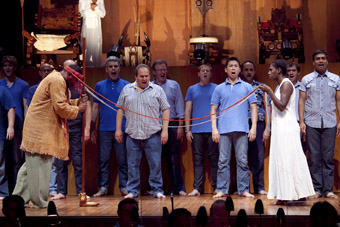
foreground Roderick Dixon, Elma Kris, Oedipus Rex & Symphony of Psalms
photo Jamie Williams
foreground Roderick Dixon, Elma Kris, Oedipus Rex & Symphony of Psalms
I’ve listened to Stravinsky’s Oedipus Rex often but found it somewhat austere. Peter Sellars’ staging and Joana Carneiro’s conducting yield surprising warmth and passion. Sellars has the large orchestra filling much of the lower auditorium floor space, making for a considerably improved aural experience in the Sydney Opera House Concert Hall. On a forestage just above the orchestra an all male choir, casually attired, assembles, and above them there is a narrow plain timber stage backed by a wall and housing four exotic thrones by Ethiopian artist, Elias Simé. Here the tale of Oedipus is enacted in simple costumes suggestive of ancient times. By placing the orchestra and the choir between us and the actors you’d think the effect would be distancing. But the framing provides a heightened sense of ritual and occasion (when Queen Jocasta enters to a trumpet blast, the house lights flood the auditorium. We almost stand to attention).
The choir play a key role in the layering of affect. They are a physical chorus as well as singers; schooled in a gestural language (presumably Auslan), they sign continuously, sink to their knees, fall and roll as one or in groups. The strength of their feelings is made visually as well as aurally palpable and the sense of an engaged citizenry is powerful.
The narration is delivered in English by Paula Arundell, with Sellars effectively casting the narrator as Oedipus’ daughter Antigone. The singing is in Latin, but with limited movement, emphasising courtliness and emphatic states of being, contrasting sharply with the vigour of the chorus.
Although they’re relatively far away from us, the spare staging and almost tableau setting allows for a clear focus on the performers. Movements are simple: Oedipus, his back to us, holds Jocasta affectionately as she sings, but as her resistance to the truth grows she moves to a throne and uses sign language rhetorically and evasively. Not unlike a Sellars staging of a Handel oratorio there’s a suggestion of psychological realism built from minimal means. The singing is superb, especially from Rodrick Dixon as Oedipus, a lightly toned tenor capable of great strength when required.
After interval Sellars changes the frame for Stravinsky’s more positive Symphony of Psalms, adding female singers, the chorus now surrounding the orchestra and lining upper aisles and again gesturing. On the forestage the blind Oedipus led by daughters Antigone and Ismene (Elma Kris) slowly traverses the stage before his disappearance into the underworld.
There were two striking if demanding dance works: Mau: Tempest without a body, from New Zealand’s Lemi Ponifasio, and Dark Matters by Crystal Pites’ Kid Pivott Frankfurt RM from Vancouver. Mau is rooted in Maori dance and culture but also contemporary performance and butoh. Walter Benjamin’s angel of history wanders the stage screaming; a group of monks glide about in fast, small steps and with beautifully complex gesturing; a man very convincingly becomes a dog; a Maori elder addresses us, first revealing his tattoos, later dressed in a suit; and a lone man appears to bend and collapse beneath the weight of the world until a moment of release late in the work. For all of its mysteries, Mau is an engrossing work suggestive of post-colonial tensions, environmental exploitation and a Pacific Rim cultural sharing. Recurrent movement patterns and haunting visual motifs (including a large hanging metal-like sheet that changes texture with light and projections) lend Mau a provisional coherence and implant a desire to know more.
Dark Matters has a more pronounced coherence but appeared to many to slip away in its dance focussed second half. In the first, a man makes a puppet (superbly manipulated by the dancers in black outfits). It turns murderously on him and triggers the destruction of his world—in this case a theatre set. In the second half the dancers alternate between group dancing (chains of elaborate cause and effect) and sublime off-centre duets (Pite has worked with William Forsythe). Among the dancers a puppeteer figure appears and in the final scene is released from her black outfit, taught to walk (by the young man from the first act) and move until she drains him of life. As he lies in her arms, she looks down at him, draws an imaginary thread from his heart and kisses him, bringing him back to life. In this reversal the dark matter of our desires that turn our passions and creations against us is revealed to be human, not abstract, no mere anonymous puppeteer. It’s a pity then that the protracted, fine dancing of the second half seemed to iterate and reiterate duets of interdependence, departing too far from the theatrical framing of the first half and the ending.
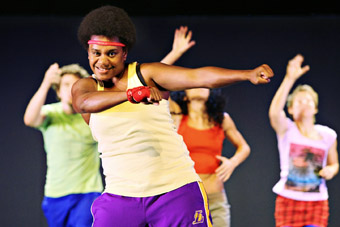
Ghenoa Gela, Happy as Larry, Shaun Parker & Company
photo Prudence Upton
Ghenoa Gela, Happy as Larry, Shaun Parker & Company
Shaun Parker’s Happy as Larry has a satisfying consistency built around a chalk board artist whose impressionistic documentation of his own state of mind and others’ movements begins to build into a major artistic creation. It’s made on a huge rotating black box out of which dancers and personalities of very different kinds manifest and then disappear, perhaps reflecting aspects of the artist’s psyche as he searches for a sense of self and achievement. Much of the work’s happiness theme seems provisional—a performer (Ghenoa Gela) impressively laughs without moving a facial muscle, dancers seem happiest when absorbed in their dancing, one performer’s risky virtuosity begins to worry the others—and the engagingly jaunty music has a melancholy string aspect that suggests a more complex mood. Warranting more review space than is available here, Parker’s subtly memorable work is full of invention, vivid detail, characterful solos and duets and, in the end a smiling ensemble, their happiness well earned.
Red Leap Theatre’s account of Shaun Tan’s The Arrival was done for the most part with great design fidelity to his drawings, although it had to reframe the story with a more obvious narrative and with an inclination to sentimentality (not a Tan vice) towards the end. The performers are solid actors, adroit puppeteers and fine movers. The Arrival should enjoy a long career on the festival circuit.
Festival disappointments included two Irish works. Oedipus Loves You is a punkish semi-musical account of the myth with limited thematic coherence and bad jokes. I’d have rather been at a Dylan Moran show. Giselle from Fabulous Beast began promisingly, a dance theatre work with spoken text and songs transposing the plot of the 19th century ballet to a deeply prejudiced rural village. The community takes to line dancing—innovatively choreographed—while the put upon Giselle’s life unravels. The final stages of the show lose impetus quickly with pretty standard wafty modern dance in the graveyard and a final fatuous image of Giselle trampolining from her grave. Why the line dancing motif wasn’t sustained is a mystery given its earlier integral role and the opportunity for it to be the trap offered by the ghosts of dead young women with which to snare young men. Save for Giselle (McCreedy) the other key female roles were played by men, often dextrously though without making a point as to why. Here was a production that slid out of frame.
Headlong’s Six Characters in Search of an Author was the greatest festival disappointment, not least because the praise lavished on it in London didn’t mesh with what we saw. The promise of a television industry framing of a classic work about identity and self image held much promise, especially after the experience of Hamlet. But the conceit was merely that and was never embodied, either technogically or performatively. Even odder was the presentation of Pirandello’s family, looking as if still living in the 20s, or somewhere thereabouts. Long sections of the original play had the contemporary characters propping up walls, while the decision to document the family drama was agonisingly negotiated. Amidst all the overacting, Ian McDiamard, as the father, made some cogent sense of the family’s plight. But the new, ironic post-theatre ending did nothing for the original conceit except to remind us that we were watching theatre about theatre, with nothing about the media, let alone the selves generated by it.
Muziktheater Transparent’s Ruhe [see David William’s review, p16] was an interesting case of limited framing. Sung beautifully by the members of Collegium Vocale Gent standing on chairs amidst us in Sydney University’s Great Hall, the promised interruptions to the singing were only two, and in the form of monologues delivered by actors moving among us. With numerous songs, this felt more like a concert than a music theatre work. Nonetheless it had a certain power in the juxtaposition of musical beauty, ugly prejudice and site, but after seeing Peter Sellars’ engagement with his choir, albeit in a substantially different kind of work and doubtless greater resources, I yearned for a little more adventuruous dramaturgy.
Hamlet and Oedipus Rex offered complete aesthetic and emotional experiences while Dark Matters and Mau: Tempest without a body suggested an integrity of vision if more challenging to interpret in what was an otherwise uneven and much debated 2009 Sydney Festival. Sometimes it only takes several successful works for a festival to leave its mark. Many people couldn’t get in to see Hamlet, but after all the word of mouth and media coverage felt like perhaps they had.
For more on the 2009 Sydney Festival, see David Williams on Ruhe; Caroline Wake on The Fence; and Ella Mudie on Olafur Eliasson and Lynette Wallworth.
–
2009 Sydney Festival: Schaubühne Berlin, Hamlet, William Shakespeare, translation Marius von Mayenburg, director Thomas Ostermeier, design Jan Pappelbaum, Sydney Theatre, Jan 8-16; Shaun Parker & Company, Happy as Larry, director-choreographer Shaun Parker, designer Adam Gardnir, composers Nick Wales, Bree Van Reyk, Riverside Theatre, Parramatta, Jan 22-24; MAU: Tempest without a body, concept, design, choreography, text Lemi Ponifasio; Seymour Centre, Jan 10; Fabulous Beast, Giselle, director Michael Keegan-Dolan; CarriageWorks, Jan 20-26; Headlong, Luigi Pirandello, Six Characters in Search of an Author, adaptors Rupert Goold, Ben Power, director Rupert Goold; Seymour Centre, Jan 19-31; Stravinsky, Oedipus Rex & Symphony of Psalms, director Peter Sellars, conductor Joana Carneiro, Concert Hall, Sydney Opera House, Jan 28-30; Pan Pan Theatre, Oedipus Loves You, director Gavin Quin, Seymour Centre, Jan 21-25; Musiktheater Transparant, Ruhe, Collegium Vocale Gent, Great Hall, Sydney University, Jan 25-29; Red Leap Theatre, The Arrival, creators Julie Nolan, Kate Parker; CarriageWorks, Jan 10-17
RealTime issue #95 Feb-March 2010 pg. 14-15
© Keith Gallasch; for permission to reproduce apply to realtime@realtimearts.net
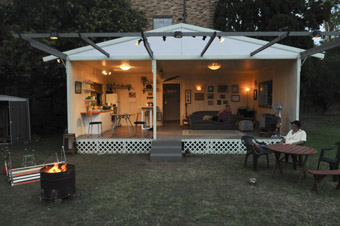
Helen Dallas, Richard Green, The Fence, UTP
photo Heidrun Löhr
Helen Dallas, Richard Green, The Fence, UTP
IN ORDER TO GET TO THE FENCE, WE HAVE TO TRAVERSE A FEW OURSELVES. STARTING AT PARRAMATTA RIVERSIDE THEATRE, WE WALK UNDER THE BRIDGE, ACROSS THE LAWN AND THROUGH A TUNNEL BEFORE WAITING ALONGSIDE A WIRE FENCE TO ENTER THE WIDER ENCLOSURE WITHIN.
Once in, we apply insect repellent, purchase programs and then wait at another fence on the other side. From here we walk up a wooden ramp before taking our seats in the red raked bleachers. Below is Alison Page’s meticulous set: the back half of a suburban house without its fourth wall. Inside there is a couch with cushions, two tasteful lamps, a wall of framed pictures, a stereo, a television, and a kitchen where a woman is cooking. Outside there is a shed, a steel drum and a wooden table with three green plastic chairs.
Soon enough the cook—Joy (Skye Quill)—announces that dinner is ready. She and her indigenous partner Mel (Kelton Pell) settle down on the couch but they are interrupted when a teary Lou (Helen Dallas) emerges from the bedroom, phone in hand and fresh from another break-up. Mel’s friend Chris (Richard Green) cruises in looking for a feed and throughout all of this, someone travelling suspiciously light lurks outside. The phone rings, Mel picks up and a voice says, “You took long enough.” Standing in the backyard, the intruder turns out to be Mel’s sister Connie (Vicki Van Hout), whom he hasn’t seen for ten years.
Thus the scene is set for a night of reunion, remembrance and occasional disagreement. Characters drift in and out of the house and through a series of elliptical conversations. Sometimes there are two conversations going on at once, such as when director Alicia Talbot, master of the split stage, places Lou and Connie inside while Mel and Chris converse outside. Then Joy, who apparently has a history with Connie, re-emerges to reprimand Chris for not being at home and Mel for not being inside talking to his sister. Lou breezes by, asking airily if she’s interrupting anything and everyone dances languidly around the living room to Steve Miller’s “The Joker.” (Liberty Kerr’s sound design and song choice are excellent throughout.) Lou cheers up and announces that she’s going out: “I’m going to find a man.” “I’m going to watch her find that man”, says Connie. “Maybe I’ll go too”, muses Joy but the moment passes before they get out the door.
The men retreat to the shed and the women’s conversation turns to children, biology as destiny and the perils of population growth. Once again we seem to be talking around something rather than about it until the conversation seems to slide out of anyone’s control. Suddenly Joy is goading Connie: “I turned out okay; you’re pretty fucked up though;” Connie is replying, “Don’t speak for me, my mother loved me. Number 184 doesn’t need a mouthpiece”, and Joy is threatening to throw her out of the house. It sounds explosive, but it isn’t—it’s just a conversation gone unexpectedly awry. When Connie goes outside to confess to her brother that she and Joy have had a blue, she says simply. “Ten years come and gone in one fell swoop.”
The Fence chronicles a night, and through it a lifetime, of loss, survival and reconciliation. Like The Cement Garage (2000), The Longest Night (2002), Back Home (2006) and The Last Highway (2008) before it, this show has been devised in collaboration with community consultants around a large contemporary theme: in this case institutional care as experienced by both the Stolen Generations and the Forgotten Australians. Once again, Talbot has created a piece of neo-naturalistic theatre in a non-traditional theatre space. This time, however, the usual magic is missing and the historic site—on the lands of the Burramattagal and Wallumattagal people, near the former Parramatta Girls Home, and the former site of the King’s School—seems to work at cross purposes to the set. Whereas the site functions to blur the line between theatre and reality, the kitchen-sink set serves to reinforce it: this isn’t a real house, it’s a really good re-creation of a house and it would make almost as much sense in a theatre as it does here.
Nevertheless, there is a tangible sense of intimacy within it, thanks to the understated performance of the cast. Like his character, Pell provides an anchoring presence while Quill is both brittle and vulnerable as his partner and Green is suitably restrained as his taciturn friend. Similarly Van Hout is lean and slightly nervy as the evasive Connie and Helen Dallas is a voluptuous and vivacious Lou. Through this improvised family The Fence makes visible what many of us take for granted: the minor miracle of everyday life. The performance ends with Connie walking off into the night and Mel placing leaves in the burning drum, creating a smoking ceremony of sorts. Home is where the hurt is, the hearth is, and—when we are lucky—the heart is.
–
2009 Sydney Festival, Urban Theatre Projects, The Fence, direction and original concept Alicia Talbot, performers and co-devisors Helen Dallas, Richard Green, Kelton Pell, Skye Quill, Vicki Van Hout, set design Alison Page, lighting design Neil Simpson, sound design Liberty Kerr, community liaison Lina Katsoumis; Parramatta, Sydney, Jan 14-30
RealTime issue #95 Feb-March 2010 pg. 16
© Caroline Wake; for permission to reproduce apply to realtime@realtimearts.net
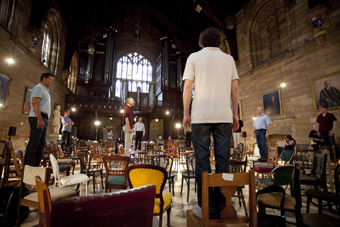
Ruhe, Muziektheater Transparant,
photo Jamie Williams
Ruhe, Muziektheater Transparant,
ON ENTERING SYDNEY UNIVERSITY’S GREAT HALL, I AM FACED WITH A MULTITUDE OF TIGHTLY PACKED MISMATCHED CHAIRS FILLING THE SPACE. WATCHED BY PORTRAITS OF PAST CHANCELLORS, I NEGOTIATE MY WAY AMONGST OTHER AUDIENCE MEMBERS.
As the last stragglers are seated, an ordinary-looking man in front of me stands on his chair, joined by another eight men. They are the renowned choir Collegium Vocale Gent and sing, in glorious a cappella harmony, a selection of songs by Franz Schubert. The title of the performance comes from their third song, “Ruhe, schoenstes Gluck der Erde” (Rest/calm/silence, earth’s sweetest joy).
The setting is perfect for a recital, and the singers are divine. But nothing in Ruhe is as simple as it appears. From within the huddled mass of audience, a woman stands and begins speaking, cutting off the choir mid-song. She speaks of her experiences as a paid-up member of the National Socialist Party working as a nurse in an SS hospital in occupied Holland. In her reminiscences she’s enthusiastic and bubbly, awestruck by the brave injured men for whom she cared. Despite the grimness of the hospital’s speciality—amputations and rehabilitation for those with artificial limbs—hers is a great adventure. “I realised how useful I was… I was doing something that really, really mattered.” She remembers gushing upon seeing Himmler for the first time. He was, in her opinion, very nice. Much later, in a crowded train with the rest of the hospital fleeing the Allied advance, she remembers hearing of Hitler’s death on the radio, and weeping.
As her story concludes, the choir begins to sing again, as if their beauty might relieve the disquieting memories of this apparently nice young woman. Soon after however, a man stands in the audience interrupting their song. “The thing I liked about National Socialism,” he declares, “was the socialism.” He wasn’t so interested in the nationalism, which perhaps made sense, given that he was a Dutch member of a German party. “A minority should never have more than their rightful share,” he states in a reasonable and mild tone. He’s much easier to dislike than the woman, clearly an adherent to an ugly ideology, and yet his words have an uncomfortable plausibility. I’ve heard words like these before, from Australian mouths.
The texts are drawn from Armando and Hans Sleutelaar’s book De SS’ers, a series of interviews in the 1960s with Dutch members of the SS during Word War 2. In the program notes, Tom Jansen, who adapted the text with director Josse De Pauw, suggests that the performance is motivated not by a political agenda, but rather by the “gripping confusion raised by the material.” But in the face of this testimony, it’s difficult to avoid thinking about nationalist political movements, past and present. These are familiar exclusionary politics, complete with ugly moral equivalences, and active blindspots.
“You’ve got a nerve bringing this up,” the man declares when the reality of the gas chambers threatens his rational anti-Semitic ontology. He agrees that, “gassing people is not a decent thing to do.” But he’s equivocal. “It’s a better way to die than firebombing,” he states, expressing outrage about the Allied destruction of German cities, embracing the grisly algebra of ‘better’ deaths. Who is this audience to judge him? “You’re not such nice guys yourself.”
Neither of the speakers repudiates past actions. The man even describes himself as “an idealist”, adding helpfully that it might be best for all idealists to be lined up and shot. The woman suggests that she was simply doing her duty in a struggle against communism. “Why,” she asks, “is it okay to fight Communism now and it wasn’t back then?” It’s an awkward, if self-deceptive question. By placing this testimony alongside angelic singing, Ruhe masterfully interweaves beauty and what Hannah Arendt has described as “the banality of evil,” an evil uncomfortably close to home.
Finished with Schubert, the choir move to a raised platform at the far end of the hall, from which they begin another Ruhe, composed by Annelies Van Parys. Beside them is a projected monochrome image, a pastoral scene dominated by a huge tree with two farmers standing in front of a windmill. The tree’s leaves rustle gently in a breeze, but the human world within the image remains frozen. It’s a magnificently unresolvable image with which to end a gentle, beautiful, and deeply disturbing performance experience.
–
Sydney Festival, Muziektheater Transparant, Ruhe, conceived and directed by Josse De Pauw, text Armando, Hans Sleutelaar, text adaptatio Tom Jansen, Josse De Pauw, music Franz Schubert, Annelies Van Parys; music selection Jens Van Durme, set, lighting design Herman Sorgeloos, performers: Han Kerckhoffs, Truus te Selle, singers: Collegium Vocale Gent; Great Hall, Sydney University. Jan 25-29
RealTime issue #95 Feb-March 2010 pg. 16
© David Williams; for permission to reproduce apply to realtime@realtimearts.net
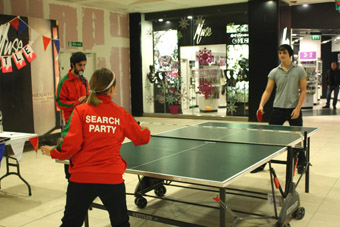
Search Party Vs Newcastle
photo © Film Bee and the artists
Search Party Vs Newcastle
AFTER 77 GAMES OF TABLE TENNIS AND A HOME VICTORY FOR NEWCASTLE, 40 TO 37, SEARCH PARTY CONCLUDED, “ALL THAT IS LEFT NOW IS FOR THE PEOPLE OF NEWCASTLE TO TELL THE TALE—TO TELL THE TALE IN THE CAFES, DURING THE EYE TESTS AND THE SHOE FITTINGS AND THE MANICURES, AT THE TILLS OR THE CASH POINTS, IN THE QUEUE TO THE LADIES TOILETS…”
From the candid to the visceral, a table tennis marathon in a shopping centre, the slumber party disco dance-floor of Goh Ideta’s installation piece, Reflections, to Mammalian Diving Reflex’s internationally travelled project Haircuts by Children, Wunderbar captured the imagination. It sought out audiences, enticed people to try things, to go with it, to get involved. By engaging people in not quite the everyday, but with familiar moments of universal appeal, Wunderbar in turn created surprises. In doing so it has left tales to tell; of course it has been blogged, tweeted and facebooked and posted within the confines of friend groups and forums. But whereas the online lifespan of these lie in the moment, what Search Party prophesied and Wunderbar has achieved is an ongoing dialogue about experiences gleaned and events witnessed.
Of the projects I have enlisted to discuss, what was fundamental was their participatory ethos; the way in which they made people part of the work; the sense in which the work made the audience feel they were able to get involved, to take ownership. Whether playing a game of table tennis, stepping across the threshold of someone’s home, standing up and being counted in The People Speak’s Who Wants to Be…? or buying into the cult of Reactor’s Big Lizard people unknowingly became audiences, some became performers and in some instances, participants became artists.
Manipulating the role of the artist in the creation of an event, for Tours of People’s Homes, Joshua Sofaer took on the role of director, collaborating with 12 members of the public to devise 11 unique events in the private domicile of their own homes. Billed as an opportunity to impart a story, to show off one’s home, possessions or hospitality, audiences were offered the opportunity to enter a stranger’s home and share in a host of experiences from reliving the pop (fizzy and musical) indulgences of youth to hearing an intimate life-changing story, to helping throw a food fight.
Others took a more critical response to the brief. Nathalie Levi mused that “you really can’t just let complete strangers into this house in this day and age.” She punctuated the tour of her home with various security checks—demanding proof of identification, giving a thorough frisking and an intimate interrogation before just as quickly hustling you out the back door.
Kate Stobbart’s Invitation to Tea was at face value an opportunity to become acquainted with a group of strangers over a meal. Reflecting the social niceties and insincerity that often underlie invitations into one’s home, dinner was served on crockery decorated with truisms, observations and outright insults. Though these comments were not necessarily individually directed, their acerbic overtones made the culinary accompaniments, at points, indigestible. The guest to my left, who sat near silent throughout the meal dined from a series of plates telling him, “You just love the sound of your own voice” and “I wish you would just shut your face.”
Bath Time made for a suggestive proposition and an unusual offer; “have a bath with brother and sister Peter and Katy Merrington.” Ostensibly it was just that, a bath run for you to your particular specifications. A bath into which you were invited to relax and relinquish yourself to be doted upon by brother and sister as they perched aside the bath washing your hair and scrubbing your back. In terms of protecting one’s modesty, far from my imagined scenario of embarrassment, I was wholly unprepared for just how sympathetic, generous and just how normal my bubble-bath turned out to be; fortune favoured the brave. Reflecting that whilst at certain points in one’s life such assistance in bathing may be necessary, in this instance the unnecessary decadence of the action highlighted the siblings’ selfless kindness.
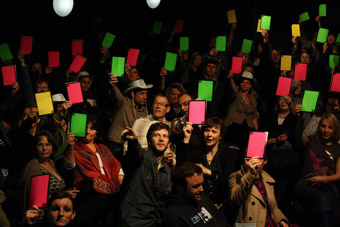
The People Speak, Who Wants to Be…?
photo © Film Bee and the artists
The People Speak, Who Wants to Be…?
Courage of convictions was something put to the test in The People Speak’s quasi-television game show, Who Wants to Be …? In this bastardised format, the audience became contestants in an autonomous quest not to win, but to spend the money. Having each literally bought into the process though the entrance fee, the following three hours were then spent debating ways and means of putting the accumulated cash, a not insignificant sum of £1,070, to ‘good’ use. Literally any proposal was an option, as long as it was voted on: green for ‘yes’, red for ‘no way’ and orange for ‘I just don’t give a damn.’ Amidst the bickering, quibbling and voting, two definite camps of reason made themselves evident: those in favour of the more worthy outcomes and those drawn to the ridiculous and more daring suggestions. As majority ruled, the most worthy of the shortlist came up trumps and collectively we agreed to purchase an electricity generator for Zambia. Though at the end we left with a self-satisfied warmth resulting from the good deed, I also think many left with an air of disappointment that something more audacious hadn’t in fact snuck in the back door; the mildly unsatisfying feeling of democracy.
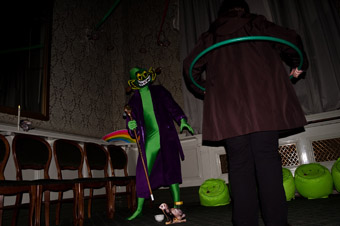
Big Lizard’s Big Idea, 2009, Reactor
© Film Bee and the artists
Big Lizard’s Big Idea, 2009, Reactor
Within the tenet of Wunderbar to let yourself be absorbed by an idea, by an experience, Big Lizard and the ‘big idea’ embraced this concept in its most ambiguous sense. Taking to the streets of Newcastle aboard the Big Idea Fun Bus, Reactor took the conceit of Big Lizard on the campaign trail to canvas support, armed with stickers, balloons and special appearances by the big cuddly personality of Big Lizard him/herself. As a character Big Lizard is created in the likeness of the promotional gimmickry upon which commercial enterprises—from gas companies to breakfast cereals—and societal campaigns, like those about the health dangers of smoking, try to create an identifiable and memorable image for their brand or social enterprise. Big Lizard’s purpose is much less clear. The Big Idea is sold to you with equal, if not greater vehemence and conviction, but what you are being asked to buy into, advocate or support is not stipulated beyond the figurehead of Big Lizard. Framed around ice cream, champagne parties and a campaign vocabulary of positivity you are asked to engage in the beneficial and most likeable aspects of Big Lizard and how his or her existence might better one’s life: what’s so great about Big Lizard?; do a drawing of yourself with Big Lizard. Like the promotional campaign methodologies hijacked by the project, Reactor are coaxing you to knowingly or subversively buy into the idea by reiterating and validating Big Lizard and his somewhat sinister Big Idea. “Big Lizard’s fun, give him a hug!”
Like Big Lizard, Wunderbar has employed subversive tactics in the way it has promoted and publicised the idea of a festival. Selling experience and interaction, it has been able to dispense with promoting the festival with the branding of either live or performance art. Certainly there was a presence of such well-rehearsed performance artists as Alastair Maclennan in the festival, but even their synonymy with live art was refocused as performance as event. Instead of art for art’s sake maybe Wunderbar could be described as being a series of events: events for event’s sake.
Wunderbar Festival: Search Party vs Newcastle; The People Speak, Who Wants to Be…?; Joshua Sofaer, Tours of People’s Homes: Nathalie Levi, Massive Giveaway; Peter and Katy Merrington, Bath Time, Kate Stobbart, You’re so not worth it; Reactor, Big Lizard’s Big Idea; Newcastle upon Tyne, Nov 6-15, 2009, www.wunderbarfestival.co.uk
RealTime issue #95 Feb-March 2010 pg. 18
© Matthew Hearn; for permission to reproduce apply to realtime@realtimearts.net
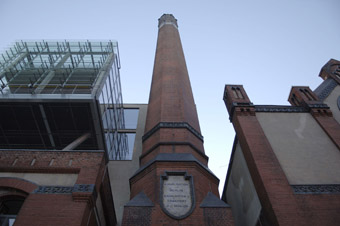
RADIALSYSTEM V
photo Sebastian Bolesch
RADIALSYSTEM V
RealTime 95 is the city extra. New multi-functional artspaces are springing up in cities around the world, often in former industrial regions, resulting in artist-led urban regeneration, the housing of new art practices and the development of new artist-audience relationships. We report on this phenomenon from a busy and informative conference at RadialSystem V in Berlin in which centres were represented from Glasgow to Warsaw, Jakarta and Sydney. We also spoke to Berlin artists and curators about the changing relationship between their city and the arts, the ambition, for example, for the city to become an arts and knowledge laboratory. Carlos Gomes reports on the role contemporary performance has in understanding the mega-metropolis of Sao Paolo and how it transforms city districts. Robyn Archer, reflecting on Gavin Findlay’s essays in RT93 and 94 on the demise of innovative performance in Canberra, projects a bright future for the arts in that city. Reports from Newcastle (UK and NSW), Perth and Kuopio in Finland reveal the diverse ways artists are engaging with the city. Mike Mullins recalls Sydney in the 70s and 80s and the evolution of The Performance Space and ‘new form’ practices.
RealTime issue #95 Feb-March 2010 pg. 1
© Keith Gallasch; for permission to reproduce apply to realtime@realtimearts.net
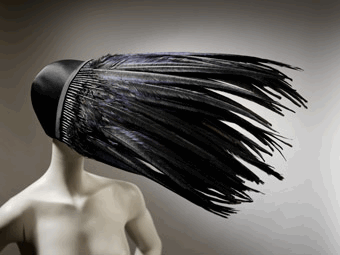
Stephen Jones’ hats: Jo Gordon, Kiss of death 1994, © V&A Images; Stephen Jones, © Justine Photography
heady stuff: stephen jones’ hats
It’s not the Sydney media arts expert Stephen Jones, but someone even headier, a UK hat artist with a Brisbane-exclusive exhibition, Hats: an Anthology by Stephen Jones, visiting the Queensland Art Gallery from London’s Victoria and Albert Museum. The garden-like millinery exhibition includes 250 hats and head pieces ancient and modern including Jones’ own creations (Mick Jagger’s hat for the Rolling Stones A Bigger Bang World Tour) and a journey through the life of a hat. Hats: An Anthology by Stephen Jones, Queensland Art Gallery, March 27– June 27; www.qag.qld.gov.au
blissful opera
Peter Carey’s Bliss, a grippingly strange novel, was unexpectedly and memorably adapted to the screen in Ray Lawrence’s film (1985), which upped the book’s 80s oz-surrealism. The bigger than life characters, situations and ideas lend themselves to opera just as well as film, though pulling off the more fantastical elements onstage will be an exciting challenge. We might though get a deeper feel for Harry Joy’s inner world, the kind offered by listening as much as looking. Brett Dean is an award-winning composer who manages to bridge accessibility and challenge, creating memorable themes and engaging textures. Peter Coleman-Wright will play Harry, Neil Armfield is directing and the libretto is by Amanda Holden. Opera Australia, Bliss, World Premiere, March 12-30, http://opera-australia.org.au
desperately hoping: stvdio arts channel
Ovation, better known these days as the Andre Rieu channel, has been taken over by SBS and re-named STVDIO. ABC TV’s revolution in arts & entertainment erred on the side of the latter with a plethora of comedian-led competition programs. There have been the occasional late Tuesday night art programs from Andrew Frost and Marcus Westbury and the quaint, numbing Sunday Arts show (now deceased), but little else. Cable subscribers are keeping their fingers crossed that STVDIO will provide recent documentaries and features alongside worthwhile classics with a broader and more challenging approach to the arts here and overseas than Ovation’s ever narrowing and repetitious ambit. STVDIO, from April 1.
genre-hopping: tiny stadiums festival
One of the more scintillating contemporary arts events of 2009 was the Tiny Stadiums Festival, revealing new talent and ideas about performance, installation and networking. Describing the event as “a contemporary arts festival of genre-hopping live art”, the Quarterbred team have “curated a program made up of accumulative and durational projects that design and redesign the village, your hankies and your hair.” And it’s mostly free.
There’ll be the unveiling of a miniature Erskineville—a fun critique of the village into which Tiny Stadiums is increasingly insinuating itself with performances, installations and screenings in shops, vacant lots and a pub. Tristram Meechams’ Back To Hair Technology promises that you’ll “walk a mile in a bald man’s head by receiving your very own bald cap.” On a different hair tack, hairdresser Jade Markham will style and curate buns in Bunhead. In Photo-Opp Melbourne-based artist Zoe Meagher will offer herself in Ken’s Cake Shop for endless photo opportunities with you as the photographer: “it’s the subject who is constant, eternally waiting for the fleeting photographer to appear and complete the image.” Parachutes for Ladies will test the conformity of mass dancing with you in The Dance of Death. If that makes you weep you’ll doubtless respond to Amy Spiers’ Sob Stories, on-hanky tales of public teariness. Melbourne based collective Tape Projects will present video art at the Rose Hotel. Tiny Stadiums is curated by Quarterbred, an artist run initiative, in residence at PACT. Erskineville Road shops, parks and PACT, Feb 22-March 7; www.pact.net.au
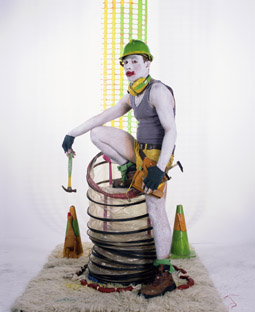
Eric Bridgeman Boi Boi The Labourer 2008 – 2009, part of Mind Games, ACP
© the artist
Eric Bridgeman Boi Boi The Labourer 2008 – 2009, part of Mind Games, ACP
mind games: other selves in the picture
ACP’s new show, Mind Games, is a potent mix of works from Papua New Guinea/Australia, South Korea, Japan and the UK focusing “on the psychology of play and the construction of identity.” The most immediately striking images come from Eric Bridgeman who himself performs The Sport and Fair Play of Aussie Rules, “a series of caricatures that parody and critique stereotypes of masculinity and femininity in both black and white Australian culture.” A recent graduate of the Queensland College of Art, Bridgeman has already exhibited widely, attracting attention for his 2007 series Blue-Colour Picture exploring his heritage in the Queensland mining town Cracow and blue-collar masculinity. The other artists in the show are Suk Kuhn Oh (South Korea), Toshie Takeuchi (Japan) and the Jackson Twins (UK) who “present a series of ironically melodramatic self-portraits that draw on the anxious fascination of pop culture with identical twins: cloning, doppelgangers, sibling rivalry, ESP and the notion of the evil other.” Australian Centre for Photography, Mind Games, Photography, Identity and Play, Sydney, Jan 29-March 6, http://tmp.acp.org.au
experimenta’s happy critique: utopia now
Experimenta’s big exhibitions, now cast as an international biennial of media art, have always had an optimistic aura, the result of a certain playfulness and hands-on opportunities for audiences that tally with their daily new media experiences. But this time the biennial is addressing the flaws in “the dream of a perfect world”, never an easy fantasy given the state of the world and the diminution of utopian thinking. However it looks like it’ll be a fun critique: “Pull up your leg warmers and bust a move with our interactive dance party in a box; become a sticky shadow magnet and lead a chorus of interactive singing plants; take sides as Australian and international artists unite and fall out over the future survival of the planet.”
Also on the program of 25 works from Australia, Japan, Austria, India, Germany, Canada, France, Taiwan and the UK are “the funkadelic International Dance Party, a complete party in a box which transforms from humble transport crate into a powerful party machine that increases its frantic output the harder and faster you dance; Akousmaflore, a hanging garden composed of living musical plants that react to human gesture and gentle contact; Shadow 3, an interactive installation where the by-products of our consumerist society fall from the sky like rain, inundating your shadow with a deluge of debris; and You Were in my Dream, an off-the-wall ‘choose your own adventure’ dreamscape where interacting with familiar fairytale characters draws you into an enchanted fractured forest. [R]enowned Japanese/American artist Momoyo Torimitsu performs with her life-size robotic businessman Miyata Jiro as he crawls his way commando-style through the CBD battlefield like so many before him.” Experimenta, Utopia Now, International Biennial of Media Art, Blackbox, The Arts Centre, Melbourne, Feb 12-March 14; www.experimenta.org
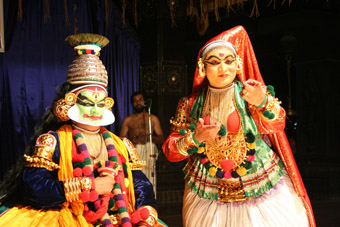
Kathkali Dance Ensemble, part of Womadelaide
photo courtesy the artists
Kathkali Dance Ensemble, part of Womadelaide
womadelaide: classical indian rarity
An extremely rare opportunity presents itself in March to see classical Indian dance drama. The visiting Kerala Kalamandalam Dance Company will perform The Killing of Dushasana, a central episode of the Mahabhrata telling the story of rival families, the Kauravas and the Pandavas. The work will be performed in traditional Kathakali style with 17 dancers, singers, actors, drummers and, not least, make-up artists. A centrepiece in the tense unfolding drama is Lord Krishna’s sermon on selfless action and the setting out of the concept of Dharma. If you can’t make it to Womadelaide there are one-off opportunities in Sydney and Melbourne. Womadelaide, Kathakali Dance Ensemble, Feb 6-7; www.womadelaide.com.au; Seymour Centre, Sydney, Thursday March 11; Melbourne Town Hall, Tuesday March 9
RealTime issue #95 Feb-March 2010 pg. 20
© RealTime ; for permission to reproduce apply to realtime@realtimearts.net
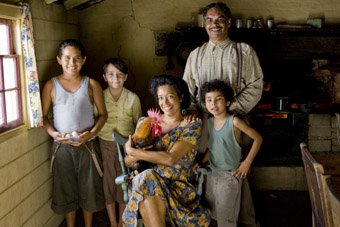
Aunty Maggie and the Womba Wakgun
courtesy Bungabura Productions 2009
Aunty Maggie and the Womba Wakgun
THE LATEST INSTALMENT IN THE ‘SAND TO CELLULOID’ (AS IT WAS ONCE TITLED) SHORT DRAMA SERIES FROM SCREEN AUSTRALIA’S INDIGENOUS DEPARTMENT IS THE NEW BLACK. ONCE AGAIN THE PROGRAM BRINGS TOGETHER EMERGING FILMMAKERS AND EXPERIENCED PRODUCERS (INCLUDING KATH SHELPER, DARREN DALE, PAULINE CLAGUE AND LISA DUFF WORKING ALONGSIDE NEW PRODUCERS) AS WELL AS SKILLED CINEMATOGRAPHERS, EDITORS AND OTHER CREW.
The resulting films are, as ever, engaging, rewarding and of high quality. What is immediately noticeable are better production design, ever more sophisticated camerawork, tighter narrative structuring and more uniformly good acting. All levels of craft are growing exponentially in Indigenous filmmaking. What is missing is a certain verite quality, a rawness that gave earlier series an almost documentary edge to the drama. It doubtless indicates a greater diversity of approaches to filmmaking from new talent and their skilled nurturers. And there is a lighter touch to some very serious themes in The New Black than in previous collections.
aunty maggie & the womba wakgun
Leah Purcell co-directed the documentary Black Chicks Talking in 2001 with Brendan Fletcher. Her first drama is Aunty Maggie & The Womba Wakgun, a gently comic, confidently accomplished account of a mother who invests in a rooster and hens with which to supply her three boys and husband with eggs for breakfast instead of porridge. The rooster fails to do his job, nearly dies, is given mouth-to-mouth by mum (family revulsion all round) and amazingly comes good. Eggs are laid. The fun is in the detail and the consistently conveyed sense of idealised historical reconstruction.
The film is based on an actual incident in writer Angelina Hurley’s family in the 1950s, but the world portrayed here could be anywhere from the 20s to the 50s—a pleasant sunny place in the somewhere long ago—but “not dream time”, insists the voice-over. The poor but genteel Aboriginal community is well-dressed and groomed (the men’s hair parted and slicked down, mum’s bouffed up), the house under-furnished but bright, and the neighbour haughty about the chook business. Rachel Maza Long makes the bouyant and determined mum just a little larger than life, Kelton Pell is a bemused, tolerant husband, and the boys play their part with ease. Hurley’s script is aptly spare and Purcell’s direction economical—the challenges of poverty are not overplayed but are felt, for example, in the shop scene when mum fails to purchase eggs. The use here of sharply angled medium and close-up shots is effective as elsewhere in Mark Wareham’s fine cinematography. There’s an aptly amusing exhange of p.o.v. shots between mum and rooster (in a cardboard box with holes punched in it) which anticipates their coming together. Aunty Maggie & The Womba Wakgun is a loving work of family legend-making considerably aided by Nicki Gardiner’s production design, Bruce Kinven’s costumes and Dany Cooper’s deft editing.
ralph
Deborah Mailman’s Ralph is a somewhat more naturalistic venture but, fable-like in formula, also inclining to an idyllic view of another time, Sydney’s Redern in 1984. But on the way 10-year-old Madelaine endures bullying at school, an indifferent teacher and the realisation that her new friend, Garth (initially a tease, chopsticking a cockroach but later caned for coming to Madelaine’s defence) lives a difficult life in Redfern’s Block. Prior to this she’s been totally preoccupied with her screen hero, Karate Kid Ralph Machio, but in Garth the real world beckons and her affections shift—a mini-rite of passage. The final scene is squarely framed like a dream come true, all troubles overcome. The bullies attempt to turn Madelaine (in a new frock from her benign mum) away from the school dance, but Garth appears, immaculatey dressed (blue-striped shirt and blue tie) to walk her in. Just how Garth managed to reappear and in such good nick is necessarily left unexplained in this simply but deftly constructed drama that younger audiences will doubtless relish. In the moments when Garth and Madelaine wait beside the sandstone school building, their isolation, but also their commonality, is nicely framed and marked by stillness. Ralph is sparely scripted by Mailman and Wayne Blair and economically shot by Bonnie Elliott.
bourke boy
In Bourke Boy, writer-director Adrian Wills, maker of the fanciful five-minute comedy Jackie Jackie (2007), turns his hand to darker material. A white father (Andrew Macfarlane) takes his adopted Aboriginal teenage son (Clarence John Ryan, a strong presence) to the town where the boy was born, Bourke. It’s a difficult occasion. The boy has been misbehaving and it’s believed the visit will somehow or other settle him. Man and boy are reticent, stare at the old hospital from the outside and later drive nervously into the Aboriginal community outside town, only to turn around and leave at the moment the boy sees a woman who might just be his birth mother. The end. It’s a blunt finish but consistent with the protagonists’ inability to address at any length the crisis they face and which will remain unresolved.
A racist motel owner is rather awkwardly inserted into the narrative, but the son’s challenge to his father for shaking hands with her rings true as a moment of awareness marking his difference. The father simply replies, “It’s what you do.” Two of the film’s most striking moments are almost silent. The father watches his sleeping son in the motel, listening to the soft breathing of his rising and falling chest. As we admire the boy’s beauty we sense the father’s mix of affection and incomprehension. Then in the morning light, and observed low in the frame, the son picks up a handful of Bourke dirt and slips it into his pocket. Suggestive of a bigger story, Bourke Boy is a quiet and intense film—a portrayal of inadequate communication and a sadly incomplete rite of passage. Hugh Miller’s camerawork is aptly intimate.
the farm
Ghosts are recurrent presences in Aboriginal films. In Romaine Moreton’s The Farm a young girl (Madelaine Madden) watches them drift by her in the river as she swims after working as a bean picker with her mother and brother. She’s alarmed, but floats, not panicking, even touching a pale hand. In a steaming bath, she notices the names of past generations etched into the timber of the pickers’ shack. When asked, her suddenly angry mother (Lisa Flanagan) refuses to tell her what happened to those people: “When you’re older.” Later a spirit addresses the girl during the picking, no-one else seeing or hearing the presence; the girl’s mother grows anxious. In an act of identification, the girl floats in the river in her best dress, like a ghost herself. She etches her own name into the timber
Most of the scenes are brief, small moments of eerie beauty. In a longer passage, the girl’s mother, as if realising that she needs to do something to acknowledge the girl’s connection with the past, presents her with a necklace with a large amber ‘stone’ passed on from her own mother. She describes the amber as “a tree’s way of remembering…We die if we’re forgotten.” Mother and daughter are united. On the way to the local show, it’s as if the mother knows that her daughter can see the spirits of the dead walking on the side of the road. We see them too, before they fade, but they are now remembered by a new generation—even if we never learn their particular fate. There’s a lush beauty to Warwick Thornton’s cinematography, amplifying the haunted quality of the narrative as well as providing, with the warm performances, a sense of security, a safe, supported rite of passage.
nia’s melancholy
Nia’s Melancholy is also about an adolescent girl encountering ghosts but in more emotionally demanding circumstances. Nia (Tasia Zalar) must come to grips with her sister Lania’s suicide, at the same time as she is leaving her small home town. The film opens in a ‘secret’ place in the bush with her late grandmother instructing the sisters as children about the use of seeds as food once the poison is drained from them. Nia’s voiceover also recalls that Nana “would always speak to the old ones and they would listen.” The idyllic opening with its briskly stated themes is then starkly supplanted as Nia walks away from her sister’s body hanging from a tree at the edge of the schoolyard. She carries one of her sister’s rubber thongs, later slipping it on in her bedroom, triggering memories of Lania’s warmth and humour.
Nia’s mother (Kyas Sherriff) is hostile to her daughter’s determination to go to Cairns to train as a nurse, thinking the girl will never return: “you’ll forget all about us.” A close-up of an abandoned cigarette and a subsequent scene in which Nia attacks an out of control garden hose as if killing a snake are tellingly grim, wordless interludes. Nia then ventures to the secret place of her childhood, accidentally falls and concusses herself and slips into another world where she finds Nana and her sister who explains, “I was tired, so tired, not strong like mama, not like you.” Nia returns home (we watch her walk beneath the noose still hanging from tree) and soon leaves for Cairns, the tensions between mother and daughter unresolved but the mood amiable. She promises her young sister that she will return to take her to “a secret place.” This bond with her home is confirmed in the final scene when she sees Nana’s spirit walking behind the bus, waving her farewell. Perhaps the resolution is a little too easy, bordering on the sentimental given the palpable tensions writer-director SF Tusa and cinematographer Jason Hargreaves admirably convey, but the tale has an internal, if again fable-like consistency.
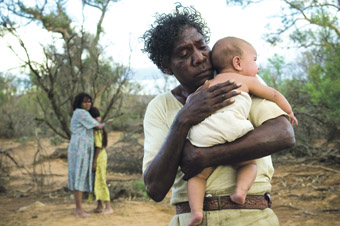
Ningalee Lawford-Wolf, Allira Coutard, David Ngoombujarra, Connie Amos, Jacob
photo Sam Oster
Ningalee Lawford-Wolf, Allira Coutard, David Ngoombujarra, Connie Amos, Jacob
jacob
Night, lights in a window. The cry of a new baby. The screen fills with the stark vista of dry cattle land in Central Australia, 1940. The view quickly narrows, camera and rapid edits closing in on tired timber fence poles and then the workers repairing them. A rider comes in from the far distance bearing news of the birth of a son to a proud father, the younger of the two workers. We guess later the other is his father-in-law. The view is reversed in the next scene, four months later, as a woman watches anxiously through flapping washing as the men on the horizon return to the outstation.
The new baby is white. The would-be father withdraws from his young wife and despite his father-in-law’s plea for sympathy—”She’s not to blame, you know. The boy is who he is.” When his wife bathes the child, the man looks on, gently touches its head but then walks out. It’s a chillingly wordless scene. Then the action suddenly accelerates: the young mother runs into the bush, lays out a sheet, rubs the baby against an ant hill and leaves it to die, ants crawling across its face. The grandparents rescue the baby and comfort the mother. It’s another blunt conclusion, sharing the disturbing lack of resolution in Bourke Boy. But there is closure of a kind in this tale.
The camera looks consistently into the faces of all of the characters but, by the end, when he plucks the baby from the ants and cradles it, his face full of alarm and determination, it’s confirmed that David Ngoombujarra’s compassionate father figure is at the film’s emotional and moral core. The intense look that passes between him and his wife (Ningali Lawford Wolf) says everything about their understanding of what has transpired. Writer-director Dena Curtis’ Jacob is a superbly made, discomfiting film that appears to have no resolution until we see it as being about the strength of this man and his wife. Murray Lui’s cinematography is, as ever, excellent, oscillating between vast spaces and intimate tensions, while the narrative structure and Tania Nehme’s editing are beautifully integrated.
the party shoes
The pre-adolescent child (Maci-Grace Johnson) in The Party Shoes discovers a shiny little trinket in a back lane and stores it with her other finds in an old power box high on the front verandah of her home where she lives with her mother (Ngaire Pigram). She totters about in her mother’s red high heels. Her mother appears ill, withdrawn, hiding in her bed, the family photo beside it suggesting better times. The mother refuses to let the girl read the letter in a blue envelope that so disturbs her. With simple logic the girl takes action, watching out for blue envelopes but then taking all the post including that from nearby houses and hiding it in the verandah box.
This film’s great strength lies in the close observation of the girl’s quietly resolute and undramatic approach to life. When the mother smashes the family picture frame the girl cuts her foot on the glass and bandages herself as best she can. There are no tears when her hoarded letters are discovered, nor when her mother’s momentary conciliation ends in anger over a broken lipstick. The sense of a child’s life alone but not necessarily lonely—she’s got a job to do—is nicely caught by the young actress and the camera (looking up the street with her for the postman, watching a letter float down a gutter). This is another case where narrative resolution comes a little too easily—the mother now calm and finally aware of the cut foot, the laying out of the letters for return to their boxes—but it’s done with the same lack of fuss that epitomises this fascinating little girl. Writer-director Michelle Blanchard and cinematographer Nicola Daley have created a beautifully consistent account of an episode in a life with a subtle evocation of a child’s point of view.
The New Black was shown on ABC TV in 2009 and individual films are already collecting awards. It’s important that these short films reach a wide audience. Tales of family strength, tensions and malfunction, of ghosts and growing up and of staying in touch with the past are presented here with a rich cultural specificity at once strange and familiar. It’s striking that six of the seven films were directed by women. It’s not surprising then that they test mother-daughter relationships, expertly trace rites of passage, preserve a sense of the past and with humour (Auntie Maggie) and grief (Jacob and The Party Shoes) address the pressures of motherhood.
Aunty Maggie & The Womba Wakgun, director Leah Purcell, writer Angelina Hurley, producers Lisa Duff, Bain Stewart; Ralph, director Deborah Mailman, co-writers Deborah Mailman, Wayne Blair, producer Jenny Mangum; Bourke Boy, writer-director Adrian Wills, producers Anusha Duray, Kath Shelper; The Farm, writer-director Romaine Moreton, producer John Harvey; Nia’s Melancholy, writer-director SF Tusa, producer Andrew Arbuthnot, supervising producer Pauline Clague; Jacob, writer-director Dena Curtis, co-producers Darren Dale, Rhea Stephenson; The Party Shoes, writer-director Michelle Blanchard, producers Darren Dale, Rhea Stephenson. The New Black premiered at the Message Sticks Indigenous Film Festival, Sydney Opera House, May 8, 2009
RealTime issue #95 Feb-March 2010 pg. 21
© Keith Gallasch; for permission to reproduce apply to realtime@realtimearts.net
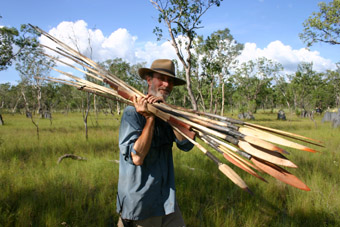
Rolf de Heer on location for Ten Canoes
image courtesy Palm Pictures
Rolf de Heer on location for Ten Canoes
WE NEEDED A BOOK ON ROLF DE HEER. BY COMMON CONSENSUS HE IS THE MOST ACCOMPLISHED, INDEPENDENT AND IDIOSYNCRATIC DOMESTICALLY BASED AUSTRALIAN FILMMAKER WORKING TODAY. HE’S MADE A DOZEN FEATURES. HE’S WON MAJOR PRIZES AT VENICE AND CANNES. HE RUNS WHAT IS PERHAPS AUSTRALIA’S MOST SUCCESSFUL INDEPENDENT FILMMAKING COMPANY, VERTIGO PRODUCTIONS. IN SHORT, WHERE THE CAREERS OF OTHER LOCALLY BASED ‘AUTEURS’ HAVE DRIED UP QUICKER THAN YOU CAN SAY “ABC”, DE HEER HAS FLOURISHED AS AN INDEPENDENT IN THIS COUNTRY FOR 20-PLUS YEARS.
So why haven’t we had a book on him until now? At a time when vast sections of film libraries are being filled with books on Bollywood and Chinese cinema, why is this most inspiring of local filmmakers neglected? Ignoring the most obvious reason (that most Australian film scholars aren’t interested in Australian cinema) young Brisbane-based author D. Bruno Starrs suggests a different answer in his new short book Dutch Tilt, Aussie Auteur: The Films of Rolf de Heer. For Starrs, the most pertinent barrier to the Australian film public’s appreciation of de Heer as an auteur is the radical variety of his oeuvre.
Historically understood, an auteur is supposed to make a certain kind of film (a “Bergman”, a “Tarantino”) that bares the unmistakable stamp of the creator’s vision. The problem with de Heer’s work, Starrs points out, is that the director presents us with a thinly linked array of “projects”, each with very different narrative, stylistic and thematic concerns. Though some of de Heer’s films beg comparison (The Tracker and Ten Canoes), most are completely dissimilar (take Bad Boy Bubby, Epsilon and The Quiet Room for example). Further complicating matters is the fact that de Heer denies authorship of at least one film, Dance Me to My Song, which he attributes to the film’s scriptwriter and lead actor Heather Rose.
Starrs also notes that de Heer often makes movies for “no other reason than to keep a roof over his family’s head.” Where the auteur proper keeps crews waiting months for the right light, de Heer unabashedly compromises his films to fit a given circumstance, often restructuring his narratives around a feasible shooting schedule, budget or casting process. It’s almost as if de Heer is entirely unconcerned with making ‘Rolf de Heer films.’
In light then of the looseness of de Heer’s work, how do we (and should we?) understand Rolf de Heer as an Aussie auteur? This is the question that guides Bruno Starrs’ brief sketch of de Heer’s oeuvre.
For Starrs, the links between de Heer’s films are to be found not so much in their technical characteristics as in their unconscious preoccupations. Though noteworthy for his distinctive use of sound (specifically, his unusual use of a character’s subjective auditory experience) de Heer’s authorial signature is, in Starrs’ view, to be located in the unconscious ways the director perceives his Australian environment. A Dutch born immigrant who came to Australia as an eight-year-old (after several years in Sumatra) de Heer carries, Starrs suggests, an implicitly marginalised perspective on his narratives. De Heer’s films reflect what Starrs calls a “Dutch tilt”, a strangely askew, semi-evident eccentricity, the view of a gentle stranger who talks funny, quietly observing an Anglo-Australian culture of male aggression and suburban conformity.
Pointing to the “unlikely protagonists” of films like Bad Boy Bubby, Dance Me to My Song and The Quiet Room, Starrs succeeds in demonstrating how de Heer engages his audience in an experience of marginalisation, of seeing and hearing what the white Australian world looks and sounds like from the outside. In a different way, Ten Canoes (certainly one of de Heer’s best films) offers Australian audiences an experience of difference and marginalisation by telling its story in the indigenous Ganalbingu tongue, in Ganalbingu narrative structure, with Ganalbingu characters. In this case it’s the non-aboriginal Australians who are marginalised from the real Australia.
Starrs notion of de Heer’s “Dutch tilt” provides an interesting concept with which we can understand the director’s films relative to their national context. Unfortunately, the “Dutch tilt” theory remains seriously undercooked. Though a talented writer, Starrs is also conspicuously flippant. Instead of dexterously elaborating his key idea by charting de Heer’s authorial signature, Starrs makes do with a series of discrete and often embarrassingly brief essays in which the discussions remain consistently unrelated to the central thesis. The brevity, disjointedness and pedestrian nature of Starrs’ discussions ultimately make this a negligible study at best, slap dash at worst. It’s a shame really. We needed a book on Rolf de Heer. We need another one.
D Bruno Starrs, Dutch Tilt, Aussie Auteur: The Films of Rolf de Heer, DM Verlag, 2009, 104 pages, ISBN: 978-3-639-16834-1
RealTime issue #95 Feb-March 2010 pg. 22
© Tom Redwood; for permission to reproduce apply to realtime@realtimearts.net
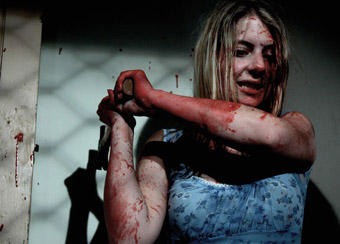
Cassandra Kane, Family Demons
AS EVER, FILMMAKERS, CRITICS, COMMENTATORS AND COLUMNISTS ARE VOICING OPINIONS ON THE LACK OF LOCAL AUDIENCES FOR AUSTRALIAN FILMS. THESE ARE FAMILIAR ARGUMENTS ABOUT THE NEED FOR FILM CULTURE, NATIONAL IDENTITY AND, INVARIABLY, TAXPAYERS’ MONEY SPENT ON ‘UNPOPULAR’ FILMS. THESE DEBATES DEPEND UPON SPECIFIC NOTIONS OF IDENTITY, CINEMA AND AUDIENCES THAT NEED TO BE EXAMINED.
Inside Film counts 37 Australian features in its summary of 2009’s box office figures (BrendanSwift, Box Office: 2009 Wrap, Monday 11/01/2010), while in his article “Nowhere Near Hollywood” published in The Monthly (Dec 2009-Jan 2010), Louis Nowra counts “over thirty.” Both articles include the same titles (Samson and Delilah, Lucky Country, Mao’s Last Dancer, My Year Without Sex, Beautiful Kate and so on). These are the films that have informed the debate on the current state of Australian film.
But these are not the only Australian features of 2009 and to focus on them alone is part of the failure of a discourse that simply omits that which it does not like.
There is an entire hidden cinema which exists, and even flourishes at the margins of Australian film culture. Premieres in 2009 included Dominic Deacon’s Bad Habits, David De Vries’ Carmilla Hyde, Nathan Christoffel’s Eraser Children, Richard Wolstencroft’s The Beautiful and the Damned, Jon Hewitt’s Darklovestory, Ursula Dabrowsky’s Family Demons, Stacey Edmonds and Doug Turner’s I Know How Many Runs You Scored Last Summer and Martyn Park’s 1 and 0 nly [sic], amongst others (the Wolstencroft and Hewitt films had screened previously but as works-in-progress). These and many other Australian feature films screened at the Fantastic Planet Film Festival, A Night of Horror Film Festival, the Melbourne and Sydney Underground Film Festivals and the Revelation Perth International Film Festival. In most cases they played to packed houses and receptive audiences. Few, if any, of these films will receive a domestic cinema release, but most will screen widely at international film festivals and hopefully all will get domestic DVD distribution.
These films, many of which are low-budget genre works, are absent from the debates about Australian cinema, yet they are also representative of current domestic cinema. What is different about them is that they are often independently produced and seem largely ignored by cultural gatekeepers. Not Quite Hollywood may have been a success, but it has allowed genre, cult and exploitation movies to be framed as simply belonging to the cinematic past, rather than being a living phenomenon.
The vagaries of government funding mechanisms are not the concern of this piece. True, filmmakers need to take risks and make bold films rather than aiming to appease bureaucrats or satisfy the pre-defined selection criteria of funding bodies. Film is an artform that accommodates the cinema classic and the low budget exploitation genre movie. Other than a framing dictated by critics and markets there is no more or less intrinsic value to any singular form of cinema. To draw a divide between ‘high’ and ‘low’ forms of cinema is to create a false distinction.
The ‘most popular’ films of the 2009 box office were event movies, mass market products such as Avatar, cross promoted not simply as films but as ‘entertainment phenomena.’ The top ten also included numerous sequels (Angels and Demons, X-Men Origins: Wolverine and the ongoing franchise represented by Harry Potter and the Half Blood Prince), with a built-in audience who predominantly identify a trip to the cinema with consumption of pleasurable eye candy.
Australian cinema is not, and should not try to emulate mainstream Hollywood, the success of which is linked to the marketing of spectacle and the existence of the star system as much as to the creation of cinema. The success of Hollywood films can also be attributed to their market dominance; mainstream films play at multiplexes in every suburb, while most domestic films (and non-American foreign films and indie works) screen at just a handful of mostly city-based cinemas. Even if audiences are aware of locally produced films—and the marketing can be woeful—rarely is there a cinema screening the work near them.
The problem is that many self-appointed commentators view the success of a film as purely financial and there has been an ongoing emphasis on box office receipts. When journalists write that there are “too many costly box office flops using taxpayer handouts” (Fiona Hudson, Herald Sun, December 2009), they are working on the assumption that a film is simply designed to generate income, but cinema’s value is cultural and aesthetic.
Films exist within a multiplicity of simultaneous discourses: aesthetic, historical, cultural and social. What may once have been deemed a failure may subsequently be re-evaluated and become part of a wider, collective notion of a cinematic canon. Two Australian examples include the ‘unsuccessful’ Wake In Fright (Ted Kotcheff, 1971) and the once banned Pure Shit (Bert Deling, 1975). Both films have been recently reissued, screened at festivals and subsequently found a home on DVD, finally recognised as important moments of Australian cinema more than 30 years after they were ‘forgotten.’
There have been some calls to make films that audiences want to see, to move to a market-dominated model, but there is no single homogenous audience and popular tastes cannot be second-guessed. Moreover, satisfying an audience implies simply making them ‘happy’, but the experience of film viewing need not be simplistic. The supposed “monotonous bleakness” (Nowra) of films may be seen as indicative of the desire to tell stories that exists beyond feel-good cliché.
The belief that a work should have mass audience appeal is also misguided. If films were made simply on the basis of box ticking exercises and consultations with would-be audiences in order to satisfy the largest number of people, nothing of any worth would be made, just unsatisfying grey slop. Across all forms of cinema, mass audiences have on occasion stayed away from ‘sure fire’ hits (for example Catwoman) and have gravitated to small films that initially appeared to be made only for a specialist audience. If you asked an audience in 1992 if they wanted to see a thriller with a non-linear narrative and no female characters, that emphasised oblique conversation over action and had a soundtrack made up of early 70s rock music, few people would have been interested. And yet Reservoir Dogs was a hit.
What is needed is a re-evaluation of cinema, an acknowledgment of genre and an appreciation of individual signature-driven works. It is also essential to understand that films may not find an immediate audience, especially if the screens are dominated by a handful of Hollywood big budget titles, but this does not devalue a less than popular film. Discussing audiences and economics is one way of examining cinema, but satisfying the mass market and counting profits is not the only reason for making film.
RealTime issue #95 Feb-March 2010 pg.
© Jack Sargeant; for permission to reproduce apply to realtime@realtimearts.net
ON A HOT, LATE SUMMER AFTERNOON IN MILDURA, ROBYN ARCHER JOINS THE LOCALS TO HEAR BEETHOVEN’S PIANO SONATA OPUS NO 110 PLAYED ON THE ARTS CENTRE’S NEW STEINWAY, FOLLOWED BY SHARING FINE REGIONAL FOOD AND WINE: “THIS IS THE AUSTRALIA I ENCOUNTER ON AUSTRALIA DAY JANUARY 2009. MANNING CLARK ASKED, ‘WOULD THE PRICE OF SURVIVAL AS A PEOPLE BE THE SHEDDING OF THAT ATTEMPT TO PRESERVE A EUROPEAN SOCIETY?’”
Nineteenth-century commentators had assumed the Australian climate would severely undercut cultural ambitions. But Archer finds herself enjoying the rich European heritage on offer, adapted to and drawing on an Australian landscape and culture: “This seems less a conscious attempt to preserve European society than just the way it is evolving in the more compassionate and world-welcoming Australia which has at last greeted the new century.”
She pinpoints the synthesis of the European (and, elsewhere, other cultures) and Australian when she writes, “Drinking honey wheat beer, watching the Australian Open in the brewery, I am the early savage Manning Clark wrote about. The difference is that I am at the same time, working on a Brechtian cabaret I have written called Tough Nut, which I will start to direct at Carnegie Mellon University, Pittsburgh, in less than two weeks’ time.”
In the 10th Mannning Clark Lecture, Archer is concerned that we Australians have yet to grasp the significance of our cultural mix, of Reconciliation, of just what is entailed in our survival—economic, environmental and cultural. February 1, she’s on a flight to Perth watching Baz Luhrmann’s Australia.
* * * *
This is simply perfect. I have been resisting seeing Baz Luhrmann’s epic. I saw trailers on Qantas flights for months. I didn’t like the look of it. Then [there were the] indifferent or bad reviews and friends who hated it and some pretty ugly Nicole-bashing by the Poms…Cinema super-stars may be wealthy enough to be able to endure those blows—both Baz and Nic are on to their next projects as the Academy Awards Ceremony showed—but somewhere it has to hurt, and I don’t hold with hitting below the belt. This was the right place and the right time to see this film. No investment—passive.
The retro intention of Australia is obvious from the opening titles—the motto in English and the kitsch coat of arms. You can’t really bash up a fillum for doing what it says it intended to. You can criticise the director’s intent, and you can perhaps debate the use of gigantic public funding (Tourism in this case) for a folly—but that’s something different.
Of all the things I want to say about this film, I want to go to the very end first; because the greatest surprise in Baz Luhrmann’s Australia is the final moment, when the film wants to play on the heart strings and force our emotional response.
The beautiful Aboriginal boy is about to run slow-mo after ‘King’ George, his Aboriginal elder or spirit. Lady Ashley can’t bear to let him go, Hugh’s chest heaves in sympathy but knows it must be so… ok, ok it’s kitsch and clichéd—Baz stated this clearly at the start. But, lo, what do I hear? It can’t be true. But yes, thine ears do not deceive thee. It is so: the ultimate emotional crunch moment of this film boldly entitled Australia is scored with Elgar—the Enigma Variation we all know so well, Number 9, ‘Nimrod.’
I am gobsmacked by this more than anything else in the film, I suppose because I didn’t see it coming, no-one wrote about it, no-one warned me. I am infinitely more surprised by this than by the much discussed wobble board which is featured for all of 10 seconds. Elgar! Elgar who himself was so dismayed that his pomp and circumstance had been usurped through official channels to become the ultimate jingoistic jingle of the Empire—Land of Hope and Glory.
Here his Enigma was a million miles away from being enigmatic. In order to bring the film to an emotional ending, Baz needed the heart and soul of Empire. Despite more than a hundred years of splendid music from Australian composers, despite a legion of them working in Australia and throughout the world today, the makers of this film resorted to the heart and soul of Empire. If ever there were a reason to move towards an Australian Republic then this is it.
Nothing could be more culturally revealing of our own sense of nationhood than this choice. Even if I give those responsible for the soundtrack the benefit of the doubt, this one is hard to reason. It is for me one of the queerest and kitschest films of recent years…and the caricatures are as much in the music as they are in the vision. The 10 seconds of wobble board are no different from the echoes of “Big Country”, the Marlborough Man, “The Magnificent Seven”: we get a mouth organ, some dubbed lyricism meant to be the kid’s dreaming leitmotif, a bopping dance band at Gov house, Waltzing Matilda and, of course, “Somewhere Over the Rainbow” in multiple versions. This film is a queer creation. The bulging beefcake of Hugh Jackman’s chest, Nic’s androgynous form in contrast to those of the Aboriginal women, the beautiful and beautifully groomed young ‘creamy’ boy—and Judy. Actually, this film is as camp as a row of tents. The ‘China man’ (reference The Hawaiians) plays “Rainbow” on a ukelele (reference the more recent uke version which references the Tiny Tim version) and we hear this just creep in again at the end as we roll to end credits.
So, it is not the Tiny Tim recording which at least we can understand in Australian terms of The Yellow House and Martin Sharp and his encouragement of Tiny Tim’s memorable marathons years later. The version the film uses just happens to be the one which gave us one of the strangest moments of the 20:20 summit. No sooner had we arrived and sat down in the Great Hall in Parliament House, all of us primed and ready to think and give of our best ideas, than we were asked to sit and receive for a moment. The first feed was a video report on the Youth Summit which had preceded us. What was the soundtrack to that video? Louis Armstrong singing “What A Wonderful World” and that recent version of “Somewhere Over the Rainbow.”
Where was any single person involved in that video, or signing off on it, who might have asked ‘why wouldn’t we use an Australian song here?’ The following day someone spontaneously sang Kev Carmody and Paul Kelly’s “From little things big things grow”—why not that?
There are literally hundreds of songs that could have been used—just as there are for the ending of the film Australia—but no. The choice was music which is not only stirring (we all know that—we can all just about say where we were, when and how we first heard the Enigma Variations) but goes much deeper. It is English—it sings England—and somewhere we all know that. Some have argued that most of the audience would not know, and that even the makers would not understand the significance. This is exactly the point; unconsciously sticking with old world security stops us from really being our own.
It is peculiar how often Australian composers and composition are ignored. Music, past and present, of every kind and at every level is one of our greatest artistic endeavours and accomplishments. Why is it so left out of the conversation?
The soundtrack of Australia is pastiche—saccharine strings, thumping timpani—just as the director ordered, and in line with his stated intent. Hugh’s sculpted chest is a dead ringer for that of Charlton Heston in one of my very favourite films, The Naked Jungle in which a mail-order bride (Eleanor Parker) fetches up in the Amazonian jungle to be a planter’s wife. In fact it is she who stares down his apparent coldness saying “an instrument is better when it is played.”
The opening sequences of Australia are pure Blue Lagoon. Indochine makes an appearance, as does Out of Africa (the adventurer who just has to be off and away regularly and leaves the little lady to struggle with nature at home), as well as Gone with the Wind and its copy Tap Roots, starring Susan Hayward and Van Hefflin in lieu of Vivien and Clark. All this is well done in terms of pastiche and, for a fan of the genre, which I am, enjoyable.
Now, if it had only been called Lust in the Bulldust or Top End Tales, Sunburnt Country or Wide Brown Land, even Darwin, fewer bright folk might have been less upset. Despite the odd ‘below the belt’ she also gives now and then, I’m usually happy when Germaine (Greer) dares to give something a walloping: she often says things that everyone else is too timid to dare. But I also understood Marcia’s (Langton) defence of the film: the attempt to include a Stolen Generation story in this matinee movie tribute may well be genuine, and if you accept the pure camp milieu, then Germaine’s objection to scrubbed clean Aboriginal people is beside the point—everything in this film is airbrushed.
And as offensive as many have found it, there are just as many people in Kazakhstan offended by Sacha Baron Cohen, and I expect a number of Vietnam Vets by Tropic Thunder. If Robert Downey Jr can be not only praised, but also nominated, for blacking up, then why shouldn’t Ursula Yovich for Baz? Well, I’m being flippant, and to tell you truth even I was a bit taken aback by that use of what was once known as Max Factor Egyptian Number Nine. But, if the retro thing is consistent, there are precedents from Joan Collins to Debra Paget, Ava Gardner to Sir Larry and even, in the very flesh, Frank Thring—the very last word in colonial camp.?But we know why it offended: because this film was not promoted or anticipated as kitsch campery and airbrushed fantasy. The title, Australia, and the endless promos on Qantas and elsewhere else had us believe this would be something we, as Australians, could be proud of—an emblematic clarion call to the landscape we adore. Instead, we suddenly started seeing the trailers and felt a bit like that poor sod on Lesbos: “I’ve got nothing against gay women,” he says, “and they’re very good for our tourism, but I can’t call myself a Lesbian, yet that’s what I am—give me back the title of my identity.”
What the film Australia does is demonstrate just how strong, how subterranean, our ties to our colonisers remain. They are terrifyingly deep, as this cinematic moment proves. Deciding at the last moment that what would define the film’s soundtrack would be Rolf Harris’s wobble board was, in the end, just another kitsch effect. The Enigma is England.
[Archer later recalls that in a scene in Ang Lee’s Lust Caution, Elgar’s Enigma, is heard to very different effect from an onscreen record player used in the wings of a student staged play]
The difference is that in Lust Caution there is no mistaking the intent. Firstly we never hear more than a few scratchy seconds—just enough to recognize it—then it skips and jumps, comes back in a few bars to the next bit of the scene. Secondly, the easy access of the students to this vinyl underscores the British presence in Hong Kong—it is a British Colony. Thirdly the students are working within one colonised part of China to ensure that the rest, having fought and won its battle with Britain, does not go under to Japan. But most importantly, we in the cinema see that this piece of music is deliberately used to stir the play’s audience, who remain as ignorant of the ironies of using Elgar, as is the Australian audience ignorant today of the ironic (even tragic) manipulation inherent in its use at the end of the film Australia.
The difference is that Ang Lee’s intent as a filmmaker is to reveal the musical manipulation and irony to us, while Baz keeps his audience in the culturally colonised dark in order to manipulate emotion which, even more ironically, is supposed to be reinforcing the anti-colonial spirit of the film’s ending the Aboriginal boy reluctantly freed by the English woman to follow his dream(ing). Well, that triumphant and moving moment of partition clearly hasn’t quite happened yet, and the film’s inability to escape the deep and long clutches of colonisation hasn’t helped.
* * * *
Archer says that whatever we do next, about a range of issues, including becoming a republic, “we should not doubt that it will be a matter of survival. Perhaps not whether we survive or not, but the way in which we survive, with how much strength and dignity, and to what degree an authentic sense of national identity is nurtured, as opposed to that which is myopic, naive and kitsch.”
As for art as a substitute for faith, “Alas, I can’t claim Baz’s Australia as a source of spiritual uplift or enlightenment. Once I got over the initial shock of so much camp (no critic, no commentator had warned me—and that is one of their jobs), I quite enjoyed it as a popular entertainment, an exercise in referencing earlier forms. But given the musical betrayal in its final moment, it’s hard to forgive, especially given the title. This is the price of a false path to survival—the one that does not want to, or cannot, change. While the compassion in this film for the Stolen Generation may be real, and indicates an authentic change which is thankfully at last in the wind, the music in the end is deeply tied to an unreconstructed dependency on our colonisers.”
This article is excerpted from the 10th Manning Clark Lecture, The Price of Survival, presented at the National Library of Australia, March 3, 2009 with the permission of the writer; www.manningclark.org.au/html/Paper-Archer_Robyn-The_Price_of_Survival.html
RealTime issue #95 Feb-March 2010 pg. 23
© Robyn Archer; for permission to reproduce apply to realtime@realtimearts.net
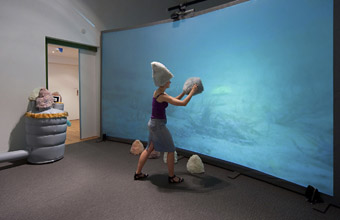
Metazoa, Angela Main, Super Human Exhibition, RMIT Gallery
photo Mark Ashkanasy; courtesy RMIT Gallery
Metazoa, Angela Main, Super Human Exhibition, RMIT Gallery
A RANGE OF MEDIA ARTS EVENTS, THE LEONARDO EDUCATION FORUM, SUPER HUMAN: REVOLUTION OF THE SPECIES AND RE:LIVE MEDIAARTHISTORIES CO-HABITED IN MELBOURNE DURING LATE NOVEMBER, AIMING TO ACHIEVE A CRITICAL MASS OF ARTISTS, THEORISTS AND CURATORS. SUPER HUMAN WAS THE AUSTRALIAN NETWORK FOR ART AND TECHNOLOGY’S INTERVENTION INTO QUESTIONS OF BIOLOGY AND FUTURITY, COMPRISING AN EXHIBITION, MASTERCLASS AND GENERAL SYMPOSIUM. RE:LIVE WAS THE THIRD MEDIAARTHISTORIES CONFERENCE, CAPITALISING ON THE GROWING BODY OF RESEARCHERS AND SPEAKERS WHO ARE ATTRACTED TO MEDIA ARTS DISCOURSE.
A great sense of disconnection permeated the official discourses of Re:live and Super Human (I didn’t get to the Leonardo Education Forum). The gap between what guests and attendees were saying on stage and then saying over coffee, or lunch, or walking between events, was more than merely disquieting—it was just plain weird. Given the openness of the audience to meta-analysis of the arts generally, more in-depth criticism of particular programs or models would have been welcome. The timid public accounts—especially from Australian artists, curators and academics—were especially striking in the still-raw discussion of the dissolution of the Australia Council’s New Media Arts Board. It seemed that little hope is invested in the Council’s pivot to the new “arts content for the digital era” strategy, though some discussants in the question sessions were articulating the board’s removal as bearing significant creative fruit.
In both events, the lived practice of history re-emerged as a kind of demilitarised zone between codified (and historicised) media art and the ever-refusing cultures which fail to engage with and hence misunderstand it. While work and institutions which speak to archive practices are being rewarded, Oliver Grau’s presentation at Re:live indicated many archives were succumbing to financial and other pressures. He asked whether or not the MediaArtHistories body could be a catalyst for preservation strategies. The question is going to become more and more explicit, with the ephemerality of new media now embodying another generation gap—one of ubiquitous-yet-closed platforms clashing with open-but-unpopular methods and protocols.
Other important questions concerning the generation and curatorship of work through arts funding circulated at both events. Most commonly, how do artists attract funding to work that doesn’t fit into the categories with which funding bodies assert themselves? Just as importantly, how do artists conceive of new media artwork when the only field-specific bodies are in every sense more risk-averse and conservative than the funders of traditional arts?
In many ways, the Super Human symposium addressed its concerns well, and the focus of speakers presumed investment from the audience. Some speakers, such as Natasha Vita-More—firmly of the mind that all life extension techniques and procedures should be pursued and promoted in order to avoid death—generated palpable disquiet that was far more fruitful for discussions than rote recitations of academic squirreling. Barbara Maria Stafford’s keynote was a highlight, connecting ideas across vast distances and elucidating a call for seismic shifts in approaches to art history and especially the task of the critic.
ANAT had obviously put on a very high-cost event, and the range of international speakers began to explain the high costs of attending. More than a few attendees, myself included, are beginning to wonder whether the Australian Centre for the Moving Image (and by extension, Federation Square) is the most viable place for such public events—certainly when the costs associated with events there far outstrip the convenience.
Early on at the Super Human curatorial masterclass sessions, Mike Stubbs (director of FACT, Foundation for Art and Creative Technology, Liverpool, UK, which will host the next MediaArt History conference) provided the answers nobody wanted to hear to these two questions. Stubbs’ impassioned pre-emptive defence of FACT and other national scope mega-bodies openly celebrated a risk-averse model of new media in favour of “publicly visible work” that can “extend the reach of these images.” On its own, his presentation would have sat reasonably well if a little controversially, as Stubbs had a tenure at ACMI overseeing excellent public exhibitions such as White Noise.
However, the speaker immediately prior on the same panel, artist Jens Hauser, had delivered a very well-received talk on producing work which explicitly complicates the ability to generate images at all: work that is neither combinable into a flickr set or Facebook post; nor the poster child for the conservative and static neologisms of theorists. Hauser’s work on the sk-interfaces exhibition in Liverpool in 2008 and a string of prior events concentrated on curating highly (culturally, materially) sensitive works and in one case, encountering a gallery that baulked, literally at the last minute, at the display of a work that could invite litigation—Jun Takita’s bioluminescent brain sculpture, Light only Light. It was interesting that Mike Stubbs was the gallery curator who made the call to retract the work and use a non-biologically active substitute. It is clear that Hauser and Stubbs are friendly and the issue is not the source of tension, but the significance of the discourse was left entirely implicit, to be picked over in between sessions rather than built upon and expanded.
One of most engaging speakers in the masterclasses was Sarah Cook (speaking largely as CRUMB) who asked the audience to help address a curatorial problem with an ongoing program of works that had not found an audience. The openness of such a presentation was precisely what many attendees had paid to join the masterclass for—actual work on projects, rather than the usual panels. Erich Berger’s presentation was delightfully specific, rapidly dissecting the difficulties of putting on a series of shows in Laboral, Spain, culminating with the deliriously expansive Homo Ludens Ludens show in 2008.
Re:live’s focus on history was hinted at everywhere, but unfortunately organisers resisted the urge to frame issues of decay alongside continuance—decay of works, decay of institutions, and most importantly, the decay of audiences and imperatives. Sean Cubitt, bravely filling a hole left by one of several last-minute cancellations and Skype hysterics (will there ever be an exhibition comprising the mangled faces and victimised voices of this interminable program?), chose to frame the conference and open up to audience questions concerning the direction of the MediaArtHistories concept/group more generally. A common point of agreement between generations and professions is that there was a great deal of theory being produced (and sold) and far less careful description and preservation work.
The most glaring omission from both events was mentioned by an audience member right at the close of this informal debrief; people under 30 were barely represented in any of the events. However someone wishes to defend or historicise media arts in Australia, it will need to increasingly account for the shift away from large-scale institutional media arts events and equally, a shift upward in artist age. Events such as Electrofringe and the minor exhibitions of tactile animations from groups such as Tape Projects constantly filling city media galleries (of which there are now a fair few, with a new gallery, ScreenSpace, in Melbourne) seemed to have no role to play in the history taking shape, not even as disappointments or diversions.
The risk of an academic history is that rather than looking at the fine grain of particularities, credit is given only where it is easily coded—such as in essentially closed networks of new media artists and writers. At both events it was when openness was emphasised that activity seemed the most possible—an openness that includes a fundamental receptivity to the notion that some forms and practices are organically diminishing and others, yet to be named or understood, have no history.
Symposium proceedings will be published in Second Nature: the International Journal of Creative Media in March 2010; secondnature.rmit.edu.au
ANAT Super Human, Revolution of the Species, Symposium; www.superhuman.org.au, BMW Edge, Federation Square, Nov 23, 24; Re:live, Third International Conference on the Histories of Media Art, Science and Technology, www.mediaarthistory.org; BMW Edge, Federation Square, Melbourne, Nov 26-29
RealTime issue #95 Feb-March 2010 pg. 25
© Christian McCrae; for permission to reproduce apply to realtime@realtimearts.net
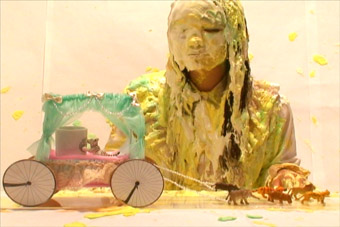
Crazy Hat & Long Ears, Our Full Courses
courtesy the artists
Crazy Hat & Long Ears, Our Full Courses
SPOOKY ACTION AT A DISTANCE, CURATED BY AMELIA GROOM, PRESENTED THE WORK OF SEVEN YOUNG ARTISTS FROM JAPAN EXHIBITING FOR THE FIRST TIME IN AUSTRALIA. COMMON TO THE WORKS IS A SENSE OF PLAY—GENUINE AND COMMITTED PLAY IN WHICH NAIVETY ALLOWS FOR TOTAL FREEDOM. APTLY TITLED THE WORKS OFFER VISIONS OF THE WORLD WARPED, EXPANDED AND MAGNIFIED, YET MOSTLY BENIGN—WE WITNESS FROM A COMFORTABLE DISTANCE.
Silver & Gold by Kiiiiiii is in fact nothing but play as the girlband duo presents video clips for their songs including a cutesy thrash version of ‘Heads, Shoulders, Knees and Toes.” It’s reminiscent of a community TV kids show with a few frenzied gig shots thrown in—think Sailor Moon meets Peaches on Sesame Street.
The work of Crazy Hat & Long Ears also expresses a childlike abandon but their thematic of food and eating offers more conceptual depth. Our Full Courses presents a series of vignettes in which food is remodeled, animated and eventually splattered all over the protagonist—an Alice in Wonderland figure who has been wandering around eating vegetables from posters on walls, feasting on bacon and extracting green milk from puppet cows. The scenarios are vivid yet the tone of the work is quiet and underplayed and the sound track of soft humming and crunchy foley renders the work particularly intriguing.
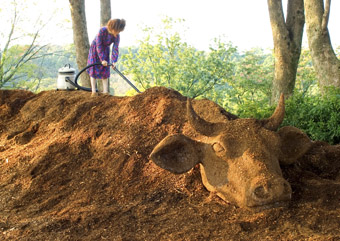
Ine wo Ueru hito, One day, I meet… Part 1
courtesy the artists
Ine wo Ueru hito, One day, I meet… Part 1
While the work of the duo Ine wo Ueru hito is similar to Crazy Hat & Long Ears in its use of absurdist scenarios they offer a slicker and more mature vision. One Day, I Meet… parts 1 + 2 are linked by a woman in purple flowered dress, face obscured by hair, patiently vacuuming outdoor spaces. Part one is particularly engaging as scenes are intercut with sculptures of strange stuffed hybrid animals—a lamb with a unicorn’s head, a squirrel with hypodermics attached—rotating in an eerie Mathew Barney-esque white room. A particularly striking moment sees the woman vacuuming a large mound of dirt to reveal a giant sculpture of a bullock. While there are darker moments (a grotesque face made of chocolate grinding its teeth; the woman in silhouette repeatedly thrashing something with the vacuum nozzle), the atmosphere is curiously ambivalent giving the work of Ine Wo Uero Ito a sense of detachment more often felt in dreams.
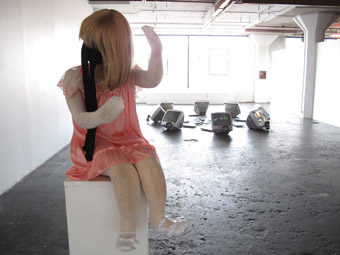
installation by KATHY, Black & Blue Gallery, Surry Hills
courtesy the artists
installation by KATHY, Black & Blue Gallery, Surry Hills
In Daydream, KATHY also exploits an ambivalent darkness. Three performers in quaint evening dresses, blonde wigs and with black pantyhose over their faces (dangly legs still attached) conjure an amusing analogue recreation of the faceless ghosts of Japanese horror. While there is no blood splatter, KATHY use duration to generate tension, as we see the trio continuously stumbling and falling toward the camera from the end of a long street, or twirling compulsively on the furniture in a fancy apartment. These girls are definitely possessed, but by what remains a mystery.
In the works of Tetushi Higashino, Yukihiro Taguchi and Daito Manabe the sense of play turns what might be described as boy’s-own: the kind that involves kit sets from Dick Smith (or Tokyo’s Electric City). Tetushi Higashino’s KINE is a collection of kinetic constructions: a billowing plastic bag attached to an oscillating fan; a small square of Astroturf spinning slowly in a field of grass; a moustache (a Dali reference perhaps?) sliding backwards and forwards across a motorised track. The works are simple, verging on the banal, yet this simplicity suggests a contemporary animism, drawing attention to the essential ‘thingness’ of things.
Yukihiro Taguchi’s activation of objects is particularly impressive. Using stop motion animation, he literally vivifies his Berlin apartment in Nest: the furniture moves around, rooms are totally covered in paper and the bathtub fills to overflowing with foam. Even more amazing for the interplay of object and environment are Moment 1 & 2 in which the floorboards of a gallery are pulled up and ingeniously reconfigured both inside the gallery (creating a nightclub, a banquet hall) and outside where they wander the streets of Berlin, creating temporary public art structures. Taguchi’s work is exceptional in its attention to detail and scale not to mention the sheer labour of its execution.
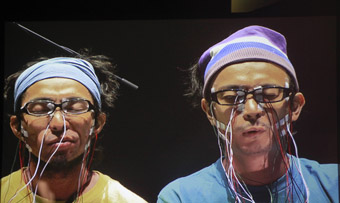
Daito Manabe (with Shizou) performing live at Big In Japan, CarriageWorks, Dec 2
photo Daniel Boud
Daito Manabe (with Shizou) performing live at Big In Japan, CarriageWorks, Dec 2
Daito Manabe’s video documentation of recent experiments looks potentially malevolent, as he faces the camera with electrodes stuck to his face, but in reality it’s more play. Creating music compositions (of the white noise glitchy beat variety) the electrodes stimulate the muscles in the face, essentially making it dance. This reaches its zenith when the screen shows 16 willing human guinea pigs, whose wired-up faces spasm in unison—a truly hysterical sight. In another experiment Manabe reverses the flow making his facial ticks trigger the sound. In these works (which he also performs live) interactivity reached a new extreme.
The artist collective Chim↑Pom also tends towards the extreme. The 45 minute DVD, Super Rat and Other Adventures, is a collection of the group’s antics around Tokyo. Their strongest action, documented in several locations, is one where they ride the streets on a scooter broadcasting crow calls and waving a stuffed bird, which bizarrely tricks the multitude of real crows found around Tokyo to flock and follow the team—instant Hitchcock over Shibuya. In another segment they catch rats late at night and dress them up like stuffed Picachus (from Pokemon). In another scene, in Bali, one of the group works in the rubbish dump while a glamorous female flies in a chartered helicopter, littering from above. Many of the other activities, including a guy blowing into his foreskin with a straw to make his penis dance, look like naughty drunken party tricks, but even here there is something about the childlike abandon with which they are undertaken (given the context of such an extremely polite society in which it is considered rude to eat on the streets) that seems genuinely transgressive.
Spooky Action at a Distance, the first time curatorial project for Amelia Groom, offered a fascinating selection of works introducing the practices of some very interesting young Japanese artists. (It’s worth a google to check out the other aspects of their installation and performance practices). The strong curatorial logic of the collection and the resonances that emerged between the works—childlike freedom, playful transgression and animation of the banal—presented a very particular kind of surrealism, a dreaming that feels…well…essentially Japanese.
Spooky Action at a Distance. presented as part of Kirin’s Big in Japan, curator Amelia Groom; Black & Blue Gallery, Sydney, Dec 4-19, 2009; www.biginjapan.com.au
RealTime issue #95 Feb-March 2010 pg. 26
© Gail Priest; for permission to reproduce apply to realtime@realtimearts.net
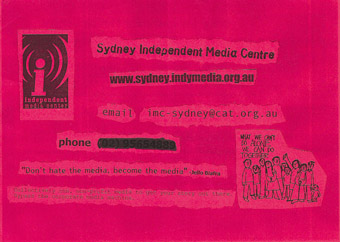
Indymedia flyer
courtesy Zanny Begg
Indymedia flyer
JUST OVER 10 YEARS AGO SYDNEY MEDIA ACTIVISTS RUSHED TO FINISH A VERSION OF ACTIVE SOFTWARE WHICH WOULD ENABLE THE FIRST INDYMEDIA SITE TO GO LIVE IN TIME TO COVER THE PROTESTS AGAINST THE WORLD TRADE ORGANISATION MEETING IN NOVEMBER 1999. AS RIOTS ERUPTED IN DOWNTOWN SEATTLE, MILLIONS OF PEOPLE LOGGED INTO THE NEW SITE LAUNCHING A MEDIA NETWORK WHICH REPORTEDLY RECEIVED MORE HITS IN ITS FIRST WEEK THAN MEDIA HEAVYWEIGHTS SUCH AS CNN.
“It was the heyday of globalisation, the high point of the internet boom and the last gasp of the New Economy: the WTO ministerial in Seattle was meant to celebrate the advent of a corporate millennium extending ‘free trade’ to the furthest corners of the earth. Nobody on that fall morning of Tuesday, 30 November 1999, could have predicted that by nightfall the summit would be disrupted, downtown Seattle would be paralysed by demonstrations and a full-scale police riot would have broken out…Nobody, that is, except the thousands of protesters who prepared for months to put their bodies on the line and shut down the World Trade Organization.”
Brian Holmes, nettime posting November 2009.
Ten years later the Indymedia network, while relatively small and fragmented in Australia, has grown to over 150 outlets around the world and has become a global phenomenon based around the simple slogan: “don’t hate the media, become the media.” A decade on it is now possible to see that Indymedia not only helped establish a global media service it also helped forge a connection between digital innovation and activism which has had a lasting impact on culture and the net.
activism goes digital
ABC social media producer John Jacobs, a member of the Jellyheads anarchist media collective whose warehouse was an infamous performance venue in the 90s, explains that the impetus for Indymedia grew out of attempts by people involved in Jellyheads, Critical Mass and the Reclaim the Streets activist communities to produce a hardcopy calendar to share news and events. Jacobs says that he knew he “never wanted to look at a photocopying machine again” when he met up with a physics student at Sydney University, Matthew Arnison. Arnison and Andrew Nicholson collaborated in writing the code for Active Sydney, a website which enabled people to share events, news, photos and other digital material online for the first time.
Active showed its international networking potential when used to cover news of the J18 global street parties in June 1999. As Nicholson, who is now a freelance coder and a member of the Sydney based art collective You Are Here, explained, its breakthrough was that activists could share information in “near real time.” In the build up to the Seattle protests in November of that year the founders of Active made contact with media activists in America and helped create the first Indymedia site which was based on the existing Active software.
Media analyst Marc Garcelon explains how Jeff Perlstein, a local member of the Seattle Independent Media Coalition, and another Seattle media activist, Sheri Herndon, became interested in using the internet to create an independent media network focused on the upcoming WTO protests. These activists wanted to utilise the archetype of “open-posting” developed in Australia: “after hooking up online with the Active network, the Seattle group around Perlstein and Herndon secured low-rent use of a downstairs floor in Seattle through the directors of the Low Income Housing Institute…For the next six weeks, the network transformed this space into the first Indymedia center, which became operational the day before protests began against the WTO Conference” (Marc Garcelon, “The ‘Indymedia’ Experiment: The Internet as Movement Facilitator Against Institutional Control”, Convergence 2006; 12).
open structure
According to Nicholson, the creation of Indymedia marked “the first time that a decentralised activist network used the domain name system to at once differentiate themselves locally but stay linked to a global network.” Nicholson explains that the original Indymedia site very quickly decentralised into seattle.indymedia.org, washington.indymedia.org and sydney.indymedia.org and so on: “this was the same process for Active which had always been active.org.au/sydney, active.org.au/melbourne etc…but using the same domain name system enabled the community media centers to hold together as a network.” Nicholson goes on to explain, “in 1999 it wasn’t very common for mainstream media organisations to have any of the Web 2.0 features which people now talk about such as group voting, commenting, rating, tag clouds, inter-related social networks and so on. Things which we did on our websites put pressure on non-activist website for similar features, so 10 years later everyone wants interactive elements.”
For Nicholson the first Indymedia site uniquely brought together the hacker systems of communication which had developed in the early days of the BBS and the ARPAnet with an expanding counter-globalisation movement and its non-expert adherents and enthusiasts. The interactive elements which were so novel in the Indymedia site had a long history in “the smaller base of the open source community of programmers who were writing websites for other programmers and were used to using the most advanced technologies of the time to rate and improve their programs. Slashdot.org for example had a system of commenting and ratings 10 years ago. It was a very nerdy algorithmic way of moderating because you could rate people’s articles and people could rate your ratings, you could rate people’s comments and other people could rate the way you rate people’s comments in an endlessly recursive system of moderation.” Because Nicholson and Arnison had a foot in both camps—open source programming and activism—Nicholson explains “we were a bridge to bring those forms of interactivity to a broader range of activists who also had an interest in democratic forms of communication.”
Indymedia’s rapid expansion was helped along by its open structure—anyone in the world could put their hand up and say that they wanted to create a local branch and they were given the domain name and someone would create a handle for them in the Active software. Nicholson describes this as a “network effect” much like the old web rings of the early days of the net where people would band together to share common interests within an autonomous and expanding web environment.

Indymedia flyer
courtesy Zanny Begg
Indymedia flyer
open publishing
Also crucial to the success of Indymedia was the notion of open publishing, something Arnison describes as ensuring “the process of creating news is transparent to the readers….” (http://purplebark.net/maffew/cat/openpub.html). John Jacobs likens Indymedia to a “big communal blog before blogs were even invented. The backbone of Indymedia was peer-to-peer moderation, user generated content and open publishing, something which would ripple out through the web as a whole.” The concept of open publishing has expanded throughout the web with popular sites like Wikipedia which rely on “swarm intelligence” to refine, edit and verify content.
An obvious corollary opens up between the open architecture of the web and the open publishing tactics of the web activists of Indymedia. The desire to decentralise information production and distribution connects directly to the de-centralised packet-switching structure of how information flows through the web. The many-to-many information broadcasting nodes of the web form the base which supports an ideology of open content creation, editing and sharing which has become normative within activist and web culture more broadly.
The cultural implications of this have been enormous, both for the raft of art projects which have used the web as their medium, experimenting with net conceptualist actions such as the electronic sit-ins of the Electronic Disturbance Theatre, but beyond the core of internet artists there has been a general trend towards interactivity and networked culture within art making even in non-technologically dependent projects, such as the artists loosely grouped under the banner of Relational Aesthetics.
tactical media
Tactical Media is a term developed by David Garcia and Geert Lovink in the late 90s to describe the possibilities for artistic and activist interventions into digital and web-based media. In creating this term they borrowed from Michel de Certeau’s celebrated book The Practice of Everyday Life which outlined the potential for ordinary people to tactically interact with consumer society. De Certeau drew a distinction between strategic interventions, which were the prerogative of those invested with power, and the wily, tactical interventions of the weak. In contrast to the grim absolutism of the Situationists (“consumer society has colonized social life”), de Certeau saw the possibilities for consumers, or rebellious users, as he preferred to call them, to recreate the value of consumer products by investing them with their own idiosyncratic uses and meanings.
Garcia and Lovink explain, in a nettime posting, how this allowed de Certeau to produce a “vocabulary of tactics rich and complex enough to amount to a distinctive and recognizable aesthetic…[an] aesthetic of poaching, tricking, reading, speaking, strolling, shopping, desiring…” Since the mid to late 90s multiple groups, networks, lists and projects have evolved under the tactical media umbrella such as Institute for Applied Autonomy (1998), RTMark (1996), The Yes Men (1999), Next Five Minutes (1993), Carbon Defense League (CDL) (1998), Bernadette Corporation (1994), Beyond The Brain parties (1995), HAcktitude (2001) and so on. The tech savvy trickster has become a key figure within art as cultural activists use the avenues of communication opened up by digital media to play in the gaps and cracks in the armory of the powerful.
digital cultural resistance
Critical Art Ensemble (CAE) has contributed greatly to the discussions surrounding the possibilities of digital resistance in a networked world. For CAE the “tradition of digital cultural resistance” is indebted to a rich heritage of avant-garde art practices such as detournment, bricolage, readymades, plagiarism, appropriation and the Theater of Everyday Life. These practices stretch back to 20th-century art movements such as Dada, Surrealism, Fluxus and the Situationists, and just as much reach forward to a tech utopia of the information age. This point is also made by the founder of the online discussion list HAcktitude, Tatiana Bazzichelli, who sees the lineages of digital art/activism stemming from “situationist, multiple singularity and plagiarist projects” (www.oekonux.org/list-en/archive/msg05812.html). As she explains “the contemporary Internet-based networking platforms have their deep roots in a series of experimental activities in the field of art and technology started in the last half of the 20th-century which have transformed the conception of art as object into art as an expanded network of relationships.”
avant garde continuities
What the internet allows is the rapid expansion and diversification of the impulse towards networking, collaboration and collectivism contained within earlier avant-garde art movements: thus Mail Art becomes the email list, detournment becomes sampling, the readymade becomes plagiarism, plagiarism becomes copyleft, the derive becomes Google-earth, the collage becomes the mash-up, appropriation becomes the fan-zine and so on. Rather than emaciating the avant-garde impulses of earlier art movements, as those who claim we live in a postmodern world might hypothesise, the internet age has put them on steroids, rapidly expanding the capacity of artists and art movements to experiment with networked practices which regard social relationships as a form of art.
Experiments in the 80s and early 90s with neoism, culture jamming, cyber-punk, tactical media, net.art and hacktervism created a culture of digital resistance and critique which has transformed both art and networking, or, as Bazzichelli cogently argues, conflated the two. In Italy, where Bazzichelli is located, the digital underground is highly active and innovative spawning a multitude of networked cultural practices and initiatives such as 0100101110101101.org the Luter Blissart Project, the Telestreet network, FreakNet and so on. In Italy there has been a powerful combination of autonomist theory, digital resistance and political activism which has reverberated outwards to the rest of the world through the writing of Toni Negri, Maurizio Lazzarato, Franco Berardi and Paolo Virno and the actions of counter-globalisation protesters in Genoa.
the internet come to life
In May 2000 Naomi Klein was invited to give a paper at the Re-Imagining Politics and Society conference in New York. A central theme of this conference was providing vision and unity to the counter-globalisation movement which had emerged so spectacularly on the streets of Seattle the year before. When deliberating on her speech Klein came to the antagonistic conclusion, however, that a lack of vision or unity should be considered a strength rather than a weakness. Choosing her metaphor carefully Klein argued that while the movement had not coalesced into a single definable identity its various elements were “tightly linked to one another, much as ‘hotlinks’ connect their websites on the Internet.” She went on to explain, “This analogy is more than coincidental and is in fact key to understanding the changing nature of political organising. Although many have observed that the recent mass protests would have been impossible without the internet, what has been overlooked is how the communication technology that facilitates these campaigns is shaping the movement in its own image…What emerged on the streets of Seattle…was an activist model that mirrors the organic, decentralised, interlinked pathways of the internet—the internet come to life” (www.thenation.com/doc/20000710/klein/single).
The Sydney hackers who helped launch Indymedia years ago played an important part in linking our experiences of communication and politics with the technical capacities for decentralisation embedded within the structure of the web itself. As we confront copyright, piracy, plagiarism and other issues of the digital age, the innovation of a decade ago stands as a reminder that the future of culture lies in democratising the productive capacities of the era in which we find ourselves.
RealTime issue #95 Feb-March 2010 pg. 29
© Zanny Begg; for permission to reproduce apply to realtime@realtimearts.net









































































